Chapter Eight: This is the Future (Old Ghosts)
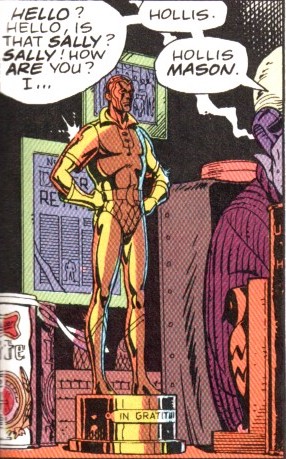 The core of the problem was that from DC’s perspective, the lesson of Watchmen could only ever be one thing: things like this sold. And within the post-Crisis reality of the direct market, what DC specifically cared about was what fans said. The simple reality is that what the vocal fans who showed up and bought Watchmen in their specialist comic book stores liked most about the book wasn’t the moving explorations of sexuality in “A Brother To Dragons”; it was Rorschach being a moody badass in “The Abyss Gazes Also.” And so this is what DC imitated.
The core of the problem was that from DC’s perspective, the lesson of Watchmen could only ever be one thing: things like this sold. And within the post-Crisis reality of the direct market, what DC specifically cared about was what fans said. The simple reality is that what the vocal fans who showed up and bought Watchmen in their specialist comic book stores liked most about the book wasn’t the moving explorations of sexuality in “A Brother To Dragons”; it was Rorschach being a moody badass in “The Abyss Gazes Also.” And so this is what DC imitated.
This, of course, was not unique to Watchmen—the kind of hard-edged and violent antihero represented by Rorschach was, to DC’s mind, part and parcel of a trend of dark and violent superhero comics that also included Frank Miller’s The Dark Knight Returns and Mike Grell’s Green Arrow: The Longbow Hunters. This, in other words, was something they already knew how to imitate, and that Moore was always one of several writers capable of providing. Indeed, in most regards Moore was always an imitator in this regard, putting his own spin on a foundation that had been laid down by Miller.

It’s easy, looking at individual comics and the aesthetic visions they contain, to fall into a sense of thinking of comics as a matter of single vision, where Watchmen, The Dark Knight Returns, and The Longbow Hunters represent an argument that noir-inflected violence for teenage boys is what comics should be in some absolute and total sense. Phrased this way, the fallacy is obvious, but even recognizing that, it’s easy to forget just how many different aesthetics coexist under the overall brand represented by the DC bullet logo.
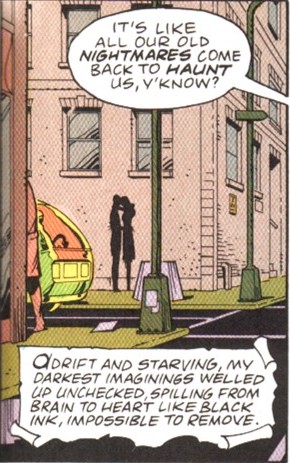 Consider January of 1987, the month that Moore finally came to the decision that he would not accept any new work from DC. In addition to Watchmen #8, in which Rorschach breaks out of prison with the help of Dan and Laurie after violently murdering his way through a number of inmates, high profile comics being released included the final issue of Legends, DC’s first attempt to duplicate the success of Crisis on Infinite Earths, two issues of John Byrne’s Superman run, and an issue of George Pérez’s Wonder Woman. In more grim and gritty terms, DC released an issue of Vigilante, with its right-wing fantasy of extrajudicial executions, and The Question, which saw Denny O’Neil putting his own spin on Rorschach’s source material, and the third installment of Frank Miller’s post-Crisis Batman: Year One relaunch. But even within the Batman line, that same month saw the release of Detective Comics #573, a goofball issue featuring the Mad Hatter, albeit one that ends with Robin being shot and gravely wounded. But DC still had at least one eye firmly situated on the past. Other titles included Infinity Inc., co-written by Roy Thomas, a twenty-year veteran of the industry who had succeeded Stan Lee as editor in chief at Marvel Comics. Sgt. Rock featured a story written by Robert Kanigher, who had forty years earlier taken over Wonder Woman following the death of William Moulton Marston. Elsewhere, industry veterans like Michael Fleisher, Len Wein, and Curt Swan were still getting work, albeit mostly on minor titles featuring licensed properties. No single and coherent sense of what comics were or how they should be prevailed—instead DC put out a variety of titles that catered to various factions within their audience.
Consider January of 1987, the month that Moore finally came to the decision that he would not accept any new work from DC. In addition to Watchmen #8, in which Rorschach breaks out of prison with the help of Dan and Laurie after violently murdering his way through a number of inmates, high profile comics being released included the final issue of Legends, DC’s first attempt to duplicate the success of Crisis on Infinite Earths, two issues of John Byrne’s Superman run, and an issue of George Pérez’s Wonder Woman. In more grim and gritty terms, DC released an issue of Vigilante, with its right-wing fantasy of extrajudicial executions, and The Question, which saw Denny O’Neil putting his own spin on Rorschach’s source material, and the third installment of Frank Miller’s post-Crisis Batman: Year One relaunch. But even within the Batman line, that same month saw the release of Detective Comics #573, a goofball issue featuring the Mad Hatter, albeit one that ends with Robin being shot and gravely wounded. But DC still had at least one eye firmly situated on the past. Other titles included Infinity Inc., co-written by Roy Thomas, a twenty-year veteran of the industry who had succeeded Stan Lee as editor in chief at Marvel Comics. Sgt. Rock featured a story written by Robert Kanigher, who had forty years earlier taken over Wonder Woman following the death of William Moulton Marston. Elsewhere, industry veterans like Michael Fleisher, Len Wein, and Curt Swan were still getting work, albeit mostly on minor titles featuring licensed properties. No single and coherent sense of what comics were or how they should be prevailed—instead DC put out a variety of titles that catered to various factions within their audience.
But in this regard Moore’s departure really did pose a problem for DC, not because they couldn’t stamp out an endless parade of violent sociopath protagonists a la Rorschach but because of the other massive success Moore had penned for them: Swamp Thing. This book, with its philosophical ambitions, grandoisely poetic narration, and sense of macabre horror was, after all, the series that established Alan Moore as a major figure in the US market. And unlike Rorschach (and more in common with the rest of Watchmen), Swamp Thing did not fit easily into a trend with other practitioners. It was still entirely singular—a comic the likes of which the American market had simply never seen before. How was DC to copy it?
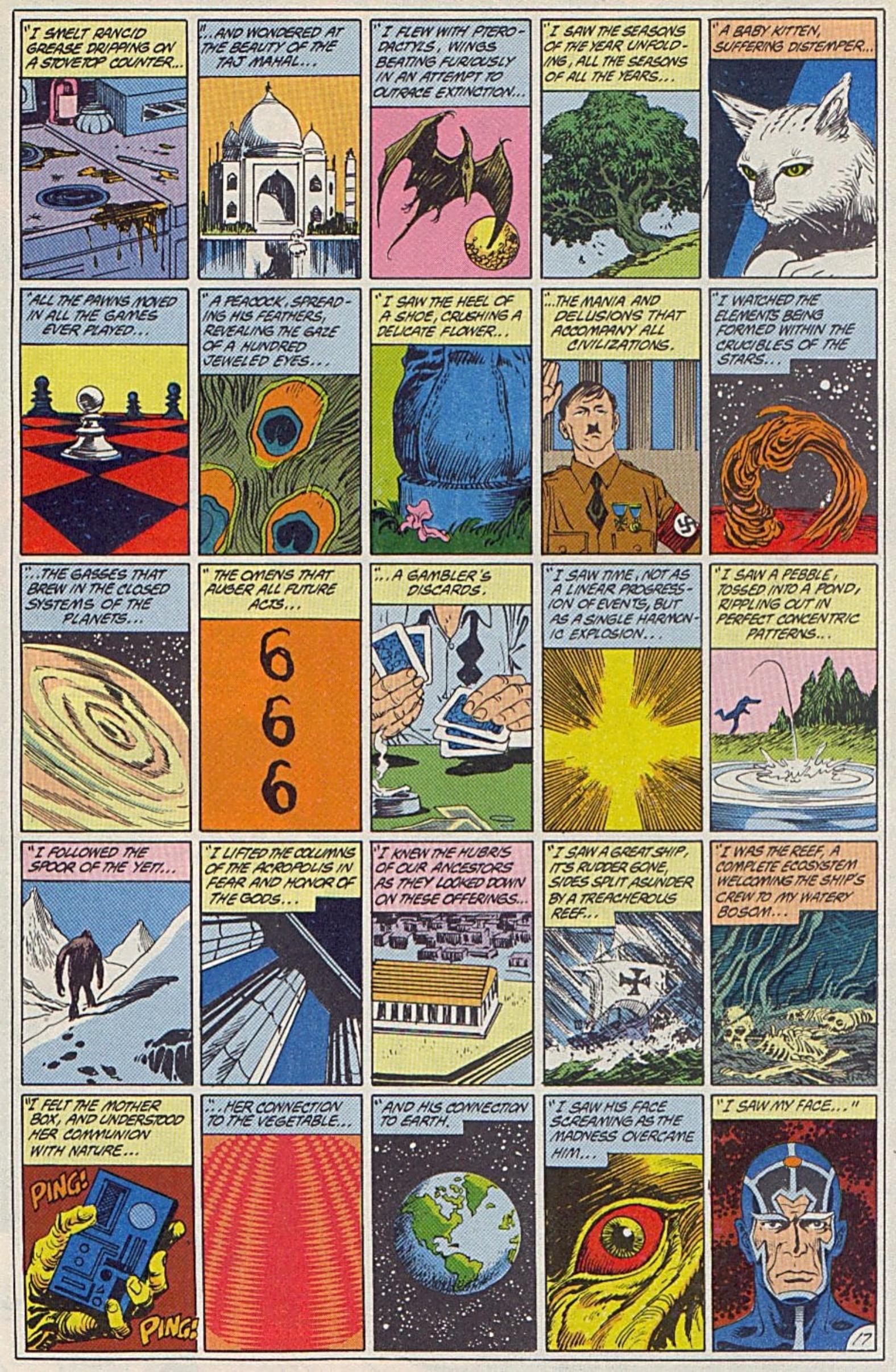
On Swamp Thing itself, at least, the answer was easy enough. DC had been working on the matter of succession over the course of Moore’s final arc playing with the far-flung sci-fi aspects of the company’s history, dropping a pair of one-offs into Moore’s arc in which two of the most obvious candidates could audition for the writer job. The first, Swamp Thing #59, was one of DC’s other January 1987 books, and featured Steve Bissette penning an old school horror issue employing Anton Arcane again. The second came three issues later in Swamp Thing #62, and saw the other primary artist of Moore’s Swamp Thing run, Rick Veitch, take over to have Swamp Thing encounter Jack Kirby’s New Gods in a heavily Jim Starlin-inspired issue that served as the last of Swamp Thing’s outer space adventures before his return to Earth the next month.
Ultimately DC decided to go with the latter option, and Rick Veitch took over the book starting with Swamp Thing #65 a few weeks after the final issue of Watchmen hit. In marked and understandable contrast to Moore, who arrived on the title by constructing a triumphant bonfire for everything Marty Pasko had done on the title in favor of a radical reinvention of the central premise, Veitch’s first issue is almost entirely focused on establishing continuity with what came before. The issue features Swamp Thing communing with the Parliament of Trees, Abby on a psychedelic trip calling back to “Rite of Spring” in which she encounters visions of Anton Arcane, her comatose husband, and even the fear demon from the first year of Moore’s run, and culminates with the reappearance of John Constantine. It is a comprehensive statement of how little anything is going to change, emphasized by the fact that Veitch was still pencilling the book along with writing it, backed by the same inker in Alfredo Alcala, the same colorist in Tatjana Wood, and the same letterer in John Costanza. And the press around the comic was unsurprisingly keen to stress the seamlessness of the transition, with Veitch talking in interviews about how he “slid into the ‘Swamp Thing style of writing’” and tried to maintain Moore’s style of visual transitions.
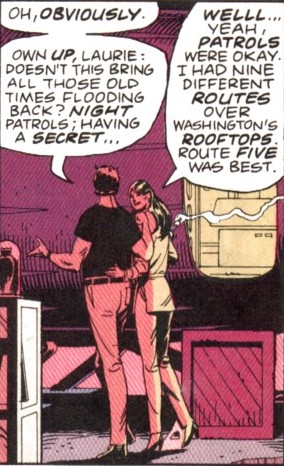 This approach largely characterizes the first couple of Veitch’s issues, sprinkled with some high-profile guest spots. Swamp Thing #66 brings back Jason Woodrue and features another psychedelia sequence for Abby, this time with a trip into hell to check in on all the people from the Sunderland Corporation that Swamp Thing killed off late in the Moore run, but also throws in a guest appearance by Batman. Issue #67, meanwhile, brings back Alan Moore’s stand-in Gene LaBostrie from “Return of the Good Gumbo” while contriving to have Swamp Thing fight midlist Batman villain Solomon Grundy and, in the final pages, at least temporarily writing John Constantine out of the story.
This approach largely characterizes the first couple of Veitch’s issues, sprinkled with some high-profile guest spots. Swamp Thing #66 brings back Jason Woodrue and features another psychedelia sequence for Abby, this time with a trip into hell to check in on all the people from the Sunderland Corporation that Swamp Thing killed off late in the Moore run, but also throws in a guest appearance by Batman. Issue #67, meanwhile, brings back Alan Moore’s stand-in Gene LaBostrie from “Return of the Good Gumbo” while contriving to have Swamp Thing fight midlist Batman villain Solomon Grundy and, in the final pages, at least temporarily writing John Constantine out of the story.
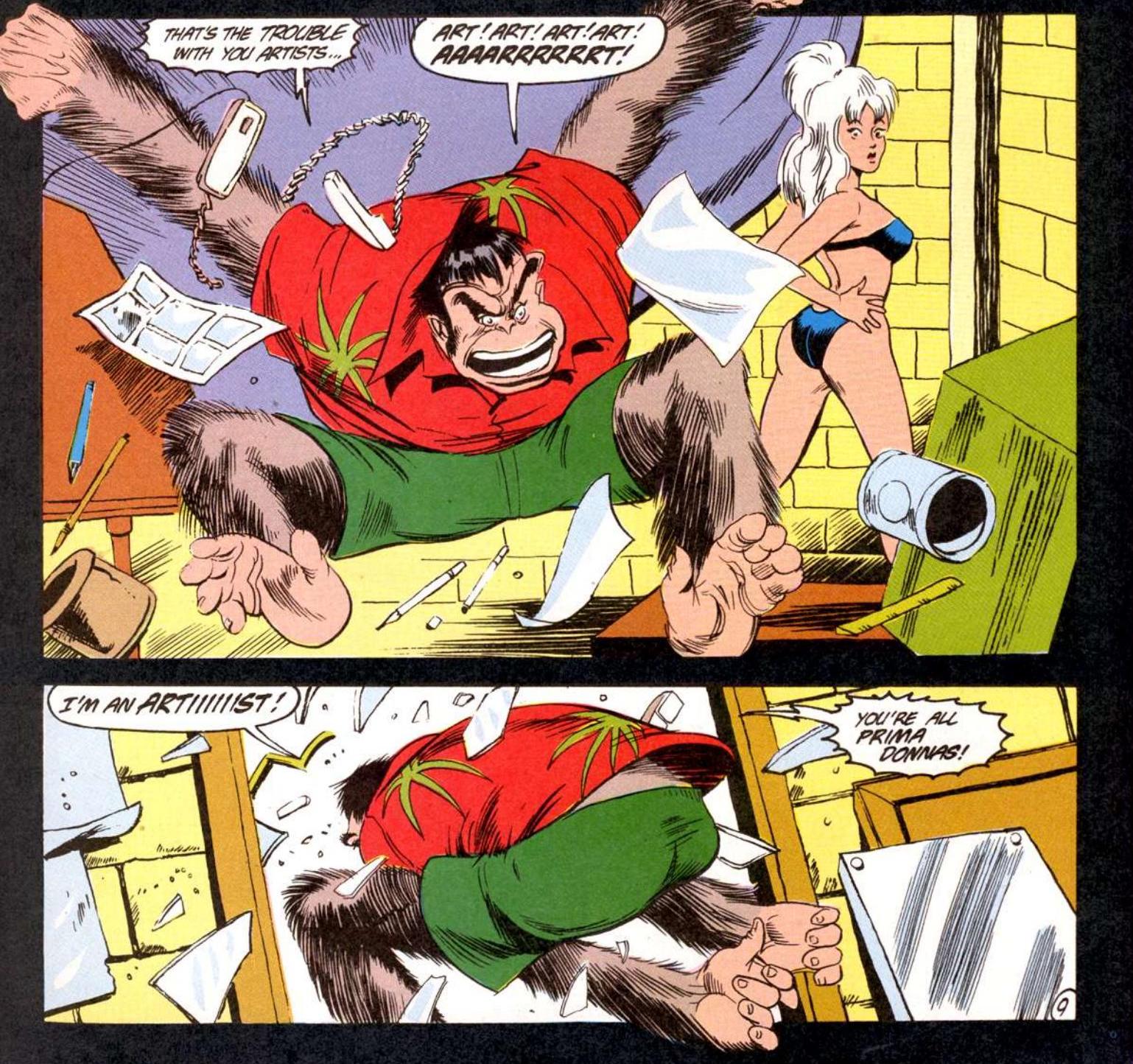
This is not to say that Veitch did not introduce his own plot elements. Swamp Thing #65 features the reveal that the Parliament of Trees believed that Swamp Thing really was dead when his consciousness fled offworld, and that they thus commenced the creation of a new elemental to take his place. They assert that the only way to restore balance is now for Swamp Thing to kill the vestigial spirit of his successor, which he refuses to do. Nor is it the case that the early months of Veitch’s run are all so focused on nostalgia for the halcyon days of three months prior. Two weeks after Veitch’s first issue DC released Swamp Thing Annual #3. Working from an underlying story hook toyed with by Moore but never developed before he decided to move on from the book, Veitch penned a ridiculously silly story in which Swamp Thing’s life intersects with the famously and bewilderingly large stable of DC gorilla characters. Featuring appearances by Angel and the Ape, Gorilla Grodd, B’wana Beast and Djuba, Congo Bill, George Dyke (the Gorilla Boss of Gotham City), Solovar, and Monsieur Mallah, the story is a madcap romp that is profoundly stupid in all of the best ways, and made it clear that Veitch had arrows in his quiver besides meekly imitating his predecessor. Nevertheless, the basic approach was clear: if you liked Alan Moore’s Swamp Thing, you’ll probably still like this one.
The reason that Veitch at least temporarily wrote Constantine out of his series three issues in was simple enough: Constantine had his own series to star in. This was given the arbitrary but vivid title Hellblazer, and was written by Jamie Delano. Delano was a fellow Northampton native and teenage friend of Alan Moore’s who remained close with him. Delano had long had an ambition to be a writer but, in his words, was instead “just fucking about, getting stoned and driving my taxi, bored and frustrated with the world and most of the people doomed to inhabit it” when Alan Moore, in an attempt to kickstart his old friend’s creative interests, offered to put him in touch with some contacts.
This led to a variety of writing gigs, most of them engineered by his friend and mentor. He took on the Night Raven text pieces in The Daredevils after Moore gave them up, then did a stint writing Captain Britain for Alan Davis to draw once Moore left that title, and finally penned a D.R. & Quinch strip for 2000 AD in which everybody’s favorite interplanetary sociopaths penned an agony aunt column. And when DC expressed interest in doing a book to pick up on the growing popularity of John Constantine, Moore was quick to give his friend another boost.
Where Delano had struggled with many of his early assignments, notably frustrating Alan Davis when they worked together on Captain Britain (Davis complained later that “Jamie had no background or pior interest in the comic form,” and claimed to have been “initially supplying plots and long story, then mutilating and reworking Jamie’s scripts.”), Hellblazer turned out to be a near-perfect fit for him. It is not that the run is a flawless classic of comics—Delano’s work has consistent deficits in plotting and is prone to failures to clearly communicate information to the reader. The practical result of this is that the big moments of his stories rarely quite land, generally feeling unearned or muddy. At various points within Hellblazer this becomes more or less of a problem, but at no point is the run entirely free of it. This means that over thirty-seven issues, Delano never produces one that straightforwardly stands up as a brilliant classic. Many are good and at worst only a handful are bad, but he is simply not the sort of writer that writes singular and imperious works of what is popularly called genius.
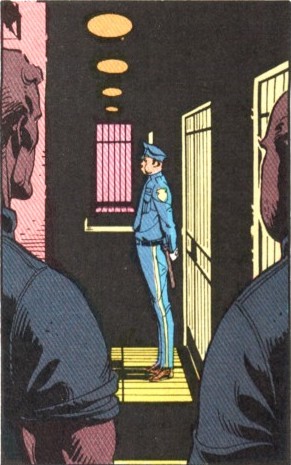
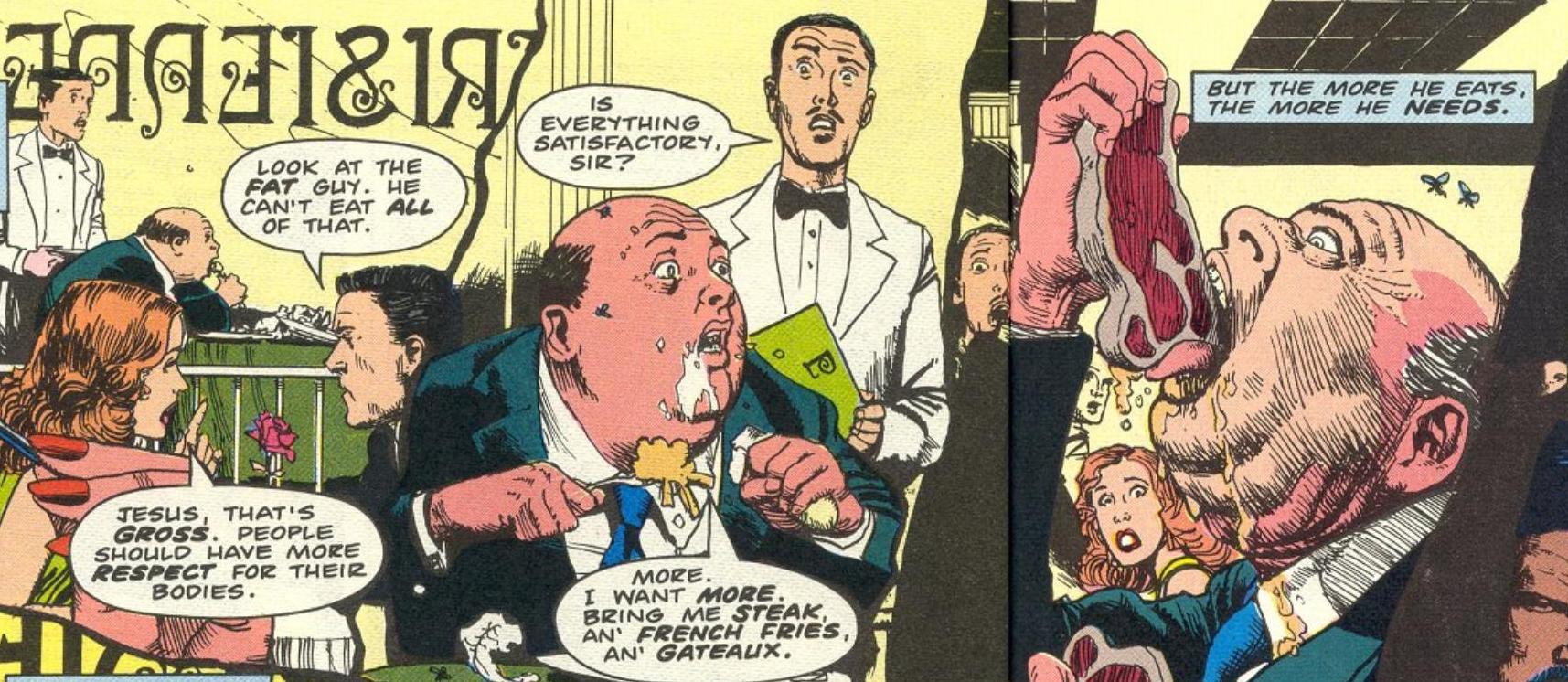
Delano’s run instead succeeds through a rigorously applied aesthetic. Delano’s Hellblazer is a work of dark horror with a furiously leftist sensibility and a gaze focused firmly on the ragged underbelly of the world. It sets out its stall in its first two issues with a story in which one of John Constantine’s friends from the oft-mentioned and ominously teased Newcastle incident shows up in his apartment having accidentally unleashed a dangerous demon named Mnemoth. The story is not without issue—a heavy reliance on dark magic from rural Sudan and a large dose of the fetishization of Haitian Vodou that was trendy in the late 80s/early 90s both ensure that it has aged poorly in key regards. But its high points still crackle with the same imperious vividness that they did in 1987. The opening three pages of issue #1, for instance, feature a man consumed by a compulsive hunger, stuffing multiple hamburgers in his mouth as he stumbles to an expensive restaurant where he begins to eat whole steaks before, overcome, he begins to grab at other diners’ meals, the table settings, and finally the other diners themselves before collapsing into an emaciated husk.
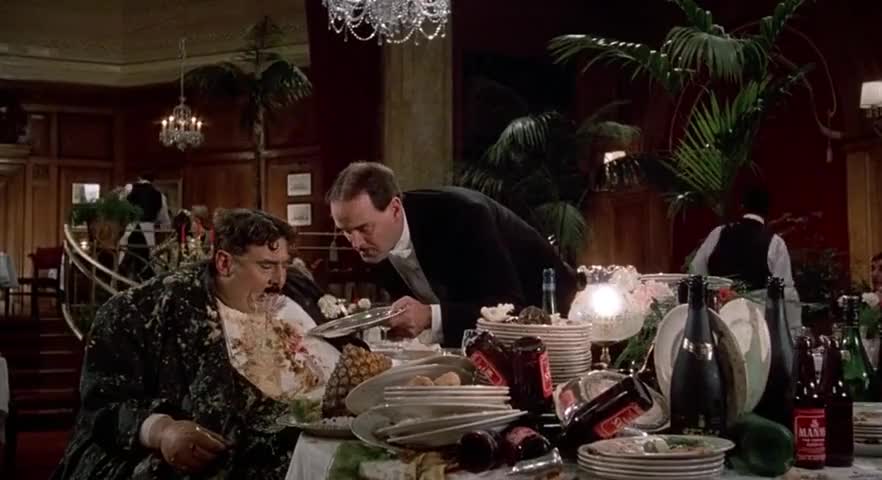
It’s a sequence of bleak and unsettling horror, taking the central image of the Mr. Creosote sketch from the then-recent Monty Python’s The Meaning of Life and inverting it into an impossible and absurd outcome played for no laughs whatsoever. Similarly, the resolution of the first story at the end of issue #2, as Constantine callously sacrifices his friend to stop the demon, a payoff that Delano plays not as a surprising twist but as the grimly inevitable and dreaded outcome built to over two issues in which it’s perfectly clear that Constantine is manipulating and using his drug-addicted friend.
But while these sequences are tremendous, there is none of the intricacy of construction or breathtaking originality that characterizes Alan Moore’s work here—none of the glistening poetry or jaw-dropping turns of phrase that set Moore apar from everyone around him. When Delano shifts into an elevated register, it’s functional but unmemorable—his captions as the man gorges himself to starvation, for instance, include a sequence where he writes, “a whole herd of burgers—hooves and all—couldn’t fill the gaping beak of the giant fledgling that cries inside him. He lumbers through the early evening streets, scattering wrappers behind him, like small carcasses. All is subordinate to his primal urge for food.” It’s evocative, but far from precisely honed, The invocation of eating hooves carries a visceral horror, but it’s undermined by the juxtaposition with “burgers,” the preparation of beef that is furthest from the carnal reality of an entire bovine carcass, and subsequently by the odd veer from mammals to birds and the oxymoron of “giant fledgling.”
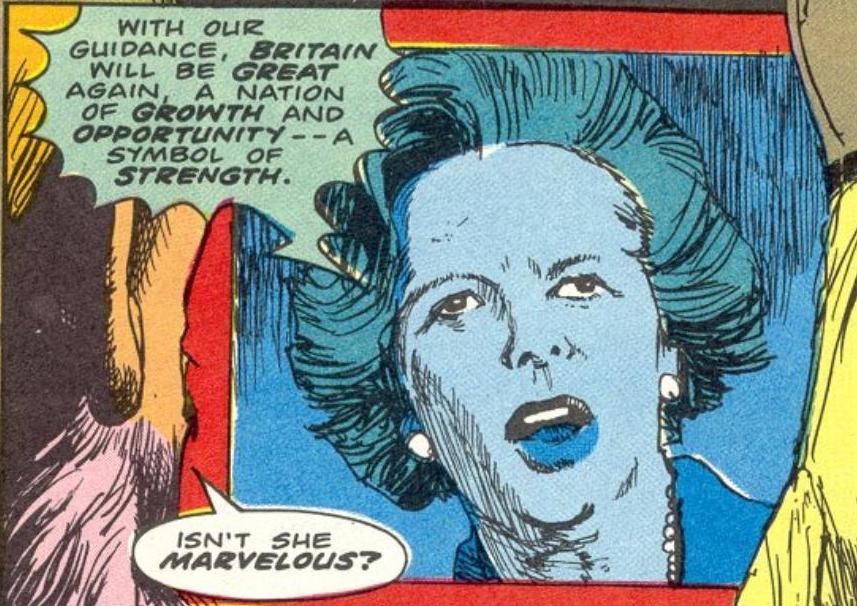
What there is, however, is an unrepentantly swaggering sense of attitude that doesn’t need a flawless execution to land. Within the early issues of Hellblazer, this is best exemplified by Hellblazer #3, which is set on the day of Thatcher’s reelection to a third term in 1987. In it, Constantine investigates the death of a bunch of yuppies and stumbles upon a demonic investment ring buying yuppy souls because the prospect of a Tory victory is creating a bull market. It’s a bitterly funny issue in which the fact that Delano never quite gets around to explaining how the price of souls is impacted by politics, reducing it to a handwave about how “the political climate’s perfect for them. Profit is definitely the top god of the eighties—for monetarism, read Satanism. I bet the upwardly mobile have been queuing to sell their souls,” is almost entirely irrelevant in the face of the fact that demonic investors making loans with the souls of yuppies as collateral and then violently repossessing them is such a brashly hilarious and pointed concept that it would be hard work to do it poorly. Likewise, the plot beat in Hellblazer #6 in which Constantine convinces a demonic assemblage built out of the bodies of a gang of racist skinheads by pointing out that one of their arms has an Arsenal tattoo and another has one supporting Chelsea, resulting in them violently tearing themselves apart is such a great bit of satire that the larger plot it fits into doesn’t really matter. The reader forgets the bits that don’t make sense and instead vividly remembers the clever concepts, which, in point of fact, a generation of comics fans have.
 This is not damnation with faint praise; it’s simply a different way of doing things than Alan Moore’s approach. And it has its merits: nobody has ever accused Jamie Delano of “strutt[ing] into view with his blue cock on proud display” or “beg[ging[ for our attention at every page turn.” Delano’s Hellblazer would be diminished if it were as ostentatious and insistent on having its genius recognized as Moore’s best work. It works because it is present, immediate, and furious, not because it is seized with mad ambition. And more to the point, it works because this suits John Constantine, who, in Delano’s conception at least, is not a figure of grandiose and well-worked plans. It is impossible to imagine Delano’s John Constantine engaging in the vast manipulation of Swamp Thing over the course of the American Gothic arc of Swamp Thing. Delano’s Constantine is a man constantly at the end of his rope, only ever succeeding with his last and most desperate scheme. He is a self-destructive alcoholic who at best pushes people away, at worst treats them as objects to be used in his games. A book of ragged fury is what suits this, and it’s frankly a good deal more entertaining than a monthly slab of Moore’s obnoxiously clever master manipulator would be.
This is not damnation with faint praise; it’s simply a different way of doing things than Alan Moore’s approach. And it has its merits: nobody has ever accused Jamie Delano of “strutt[ing] into view with his blue cock on proud display” or “beg[ging[ for our attention at every page turn.” Delano’s Hellblazer would be diminished if it were as ostentatious and insistent on having its genius recognized as Moore’s best work. It works because it is present, immediate, and furious, not because it is seized with mad ambition. And more to the point, it works because this suits John Constantine, who, in Delano’s conception at least, is not a figure of grandiose and well-worked plans. It is impossible to imagine Delano’s John Constantine engaging in the vast manipulation of Swamp Thing over the course of the American Gothic arc of Swamp Thing. Delano’s Constantine is a man constantly at the end of his rope, only ever succeeding with his last and most desperate scheme. He is a self-destructive alcoholic who at best pushes people away, at worst treats them as objects to be used in his games. A book of ragged fury is what suits this, and it’s frankly a good deal more entertaining than a monthly slab of Moore’s obnoxiously clever master manipulator would be.
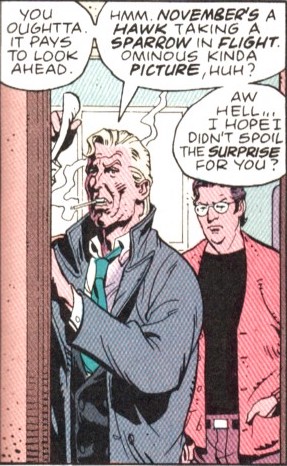 This, then, was DC’s initial attempt, as conceived by Moore’s two handpicked successors, were these two comics: a surprisingly competent imitation of Moore, and a burst of dark and ragged fury. Neither were quite adequate, giving DC the sort of bankable auteur figure that Moore had become. And even as they debuted, efforts were ongoing to find someone who could serve as a true successor. Karen Berger made a series of trips to the UK in part to scout new talent, including one in February 1987 the month after Moore made up is mind to stop working for DC. These trips would bring many familiar names to the US market, most obviously Grant Morrison and Neil Gaiman, whose debuts came about a year and eighteen months into Veitch’s run respectively, and who each had brief intersections with Delano’s Hellblazer and, in Gaiman’s case, Veitch’s Swamp Thing.
This, then, was DC’s initial attempt, as conceived by Moore’s two handpicked successors, were these two comics: a surprisingly competent imitation of Moore, and a burst of dark and ragged fury. Neither were quite adequate, giving DC the sort of bankable auteur figure that Moore had become. And even as they debuted, efforts were ongoing to find someone who could serve as a true successor. Karen Berger made a series of trips to the UK in part to scout new talent, including one in February 1987 the month after Moore made up is mind to stop working for DC. These trips would bring many familiar names to the US market, most obviously Grant Morrison and Neil Gaiman, whose debuts came about a year and eighteen months into Veitch’s run respectively, and who each had brief intersections with Delano’s Hellblazer and, in Gaiman’s case, Veitch’s Swamp Thing.
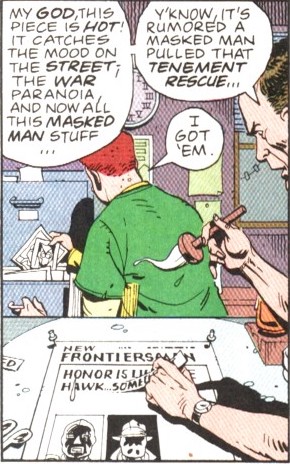
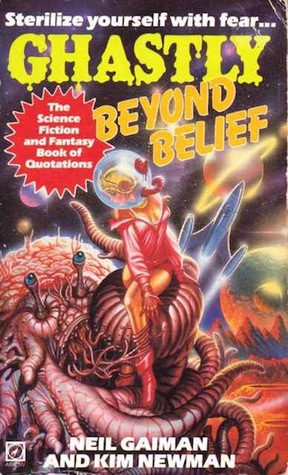
(A comprehensive introduction to Neil Gaiman, who serves as a major combatant in the War and indeed one of its primary victors, is beyond the scope of this particular moment in its history. In short, however, Gaiman befriended Alan Moore after sending him a copy of Ghastly Beyond Belief, a compilation of absurd quotations from science fiction, which delighted Moore.
In the course of their friendship, Gaiman served as a minor research assistant on Watchmen starting with issue #3, when he was able to identify for Moore where the line “shall not the judge of all the Earth do right” originated so that it could be used as the issue’s epigraph. He subsequently contributed quotes for issues #7 [“I am a brother to dragons, and a companion to owls. My skin is black upon me, and my bones are burned with heat.”] and #8 [“On Hallowe’en the old ghosts come about us, and they speak to some; to others they are dumb”] and the Rameses quote used by Ozymandias in the text of issue #12. For this Gaiman was gifted the original art for one of the pages of Dan’s nuclear sex dream in issue #7 and given a thanks credit in the trade paperback alongside Pat Mills, Joe Orlando, and Mike Lake.

Moore also instructed Gaiman in how to write a comics script, guiding him through two short trial pieces, a John Constantine story in which Constantine confronted the terrible monster that had grown in his fridge while he was off helping Swamp Thing stave off the apocalypse, which Moore was amused by but felt the ending didn’t work, and a Swamp Thing story entitled “Jack in the Green” featuring a medieval version of the character, which Moore liked better, and which Gaiman ultimately used as an audition piece along with his still in progress Dave McKean collaboration Violent Cases when Karen Berger came calling in early 1987. [The story eventually saw print in the 1999 Midnight Days collection with newly commissioned art by Moore’s Swamp Thing team of Bissette, Totleben, Wood, and Costanza.] Between the strength of his work and a recommendation from Moore, Gaiman was swiftly snapped up by Berger.
Gaiman’s US debut was a Black Orchid miniseries with his frequent collaborator Dave McKean, followed a few weeks later by his first ongoing series, Sandman, about which much more later. That debuted the same week as Swamp Thing #82, the first issue of Veitch’s final Swamp Thing arc. With Veitch on his way out, Berger decided to hand the book over to Gaiman and Hellblazer writer Jamie Delano, who would each script six issues a year. This plan spectacularly failed to work out, but at the time of its failure Gaiman had already been contracted for Swamp Thing Annual #5, where he penned two stories. The main story was entitled “Brothers,” and saw Gaiman reviving the deeply obscure 1960s character of Brother Power the Geek.
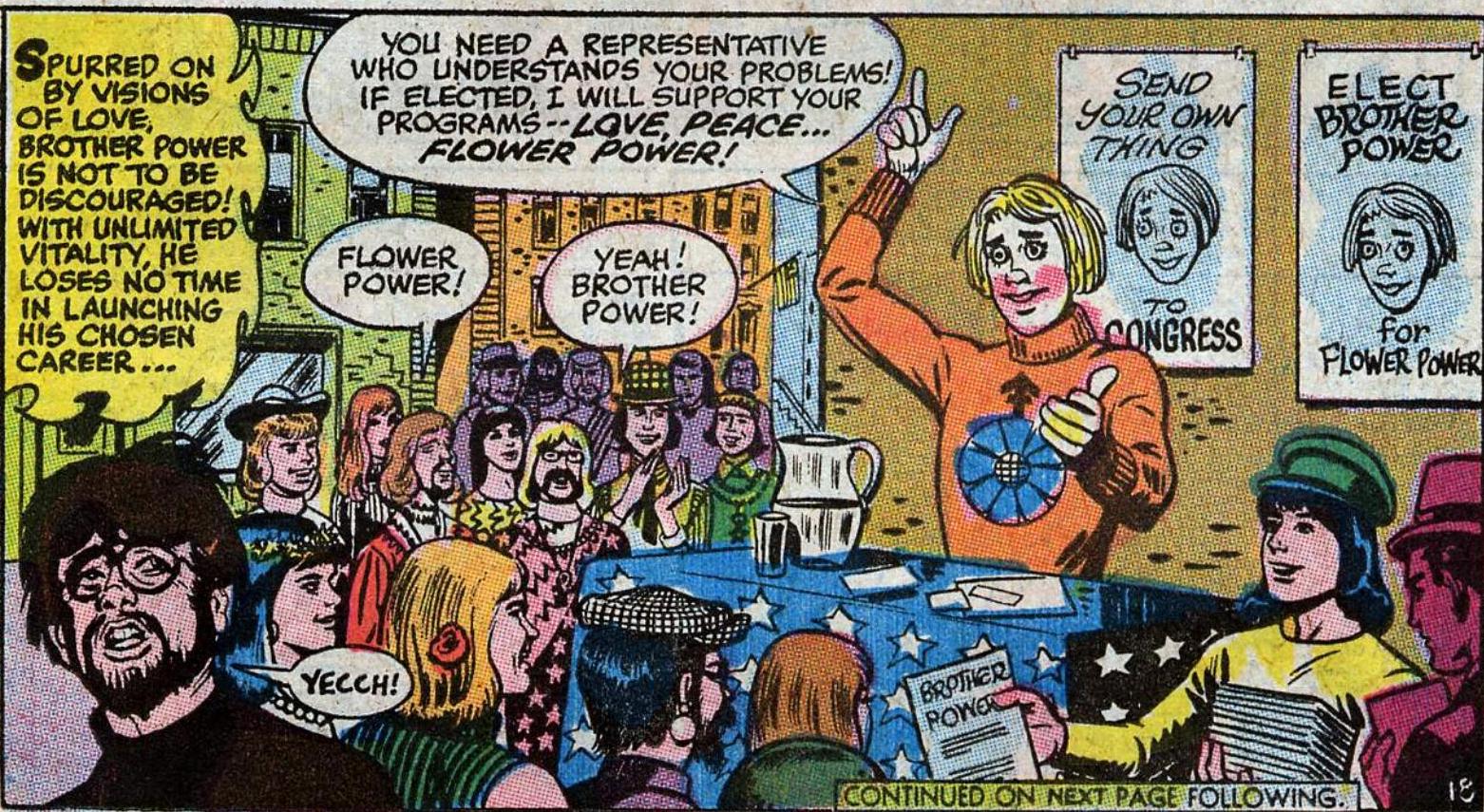
Brother Power the Geek was the subject of a two-issue series in 1968 by Joe Simon with uncredited art work by Al Bare, once described by Alan Moore as “one of the most brain-blisteringly awful comic books ever produced by human beings.” A tailor’s dummy animated by a lightning strike, Brother Power was essentially an effort to cash in on the hippie subculture—after being animated he’s raised by a group of hippie squatters who teach him to speak and send him to school because “he’ll have a bad trip without an education.” The comic straddles a strange line between affection and contempt for and the hippies. They’re straightforwardly the good guys, helping rescue Brother Power when he’s kidnapped by the Psychedelic Circus and chained up as part of their freakshow, but they’re also clearly mocked—they do so after proclaiming that “we’ve got to turn on and be like activists, man! Like, charge in with our trusted lances” and then attacking with a mop and a shovel. But this ambivalence was not enough to spare the comic from the wrath of the legendarily unpleasant Superman editor Mort Weisinger, whose hatred for hippies was apparently so intense that he single-handedly convinced publisher Jack Leibowitz to cancel it after two issues, leaving Brother Power stranded on a cliffhanger ending in which he was launched into space.

And this is where Gaiman picked him up twenty-one years later, with the satellite upon which Brother Power is trapped crashes into Tampa despite the efforts of Firestorm to prevent it. Amidst the chaos and carnage emerges Brother Power, who ambles around terrifying people for a bit until Chester, the hippie character who’d been clanking around Swamp Thing’s supporting cast since about halfway through Alan Moore’s run, finally talks him down. Along the way Brother Power’s origin is retconned into being a failed “puppet elemental,” thus tying him loosely into the larger Swamp Thing mythos. But for the most part the story is about hippie subculture, its failure and decline, and Chester’s nostalgia for it. Its dramatic center is a pair of conversations Chester has, the first with a black-suited government operative who scornfully explains that he used to be a hippie, but that he woke up with one day in 1968 and “had malnutrition and venereal crabs and I dodn’t know the real names of the last half dozen chicks I’d balled… I looked for my buddies and found that some of them had slipped out of sight. Freak-outs had become crackups and breakdowns and write-offs.” Chester meekly protests that although he was too young to be there, he’s talked to people and knows there was magic to it, and that people still believe, but the agent scoffs, pointing to the failure of any of the things dreamed of by the hippie movement to manifest, then dismisses Chester, saying “I saw all the flower children gone tow eed and seed and thorn. Get out of here, hippie. You make me sick.” From here, however, Chester encounters Brother Power, who he persuades to “cool it with the big bods” and instead wander around and try to “discover the real America,” on the way confessing his knowledge that his romantic relationship with Liz Tremayne can’t possibly endure.
It’s a reasonably effective story that demonstrates a deft understanding of how to use the medium, although it’s clear exactly where that understanding came from. The story is littered with narrative caption boxes repeating a standard formula: “There was a man who tried to do more good than bad, born out of his time.” “There was a woman who had been damaged, tentatively trying to recreate herself through love.” “There was a man who was no longer a man. His humanity had been burnt away long since; and the heart that blazed inside him was a heart of flame, if it was a heart at all.” The debt to Alan Moore’s use of the Justice League early in his Swamp Thing run, where he introduced them with “There is a house above the world, where the over-people gather. There is a man with wings like a bird. There is a man who can see across the planet and wring diamonds from its anthracite. There is a man who moves so fast that his life is an endless gallery of statues…” Gaiman admits as much, noting that “the voice in the caption boxes in ‘Brothers’ is me doing a good-natured if not entirely successful Alan Moore impression. It seemed appropriate: it had been his comic, and he had given it a voice.”
But the debt to Moore runs much deeper than just nicking his caption boxes. Gaiman’s basic approach to the story—taking a character that had at best been forgotten and at worst was widely regarded as a joke and revamping it for the present day by finding a new interpretation of its origin—is a carbon copy of what Moore did with Swamp Thing himself. And this, in turn, is what Moore had done with Marvelman back in Warrior, the gig that put him on Len Wein’s radar in the frist place. This is not a coincidence; it was exactly what Karen Berger was looking for when she went to the UK to take pitches. Gaiman recounts their 1987 meeting: “So I did my pitch for Phantom Stranger and they said, “Weirdly enough, Grant Morrison was in this morning, he did a pitch for Phantom Stranger too. Yours is really good, his is really good—unfortunately we’ve got this Paul Kupperberg piece, which is not very good but it is what he is. So you can’t do that.’” So Gaiman proceeded to pitch more characters, both relatively mainstream ones like Green Arrow and Black Canary and deep cut obscurities like Nightmaster, Klarion the Witch Boy, and Cain and Abel before finally getting to Black Orchid, a character Berger didn’t even know who was. This was, in other words, the specific format that writers imported from the UK were expected to hew to. It was what Grant Morrison would do with Animal Man, what Peter Milligan would do with Shade, the Changing Man, and, albeit to a far more radical extent, what Gaiman did on Sandman.
But it is this last example that is ultimately most revealing. The project upon which Gaiman’s reputation and career was built was the one in which he strayed furthest from the tidy “revise some old crap no one cares about into a mature readers title” brief that he and everyone else in the initial post-Moore wave of imports was given. An ability to copy the formula worked out by Alan Moore may have been what got Gaiman, Morrison, and their contemporaries their first gigs in American comics, but those who thrived did so by copying a more fundamental skill of Moore’s: doing something no one had ever thought of before.)
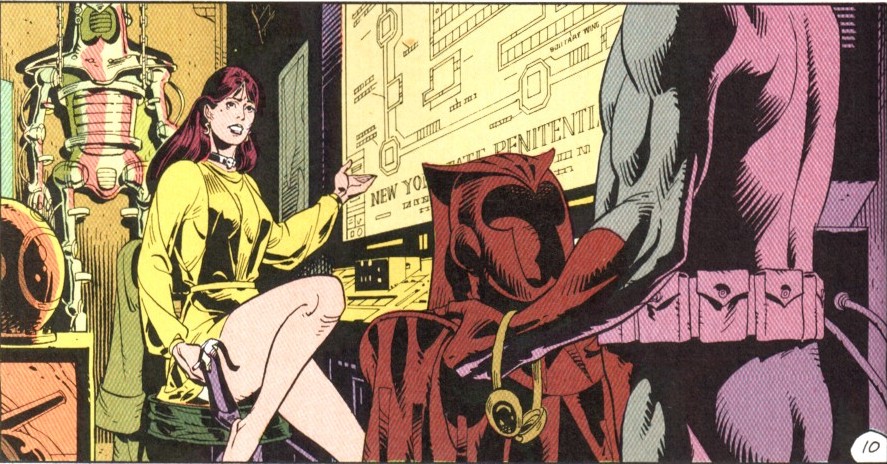 Until then, Veitch and Delano had to fill the gap, defining the brand of “the stuff DC does that’s like Alan Moore.” For Veitch’s part, he began a storyline exploring the consequences of Swamp Thing’s unborn successor. In it, the sprout (as it is often referred to) attempts to incarnate in a number of bodies and, for a variety of reasons, fails. This is the nominal reason for the Swamp Thing/Solomon Grundy fight in issue #67—the sprout attempts to bond with Grundy and ends up being drawn into Grundy’s madness and becoming violent.
Until then, Veitch and Delano had to fill the gap, defining the brand of “the stuff DC does that’s like Alan Moore.” For Veitch’s part, he began a storyline exploring the consequences of Swamp Thing’s unborn successor. In it, the sprout (as it is often referred to) attempts to incarnate in a number of bodies and, for a variety of reasons, fails. This is the nominal reason for the Swamp Thing/Solomon Grundy fight in issue #67—the sprout attempts to bond with Grundy and ends up being drawn into Grundy’s madness and becoming violent.
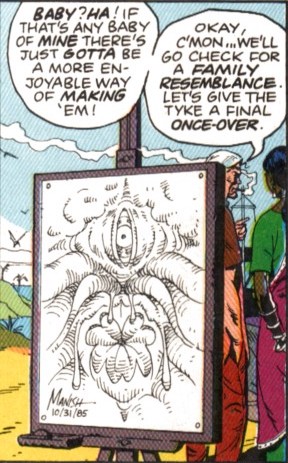 (Towards the end of 1989, in a gap in the midst of Delano’s The Family Man arc, Hellblazer #25 and #26 were released, telling a two-issue story penned by Grant Morrison with art from David Lloyd. Morrison was by this point nineteen issues into Animal Man, ten into his Doom Patrol run, and perhaps most crucially, a month past the release of Arkhm Asylum. He was, in other words, well-established as a hot new talent at DC, while for Lloyd this was his first post-V for Vendetta project. It was, in other words, not a random tossed-away fill-in issue, but a team-up of two leading lights of the by then clearly in progress British Invasion of comics who had never worked together before. [Indeed, this is Morrison and Lloyd’s sole collaboration.]
(Towards the end of 1989, in a gap in the midst of Delano’s The Family Man arc, Hellblazer #25 and #26 were released, telling a two-issue story penned by Grant Morrison with art from David Lloyd. Morrison was by this point nineteen issues into Animal Man, ten into his Doom Patrol run, and perhaps most crucially, a month past the release of Arkhm Asylum. He was, in other words, well-established as a hot new talent at DC, while for Lloyd this was his first post-V for Vendetta project. It was, in other words, not a random tossed-away fill-in issue, but a team-up of two leading lights of the by then clearly in progress British Invasion of comics who had never worked together before. [Indeed, this is Morrison and Lloyd’s sole collaboration.]
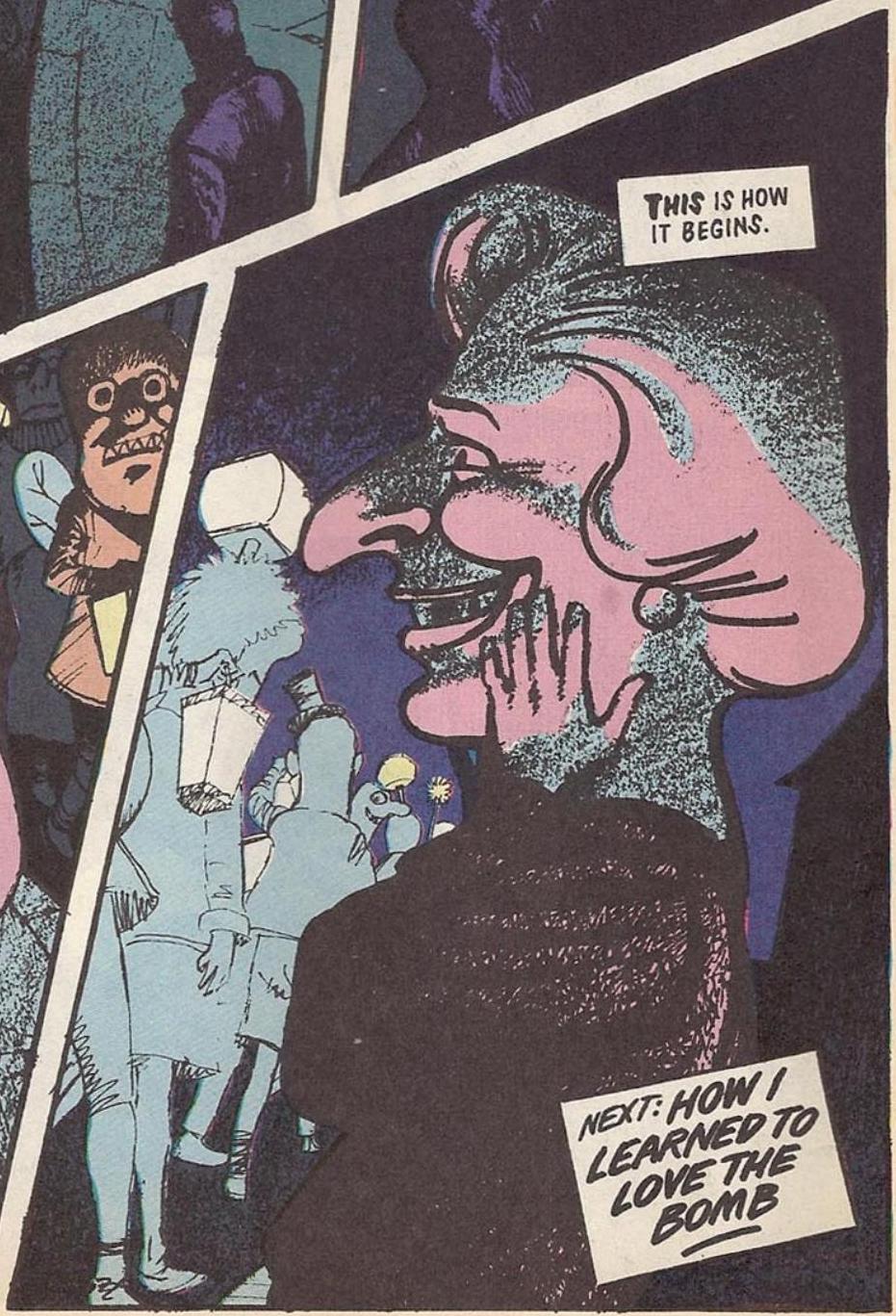
This was at least a mildly ironic assignment for Morrison, whose comments on Hellblazer around the time were generally backhanded—in a 1989 interview in Fantasy Advertiser he’d proclaimed, “ I like Hellblazer except when it’s being ‘moral’, like in the skinhead issue,” while in an interview conducted a few months before the arc came out he said, “I like Hellblazer. I think it got a bit tedious, but it’s picking up again.” He also asserted in the same interviewer that that he was “trying to get Constantine into a dress” in his arc, but that he doubted DC editorial would approve it. In practice, although the comic features John Constantine donning a Margaret Thatcher mask and getting swept away into a dark carnivalesque revelry, he sticks to trousers the whole time.

The story, however, was not nearly so comedic as this account suggests. Instead it is a piece of moody dream theater in which the carnival is treated as a surviving remnant of pagan ritual—an upside-down world in which repressed desires emerge from the shadows to take hold as the rational, everyday world takes its turn at being repressed. Lloyd’s art, which, as the carnival takes over the narrative, stops existing in the tight rigidity of square boxes offering variations on the nine-panel grid that he used across V for Vendetta, his panel borders instead beginning to skew and tilt, turning the pages into an unsettling and off-kilter reverie, uses stark and solid blocks of pastel color to dress events in a sense of fitful unreality.
Unsurprisingly for his first real attempt at an unadulterated horror comic, Morrison turns to his own primal horrors. The comic is not quite set in Scotland, but instead in a fictional small village called Thursdyke that Morrison locates simply with a caption box reading “North” [although the first panel image of the early warning radar system at RAF Fylingdales and a bit of dialogue about being “twenty miles from Ravenscar” puts events a little more than an hour and a half south of Newcastle]. The town is down the hill from an American missile base, which, in the wake of Thatcher’s shutdowns of the collieries, has become the town’s primary economic resource.
Constantine comes to town on the invitation of Una, an old friend from his post-Newcastle incarceration in a mental asylum who has suggested he might want to see the carnival parade. The night of the parade, however, Professor Horrobin, a scientist at the base goes deep within the caverns of the base, explaining as he does about “the old stories of mythical kings and giants asleep beneath the earth.” He proclaims that he intends to wake the buried kings within mankind, and that he’s set off a bombardment of “microwaves set to resonate with the ten Hz frequency of the human brain. All those unconscious desires and fears and repressed longings. Set free.”
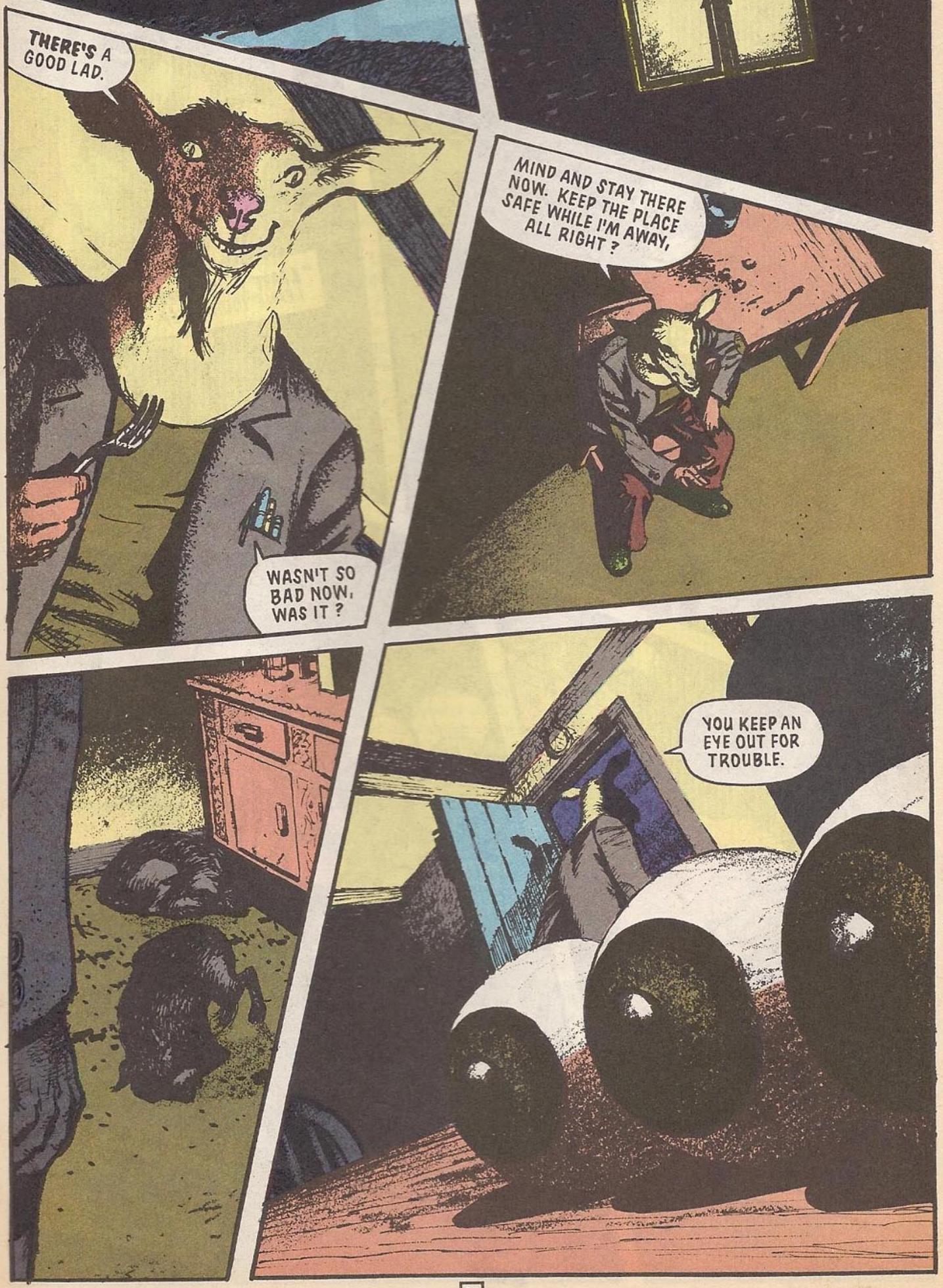
Within the town there is a mad rush. A man in a baby costume murders his wife for loving their child more than him, then begins to cut his infant child’s fingers off. Another in a dog costume gouges out his dogs’ eyes and sets them to keep watch. And as the first issue ends, Constantine, sucked into the maelstrom, slips on a Margaret Thatcher mask and joins the mob.
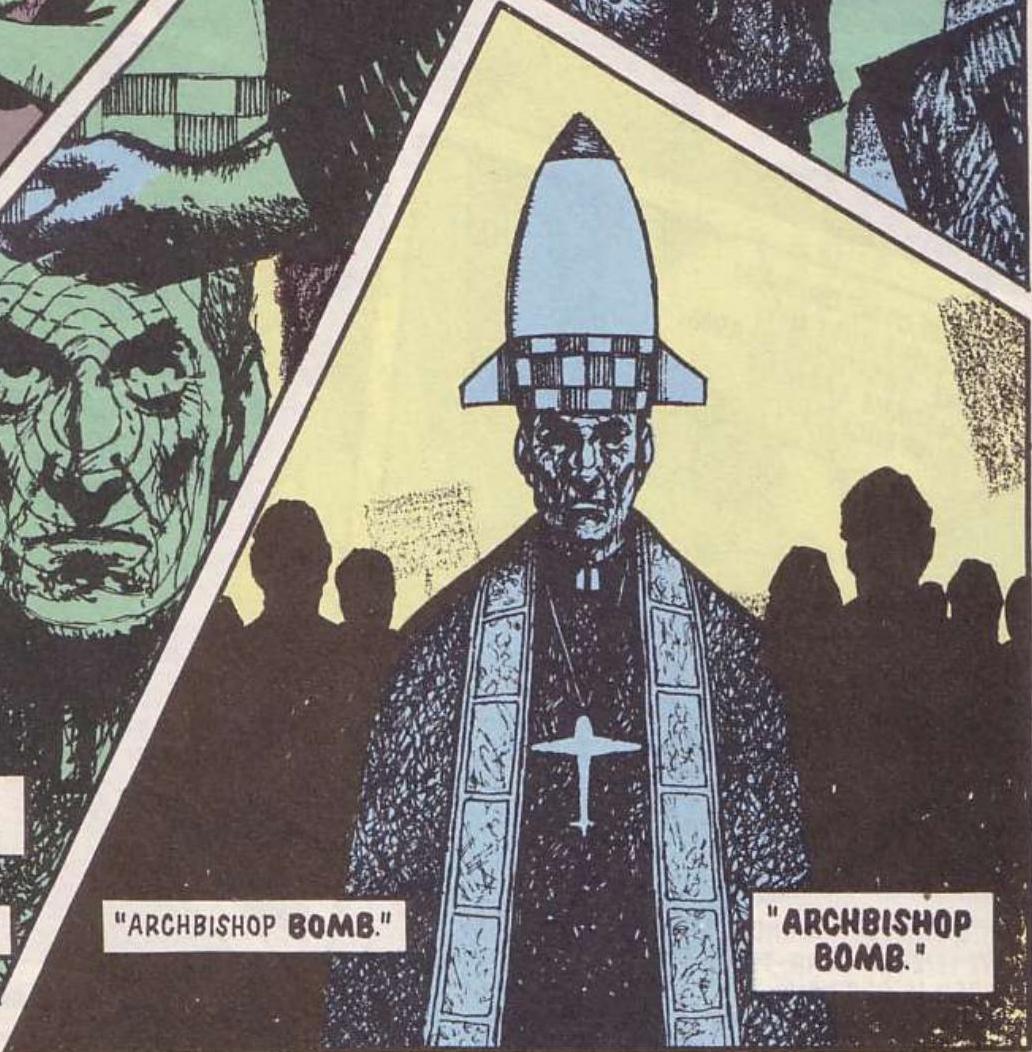
In the second part, meanwhile, the village parson, an old anti-nuclear activist named Bayliss is seized by the mob, held down, dressed, made up and proclaimed the Archbishop Bomb. He leads the mob to storm the RAF base, where it becomes clear that Horrobin’s machine is just an empty box, and that whatever is happening is not caused by anyone. Una, meanwhile, rescues Constantine, who realizes that with its economic collapse under Thatcher the town has psychically died, and that what remains clings to the bomb, which “gives their lives meaning, like a new religion, and now they’ve gone to meet God.” Constantine rushes to the base, but too late, as Archbishop Bomb has stolen one of the jets and drops a bomb onto the village just before the crowd was about to burn Una as an offering to the Nuclear God.
It is, in other words, a quintissentially Morrisonian story, merging his fascination with the unconscious mind [the links between underground complexes and the unconscious are going to reappear in The Invisibles] and his horror at the bomb. And unmediated by the later optimism with which he would uncritically proclaim Superman to be the categorical answer to the atomic bomb, Morrison’s sense of it as a terrifying death god feeding on the corpses of economically devastated towns is an object of genuinely uncanny horror. Indeed, it is a front on which he, in this outing at least, is largely able to outdo Moore, whose horror of the bomb, while self-evidently genuine, always feels more like an intellectual revulsion at the idiocy of men who would create such a weapon than an emotional gut reaction of fear. Morrison, meanwhile, offers a sense of the bomb that feels rooted in a real fear, reaching back to his childhood memories of anti-nuclear pamphlets depicting the blasted and hellish horrors of a post-annihilation world, of his father’s activist friends being disappeared by mysterious men in black, and of how he “used to imagine god was a skeleton and the thunder was the sound of his big, black iron train.”
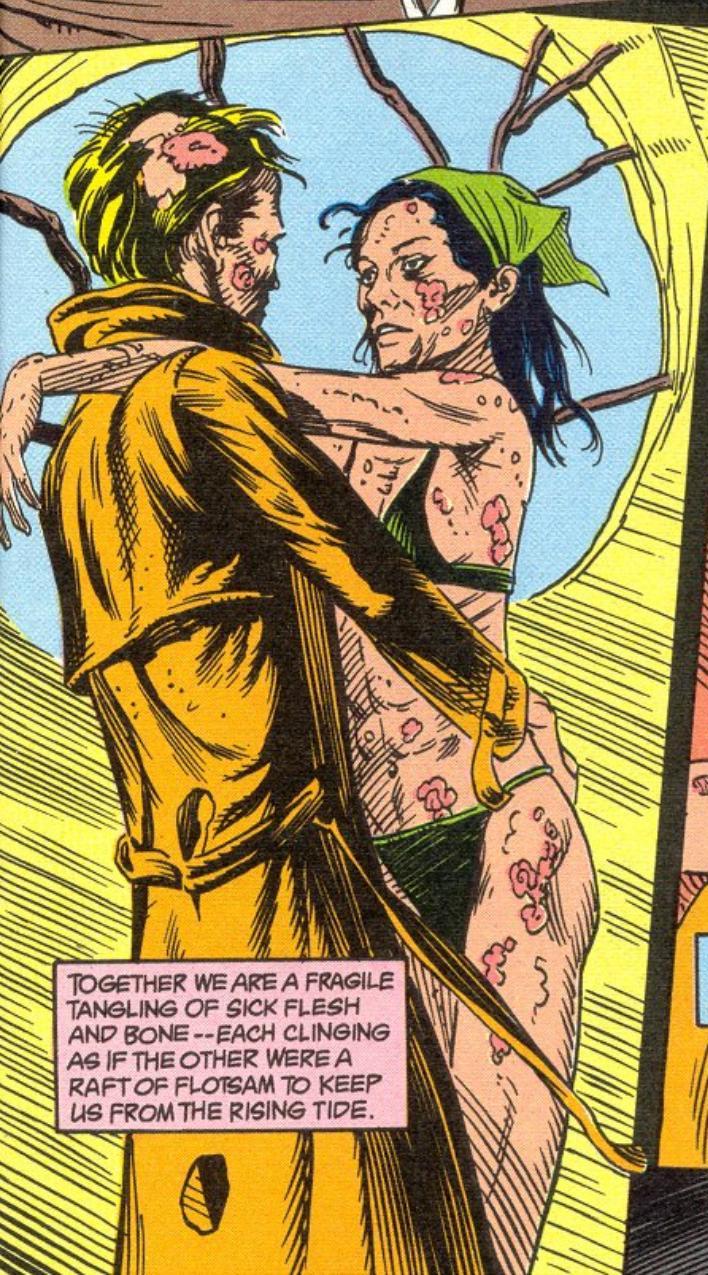
But it’s also a story that slots very smoothly into Delano’s Hellblazer. Its sense of socially conscious horror is squarely in line with what Delano was doing with the book, as is the focus on the abandoned edges of British society under Thatcher. Indeed, Delano did his own anti-nuclear issue of Hellblazer just over a year prior in Hellblazer #13, an issue that is largely consumed by Constantine having a nightmare of nuclear annihilation. Delano’s focus, however, is split between a sense of body horror at images of radiation poisoning—at one point, Constantine dreams of embracing a woman and Delano describes “an emptiness of bruising, sobbing flesh—a body softness wetly smothering a calcium crumbling of teeth”—and a more abstracted concern with the idea of a species-level future and of evolution and mutation. Morrison goes in neither direction, and indeed does not need to retreat into the hyper-symbolic rhetoric of a dream sequence for his horror, finding it instead in the everyday experience of living in a nuclear-threatened world.
This is undoubtedly a strength in Morrison’s work compared to Delano’s. And the comparison is in a larger sense a useful one. Like Delano, Morrison’s strengths often do not lie in plotting or clarity. Indeed, his Hellblazer arc demonstrates that—after the reveal that Horrobin’s machine is actually just an empty box Horrobin somewhat randomly kills himself and the other scientist in a pretty flagrant “well these guys aren’t part of the resolution so let’s write them out of the story” move. More broadly, the “why” of the story never quite adds up—there’s a plot point of using music to block out the effects of the carnival that doesn’t really square away with the idea that there’s not actually a signal producing any of this. And more broadly still, if one widens the lens to Morrison’s career as a whole a tendency to not quite offer enough explanation to fully sell what he’s doing.
And yet Morrison is an appreciably more successful and for that matter more skilled writer than Delano. Much of this comes down to the fact that even if Morrison can be untidy in his execution, his work offers a conceptual coherence that Delano’s often does not. Delano’s nuclear story is composed of essentially arbitrary components. Its title, “On the Beach,” is borrowed from the famed 1959 post-apocalyptic film, but for Delano this is wholly literal—Constantine falls asleep on a beach and has a nightmare about the nucelar apocalypse there. And this dream takes place in a story that’s elsewhere about Constantine’s childhood memories and his propensity for nightmares—both interesting topics, but not ones with an obvious and direct relationship to nuclear armageddon. Morrison, on the other hand, has taken care to ensure that his ideas go together: nuclear apocalypse, post-industrial collapse, and the idea of a sublimated death drive centered on the atomic bomb as a new god makes sense in a way that beaches, nuclear power, evolution, and Constantine’s loss of childhood innocence don’t. Delano also chooses nuclear power as his focus [his hook being that there’s a nuclear power station near this beach], unlike Morrison, who focuses on the more straightforward horror of the atomic bomb.
This is not to say that the ways Morrison is tailoring his style to fit within what Delano is doing don’t improve the story. Morrison is not usually this grounded in social reality—he has no love for Thatcher’s Britain, but his disdain for it is not an animating passion the way it is for Delano. Doing his take on Delano pushes him to do things he wouldn’t have done in other circumstances, and this implicit collaboration is every bit as electrifying as the actual one between Morrison and Lloyd.)

.jpg)
For the most part, Veitch uses this structure to create a number of horror scenarios as the sprout tries and fails to take on a number of hosts. For instance, over the course of issues 68 and 69 it tries to merge with Alan Bolland, a KKK member thrown out of the military for assaulting a superior officer whose favorite film is Taxi Driver and who idolizes James Earl Ray. This results in a crazed and violent Swamp Thing who lurches around spouting advertising jingles, initially staggering out of a swamp towards a derelict truck muttering “you… all that you can be… all the things you do… you keep America working… this beer’s for you!” and later smashing cars on the highway as he explains, “Around here quality is job one. We’ve produced the best cars and light trucks designed adn built in America for six years running. SO HAVE YOU DRIVEN A GODDAMN FORD lately?” It’s a surreal and macabre plot beat reminiscent of the stuff Delano was doing over on Hellblazer, savvily playing with the trope of right-wing militia-style terrorism years before it really picked up steam in the popular consciousness. And after the sprout is separated from this body, it provides one of the highlights of Veitch’s run, a long smoldering subplot in which two sleezebag TV producers are trapped in a car driven by the now vacated body of the would-be Swamp Thing being sped across the country as he babbles a collage of advertising jingles at them.
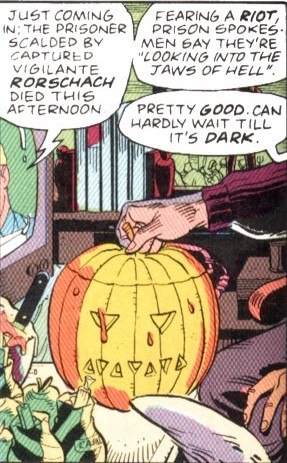 (Midway through writing “Brothers” for Swamp Thing Annual #5 Gaiman learned of Veitch’s premature departure from the title and the unpleasantness surrounding it. He and Delano were asked to come onto the book early, but refused in solidarity with Veitch. Gaiman, however, still had to finish the annual, which would now come out in the three month gap between issues that Veitch’s departure had created. And so he started in on the ten page backup feature about the Floronic Man, to be drawn by a pre-Hellboy Mike Mignola. The resulting story, “Shaggy God Stories,” sits at a strange midpoint between its original intention and its new context. On the one hand, angry on behalf of his colleague, he changed the focus of the story, emphasizing Woodrue’s status as a fallen angel and cheekily naming the venus flytrap he carries to see the Parliament Milton. On the other, the story kept the basic focus it had always had, offering a collection of ominous teases for Gaiman’s now never to take place run.
(Midway through writing “Brothers” for Swamp Thing Annual #5 Gaiman learned of Veitch’s premature departure from the title and the unpleasantness surrounding it. He and Delano were asked to come onto the book early, but refused in solidarity with Veitch. Gaiman, however, still had to finish the annual, which would now come out in the three month gap between issues that Veitch’s departure had created. And so he started in on the ten page backup feature about the Floronic Man, to be drawn by a pre-Hellboy Mike Mignola. The resulting story, “Shaggy God Stories,” sits at a strange midpoint between its original intention and its new context. On the one hand, angry on behalf of his colleague, he changed the focus of the story, emphasizing Woodrue’s status as a fallen angel and cheekily naming the venus flytrap he carries to see the Parliament Milton. On the other, the story kept the basic focus it had always had, offering a collection of ominous teases for Gaiman’s now never to take place run.
The nature of this run is largely mystery for the simple and obvious reason that Gaiman never actually took the job and so never worked it out in any detail. Nevertheless, several fragments of what might have been exist: a couple of quotes from Gaiman, a planning document entitled “Notes Towards a Vegetable Theology,” and, of course, “Shaggy God Stories” itself. Of these the quotes are the most specific, vague teases of what might have been that they are. The first comes from a 1989 interview, where he hinted at having had plans for Jason Woodrue that involved him “was getting back to being Woodrue, the Rue of the Wood, and probably on a much bigger scale, a much nastier scale. It would have been fun, but again it didn’t happen. I probably would have brought back Black Orchid in there. I don’t know, because as I said, it never got that far.” The second comes in the introduction to “Shaggy God Stories” in the 1999 Midnight Days collection, where Gaiman describes how his run would have “began with the Wolves of the Woods padding out of the forests, thorns on their feet instead of claws.” But as Gaiman notes in the 1989 interview, “it really hadn’t even gotten to the plotting stages.”
“Notes Towards a Vegetable Theology” offers a broader perspective on Gaiman’s potential Swamp Thing ideas, but is in turn far less focused on the actual question of narrative than either of his two cryptic teases. The piece is described as “an unpublished essay,” but it is more accurate to call it a pitch document—something akin to Moore’s “Interminable Ramble” on Twilight of the Superheroes or the Watchmen character breakdowns reprinted in the Absolute edition. Indeed, the comparison to Moore is revealing, as Gaiman is undertaking a very specifically Moorean project here. Just as Moore described his Swamp Thing Annual four years earlier as an attempt to “roughly map out the DC supernatural universe,” “Notes Towards a Vegetable Theology” seeks to “align the various vegetable set-ups within the DC universe, and throw in a few things to make it fun and codifiable.”
That said, Gaiman’s approach is demonstrably different from Moore’s. None of Moore’s publicly released pitch documents, for instance, begins with a lyrical musing in narrative form that starts by quickly recapping Genesis and the opening of Paradise Lost before noting “There was a garden—that much is certain. And in the garden, the first man and the first woman tasted forbidden fruit and were cast out into the world. Their children were a gardener—the first murderer, a slaughterer of animals—and the first victim; the stories continue from there. Did this happen once, or many times? On this planet or another? At the end of time, or, in an infinite inhabited universe, is this happening forever until the last day? On this, as with so many other things, secrets are kept, and mysteries are held.”
There’s a lot going on here, including a deep cut DC reference transitioning from a veiled discussion of Cain and Abel to a reference to secrets and mysteries, The House of Mysteries and The House of Secrets having been a pair of 70s horror anthologies hosted by DC’s versions of the characters. [These ideas, at least, Gaiman would end up using in Sandman instead.] But there’s also a characteristically Gaimanesque attempt to frame all of this in terms of stories and the diversity thereof, switching from Genesis to Norse mythology and the existence of Yggdrasil.
Gaiman moves forward to defining specific Earth-based nature spirits, starting with Gaea, who Gaiman politely suggests should not be equated with the Wonder Woman character or indeed personified at all. Below Gaea, Gaiman positions a number of categories of entities, beginning with the plant elementals, which Gaiman, in a typically mythological move, rechristens the Erl-Kings. As a female counterpart to this he proposes the May Queens, suggesting that their number includes Black Orchid, the pre-Crisis Thorn, and Poison Ivy, who he posts as being “a May Queen that went rotten—like Solomon Grundy is an Erl-King gone rotten.” Beyond these he posits the existence of Dryads, which are “free-floating consciousnesses within the green” that can manifest on Earth in plant form, and Forest Lords, which are the rulers of specific forests. In neither of these cases does Gaiman give any examples [although he makes reference to the pre-Crisis version of the Dryads, an extra-dimensional species from the Silver Age Atom comics from which Jason Woodrue originated], nor were the ideas picked up on by anyone in the way he laid them out.
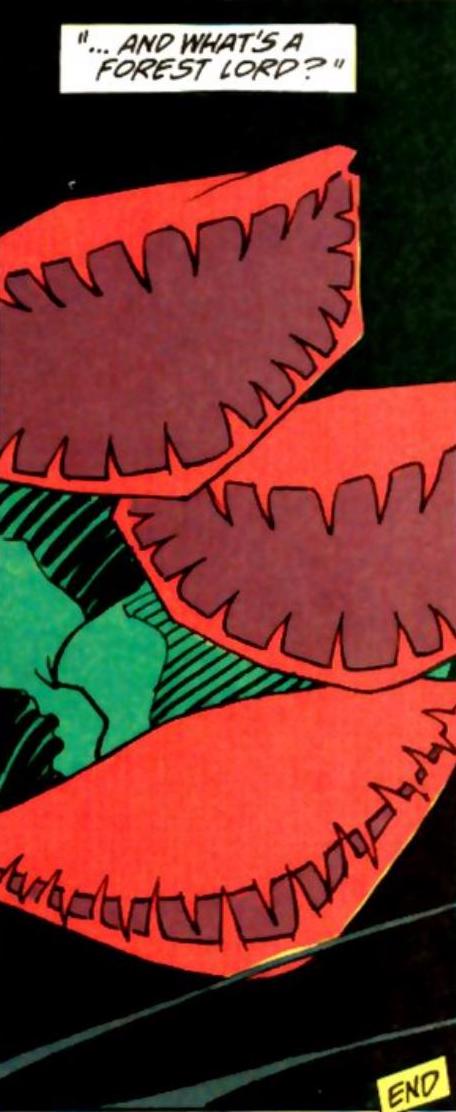
This leaves “Shaggy God Stories” itself. The story is a simple enough one at ten pages—Jason Woodrue, accompanied by a venus flytrap he bought and named Milton, journeys to visit the Parliament of Trees. There he makes a confused but impassioned speech in which he accuses the Parliament of meddling with humanity in order to give them religion. The Parliament declines to answer, offering only the cryptic warning: “beware the Forest Lords, Woodrue. They turned your mind once.. They can do so again. And beware the corruption of Matango.” The strip ends with a perplexed Woodrue, offended at his dismissal, wandering off trying to find Milton, who he has in fact left besides the Parliament, and whose flytrap mouths smile menacingly at the mention of Matango and the Forest Lords.
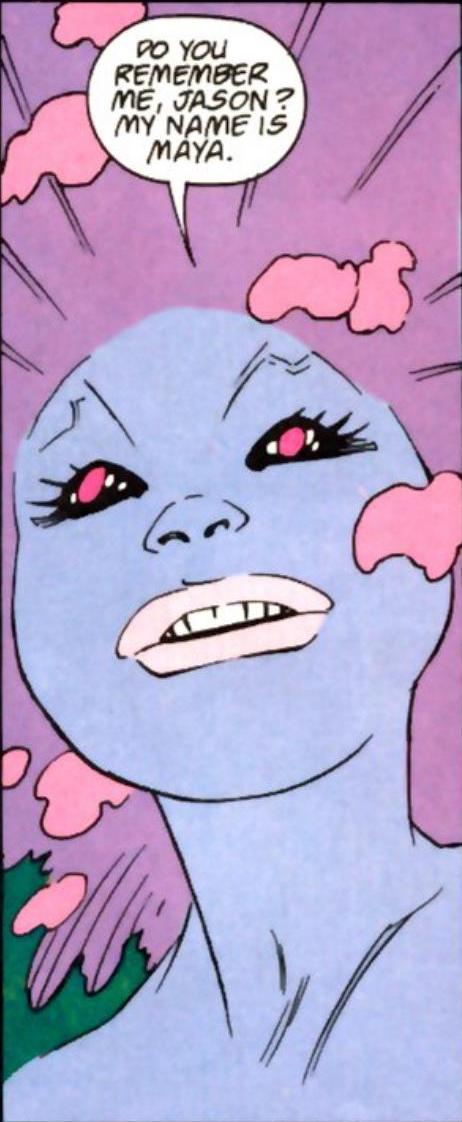
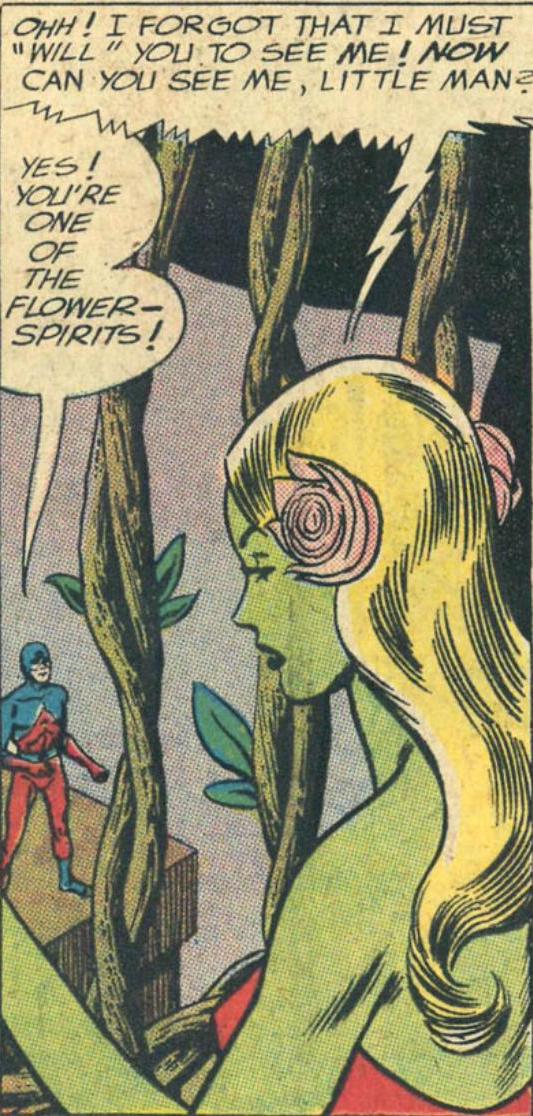
In addition to this reference to the Forest Lords, Gaiman works in several other key phrases of his vegetable theology—the Parliament’s mouthpiece refers to them as “the haven of the Erl-Kings,” for instance, and on his way there Woodrue encounters a Dryad named Myra, a reworking of a pre-Crisis character tied into his origin. [He also has Woodrue offer a version of his musings on the possible links between the Tree of Life in Genesis and the Norse Yggdrasil.]
It is far from clear that all of this represents Gaiman’s actual plans. In particular, Woodrue’s speech, which has him accusing the Parliament of having been responsible for creating virtually every major world religion is likely to be Gaiman taunting DC over the circumstances of Veitch’s departure. Much of the rest feels like little more than raiding “Notes Towards a Vegetable Theology” for concepts without developing them further. A few guesses can be hazarded—it’s easy enough to see how the warning of the corrupting influence of the Forest Lords [who Gaiman speculates in “Notes Towards a Vegetable Theology” once led an attack on humanity that was repelled by a previous Erl-King, and who he suggests might have prompted Woodrue’s actions at the start of Moore’s Swamp Thing run] could turn Woodrue into the big villain suggested in the 1989 interview. And it’s an easy enough leap from the Forest Lords to the “Wolves of the Forest.” But all of this is speculation.
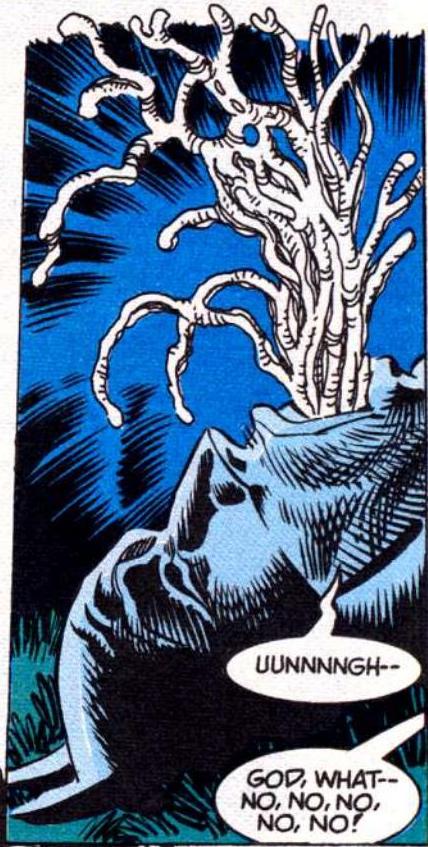
In any case, very little of this was actually picked up on in practice. Doug Wheeler, the scab who ultimately succeeded Veitch, picked up on the mention of Matango, who had previously been teased at the end of the Steve Bissette-penned Swamp Thing Annual #4, which otherwise offered a retelling of Moore’s Superman/Swamp Thing story “The Jungle Line” with Batman and a version of the cordyceps fungus in place of the Kryptonian Bloodmorel. Wheeler developed him into an elemental that was long ago corrupted by the fungal powers of the Grey. This plot made fleeting use of the phrase “forest lords” as well, but imagined them as an interplanetary entity that “seeded the planets with the potential for life,” and was very bad. Certainly it was not what Gaiman intended, save perhaps for the plot point of Matango being associated with fungus, that having been at least broadly set up in Swamp Thing Annual #4, although Bissette left room for him to be any sort of elemental of decay. Past that, however, nothing is known, and the idea of Neil Gaiman’s Swamp Thing must remain merely speculative.)
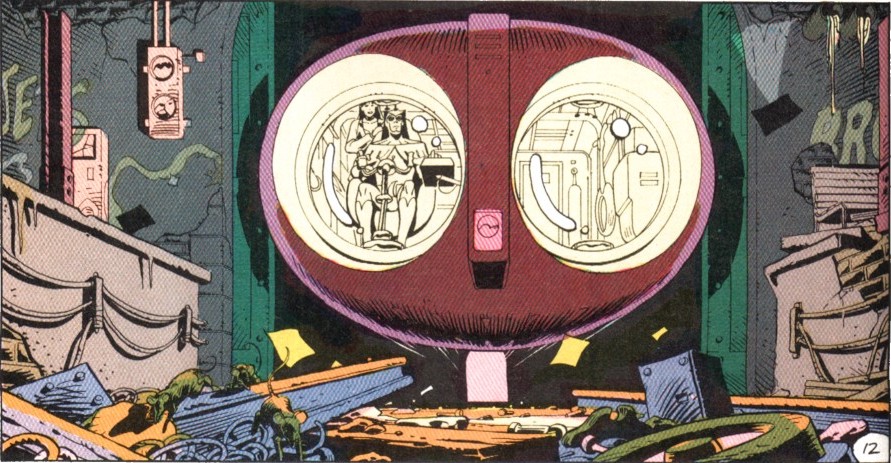

Subsequent issues start to run the concept into the ground a bit—the next issue features Gary Holland, a superstitious businessman with a sense that he’s about to die in a plane crash, which a returning John Constantine attempts to ensure in order to get the sprout properly birthed and resolve the mounting spiritual crisis only to have Swamp Thing unwittingly pull the rug out from under him by helping dispatch the souls to heaven. After that comes one of Veitch’s more effective issues, titled “Gargles in the Rat Race Choir,” and built out of twisting double page spreads with idiosyncratic reading orders traced by a series of tensely paranoid narration captions from Alden Hollandaise, an office drone at the Sunderland Corporation responsible for a scheme involving repurposing nuclear waste into fertilizer. This time it’s John Constantine that nixes things, deciding that he’s unwilling to let this guy become the next elemental and preventing Swamp Thing from guiding the sprout into him. It’s an effective enough issue with some solid formalist bona fides, even if the riffs on Alec Holland’s name start to feel ridiculous.
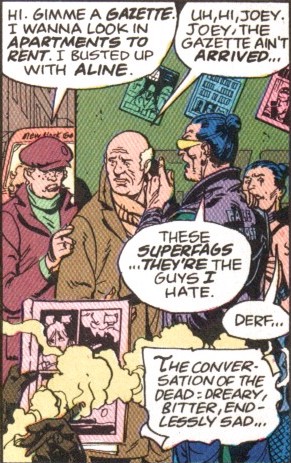 (Following Grant Morrison’s two issue stint, Berger opted to give her other hot new prospect a run-out on Hellblazer. Coming out midway through the A Doll’s House arc of Sandman, Neil Gaiman’s “Hold Me” is an efficient demonstration of exactly why he was such a hot prospect. A ghost story in twenty-four pages, it is a moving and inventive triumph of a one-shot that feels instantly like a perfect embodiment of everyone’s instinctive idea of what Hellblazer should be.
(Following Grant Morrison’s two issue stint, Berger opted to give her other hot new prospect a run-out on Hellblazer. Coming out midway through the A Doll’s House arc of Sandman, Neil Gaiman’s “Hold Me” is an efficient demonstration of exactly why he was such a hot prospect. A ghost story in twenty-four pages, it is a moving and inventive triumph of a one-shot that feels instantly like a perfect embodiment of everyone’s instinctive idea of what Hellblazer should be.
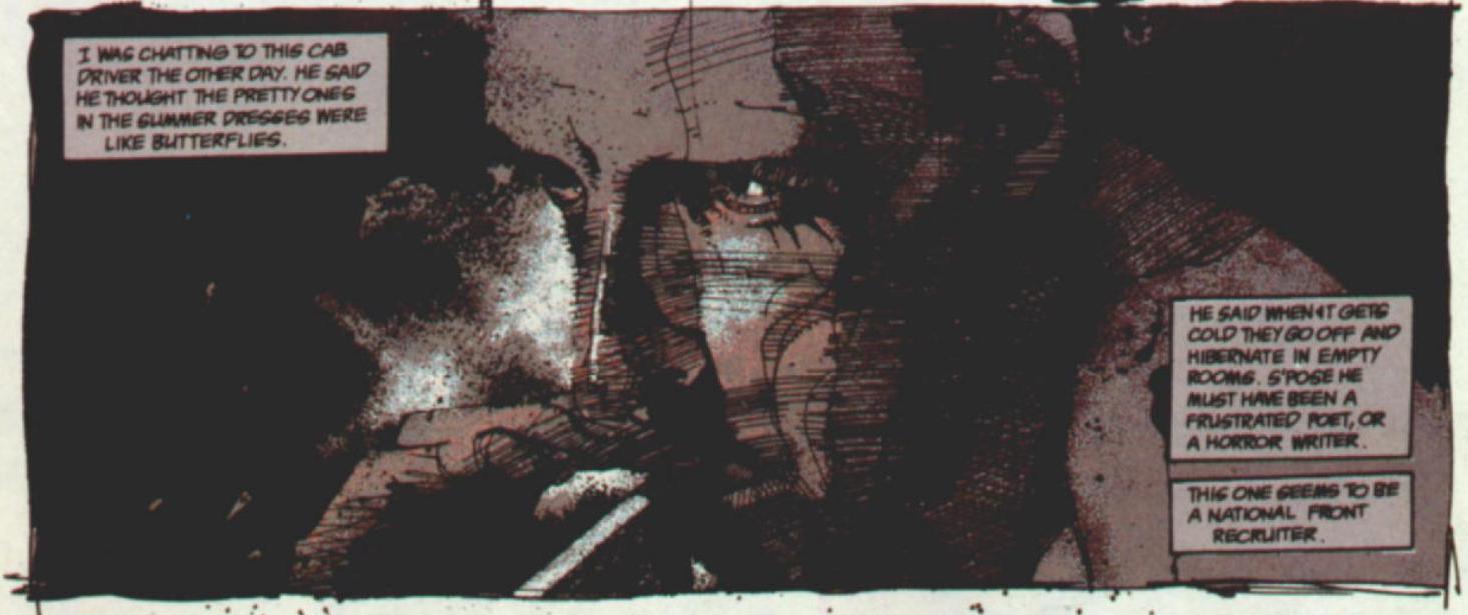
On the one hand, like Morrison’s two issues, it fits smoothly into the tone of Jamie Delano’s larger run. For one thing, it features art from Dave McKean, who did the covers of the first twenty-one issues of Hellblazer, and whose vivid but abstract depictions of their contents were an essential part of the darkly striking aesthetic of those comics. His interior art is clearer and more representational. Like David Lloyd’s art in the two issues previous, it consists of little more than a jet black line and an ink wash. But where Lloyd’s art is open and suffused with a rainbow of pastels, McKean’s panels are vast shadows pooling around small caches of light in which the scratchy characters huddle. The color palette, applied by Daniel Vozzo after McKean flew to the US to show precisely what he wanted, is muted in the extreme—washes of greying blues and purples with only a few scratches of red for subtle yet effective emphasis. The similarities to the dark, dense hatching of those early John Ridgway issues is pronounced, but McKean pushes the style even further into a sort of comic book expressionism, distorted and ominous.
Gaiman also takes care to ground his story in the plot of Delano’s run. The inciting incident for the plot is Constantine attending a memorial for Ray Monde, the gay friend of his who died protecting Zed from the Resurrection Crusade back in Hellblazer #7. More to the point, however, Gaiman adopts the politics and attitude of Delano’s work. Gaiman is in no way a writer who shies away from politics [it’s difficult to become a majro combatant in a magical war for the soul of Albion while shying away from politics] , but he is rarely as prone to the bluntness involved in having John Constantine storm out of a taxi after the driver goes on about how “old Enoch, he had the right idea. Should have sent them all back to Bongo-Bongo land” and then, when the driver asks for a tip, tell him to “get a new mind. The one you’ve got now is narrow and full of crap.” Indeed, Gaiman is arguably going a bit too far here, turing Constantine into an tweely liberal quip machine out of an Aaron Sorkin teleplay instead of someone with a sense of compassion who is at home in the foresaken margins of society and so is adept at serving as the reader’s guide within them.
Elsewhere in the issue, however, Gaiman does far better. He builds up to the actual conflict by having Constantine run into a homeless man outside the pub where the memorial is being held, talking to him about how he hates the cold once the autumn settles in and about how he got beat up by a couple drunk yuppies the other night. “Seems like there didn’t used to be so many homeless on the streets,” Constantine muses. “I gave him a quid and some cigarettes, and he seemed pathetically grateful.” And indeed, the story as a whole is built out of Gaiman’s own experience visiting a friend, noticing a bad smell coming from a neighboring apartment, and hearing the story of a homeless man who had broken into it in the winter and died, undiscovered until the spring.
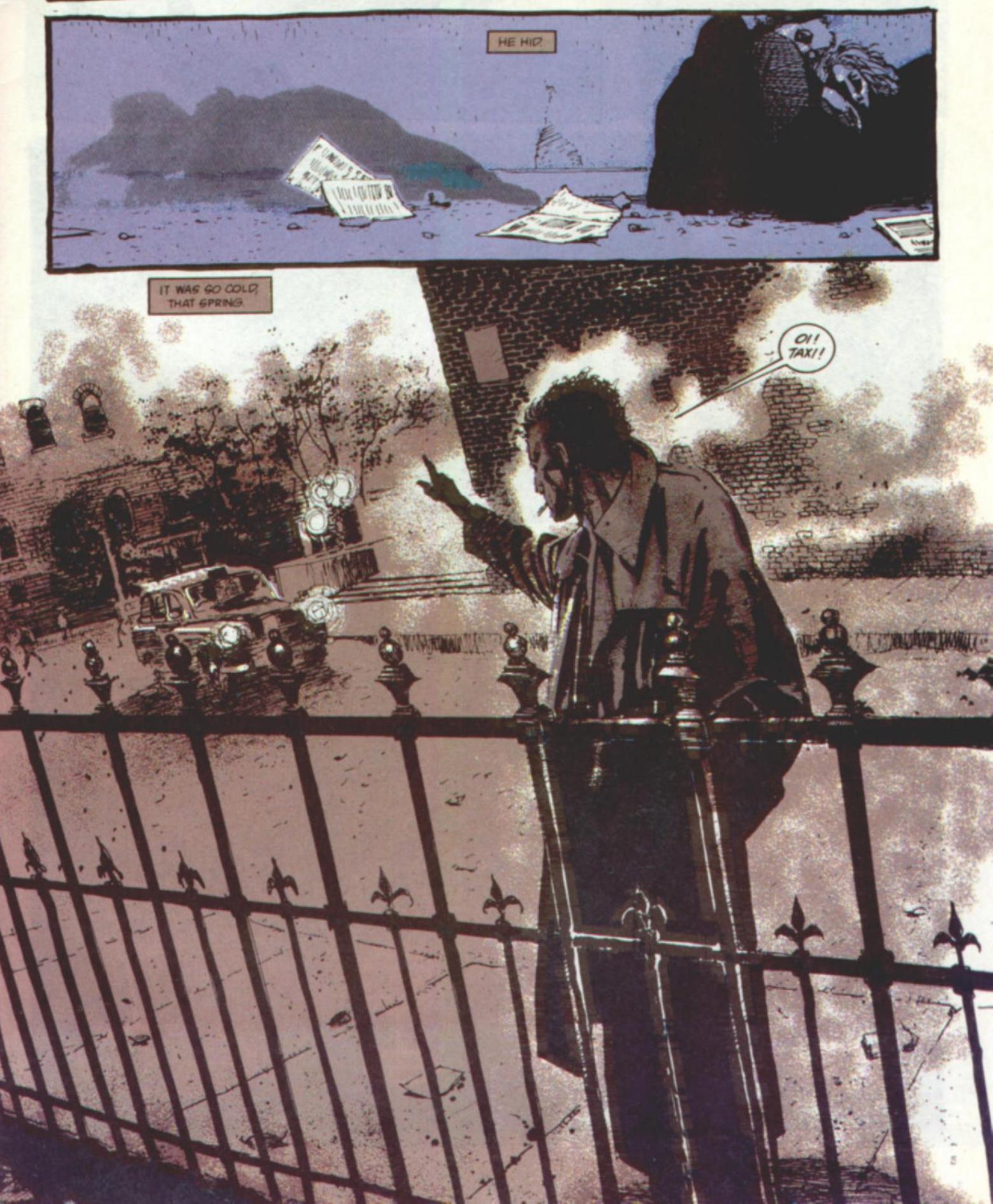
But while Gaiman is consciously playing within Delano’s style and iconography, Gaiman displays none of the awkwardness in storytelling that characterize Delano’s run. “Hold Me” is carefully structured, introducing the story of Fat Ronnie, Sylvia from Hull, and Jacko in its first four pages, then spending the next four establishing both Constantine’s situation for the issue [attending the memorial for Ray Monde and meeting Anthea there] and sketching out theme with the encounter with the homeless man, and even a quick bit of caption boxes in which Constantine recalls another cab driver telling him about how he thinks the pretty girls one sees in summer “go off and hibernate in empty rooms” come the winter, a deft repetition of the story’s central motif. Gaiman then cuts to a two-page section of the zombie Jacko killing a young girl’s mother when she goes to investigate her daughter’s claim that there’s “a smelly man in my bedroom.” And from there the issue is a fourteen page straight shot of horror as Constantine goes home with Anthea, wanders lost in her tower estate, encounters the young girl trying to find help for her mother, and finally finds and confronts Jacko. It’s efficient, clear storytelling—doubly important given that McKean’s broad and abstract style, for all that it’s visually impressive and moody, is considerably less transparent in its storytelling than, to take someone at the opposite end of the spectrum, the crisp clarity of Dave Gibbons. Instead of forcing McKean out of his moody purples to communicate the time jump between Jacko’s death in the cold spring and the autumn setting of the main story or relying on anything so bland as a caption reading “six months later,” Gaiman has the last line of the opening narration, “it was so cold that spring,” sit over a large panel of Constantine hailing a taxi to blend the translation, with the time shift being communicated by Constantine’s description of “when the leaves start to crisp and yellow, and the mists crawl in off the Thames.”
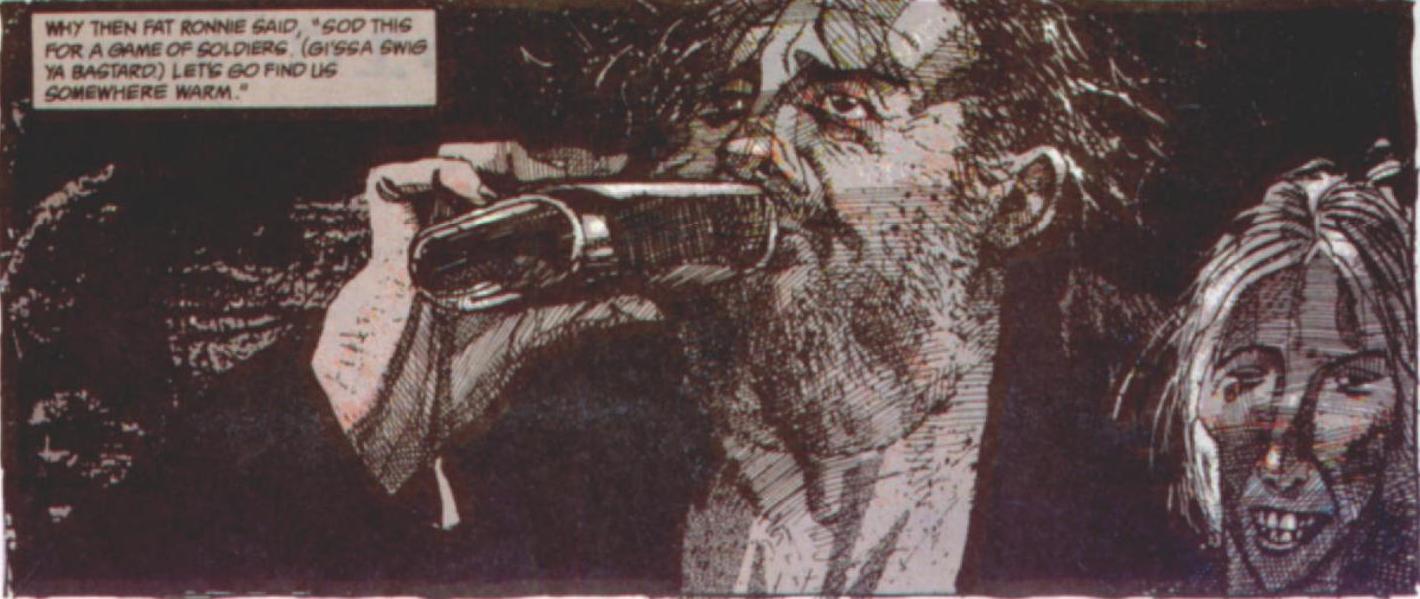
This also highlights how Gaiman works the language of the story in a way that is not only obviously indebted to Moore but that comes off well in the comparison. The narration is more prosaic than Moore is prone towards—it opens, “It was Fat Ronnie’s idea. It was so cold that spring. Fat Ronnie and Sylvia From Hull used to hang around together and somewhere along the way Jacko wound up wandering with them. So when the old bill came round with their bloody hoses at three in the morning, when they’d just got settled under the bridge… why then Fat Ronnie said, ‘sod this for a game of soldiers. [Gi’ssa swig ya bastard.] Let’s go find us somewhere warm.” But instead of falling into the iambic rhythm of Moore, Gaiman adopts a more conversational patter—note the deft detail of Fat Ronnie demanding a swig of Jacko’s bottle in the middle of corralling everyone towards warmth, emphasized by McKean’s illustration of Fat Ronnie taking a drink—but is no less effective for it. And he doesn’t shy away from interspersing poetry within it—later he writes, “ there was no one to hold Jacko anyway. Ice-crystals glittered on the window glass, and the lights of London burned clear and cold in the darkness. He had to get away,” letting the transition from Jacko’s loneliness to his decision to flee be made entirely with evocative imagery of a desolate and cold-haunted city. And, of course, there’s the repeated line “it was so cold that spring,” which does fall into Moore’s iambs [even in its variation on the title page, “it was so very cold that spring”].
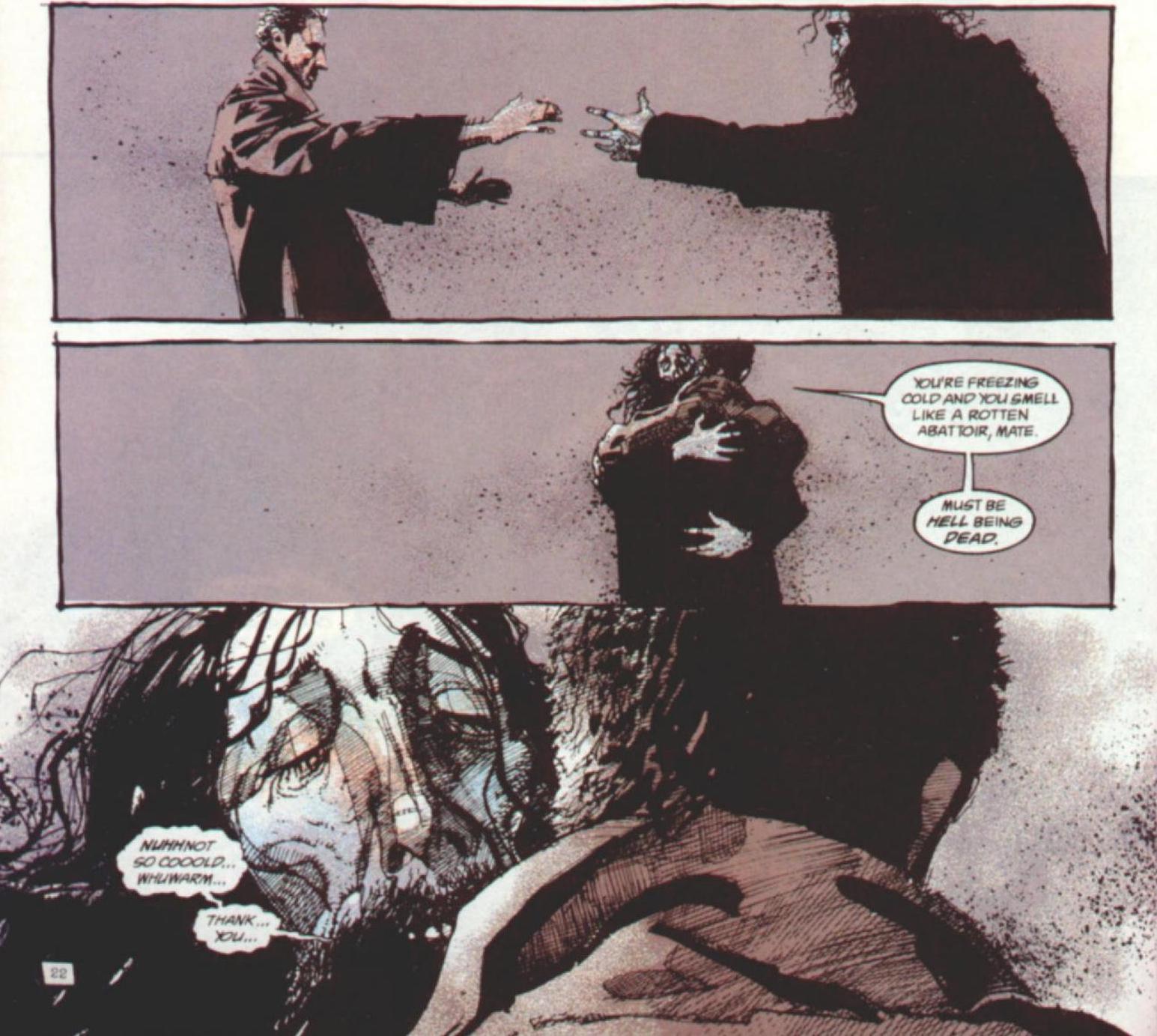
The real heart of why “Hold Me” stands out, however, is Gaiman’s skill with the emotional content of the story. The opening narration of Jacko’s last spring is an example, but the whole story is suffused with an emotional depth that stands out starkly in a run otherwise dominated by the more intellectually-focused work of Delano and Morrison [or even Moore]. The ultimate resolution comes when Constantine embraces the dead Jacko, giving him the warmth and human contact he craved [while, in a very John Constantine beat, telling him “you’re freezing cold and you smell like a rotten abattoir, mate. Must be hell being dead”]. The final image is Constantine going back to Anthea’s flat and asking her to hold him, an ending that puts the focus firmly on the emotional catharsis. Even a comparatively minor like Constantine realizing that the girl who’s invited him home is a lesbian who’s just trying to seduce him to get pregnant is well-handled, with the story taking a moment to linger on his wounded pride, sulking “you could have bloody asked, you know. That’s all. You could have bloody asked.” [And Gaiman wisely grounds the reaction in Constantine’s previous experiences with the idea.] At the end of the day, “Hold Me” is a story about homelessness and poverty under Thatcher, but its angle into that is the emotional experience of loneliness and despair. Indeed, Gaiman notes that the thing that stuck out for him about his friend’s story of a homeless man dying in a nearby flat was “something about the loneliness that must have been involved, about why no one cares.” For Gaiman, the emotional experience of homelessness and that people have about homelessness are where any engagement with the concept starts.
It is no great revelation that, while all of the major combatants in the War are tremendously successful writers, Gaiman enjoys a level of popular and commercial success an order of magnitude higher than the others. And while “Hold Me” shows Gaiman on particularly high form [he notes that “‘Hold Me’ is one of the comics of which I am most proud. I feel like I did something good there], it’s also a comic that one can look at and immediately see why its author went on to have the reputation that he did. It is a mixture of skillfully executed and rawly enjoyable that few writers can reproduce, and fewer still with any reliability. More even than the unquestionably brilliant but also dense and weighty Watchmen, “Hold Me” is a comic that one can present to someone and have them immediately see its virtues. Its mix of well-sketched spookiness and larger than life emotional vividness is self-evidently potent—a winning formula that would go on to win very big indeed.)
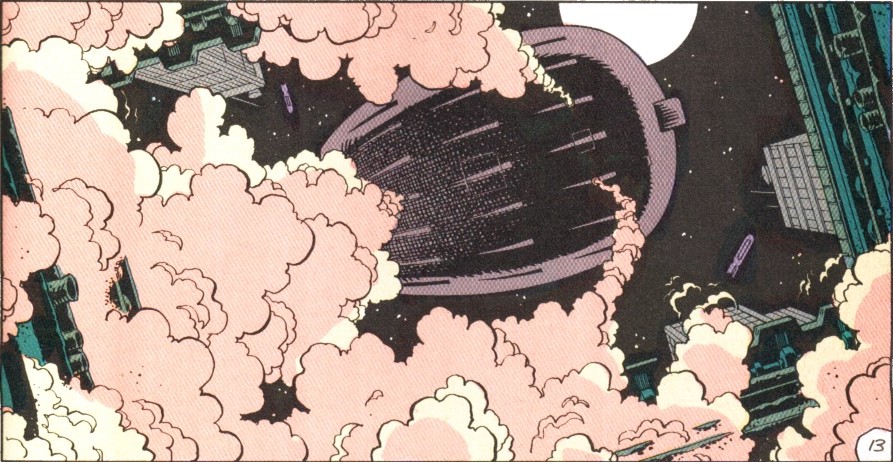
The issues after, however, which feature both Chester and Abby nearly becoming the next Swamp Thing, really start to cross into beating a dead horse similarly to the repetitive monster stories of the American Gothic arc did for Moore, only largely worse because the endless incarnations of the Sprout give even less room for play, and feel more farcical in their failure to resolve. Thankfully, Veitch pulls out of the downturn with Swamp Thing #75, “The Thinker.” In it, Swamp Thing attempts to come up with a way out of the sprout dilemma that does not involve euthanizing the sprout’s soul. On Abby’s suggestion, he grows himself a biocomputer to augment his thinking capabilities and begins to ponder. This is the impetus for Veitch to do one of the psychedelic essays he and Moore enjoy so much, as Swamp Thing ponders the nature of humanity, evolution, and history searching for a way forward. It is nothing the book has not done before—indeed nothing Veitch hasn’t done before, and “The Thinker” is not even a particularly stand-out iteration of it, but it comes satisfyingly close to a Swamp Thing idea that always works. And by the end of the issue Swamp Thing has an idea, and the story can finally move forwards.
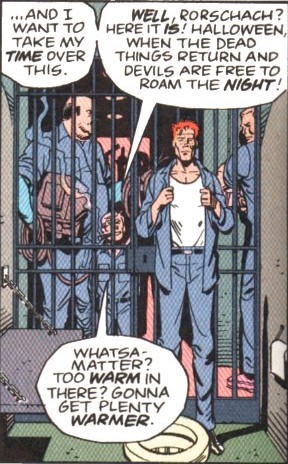
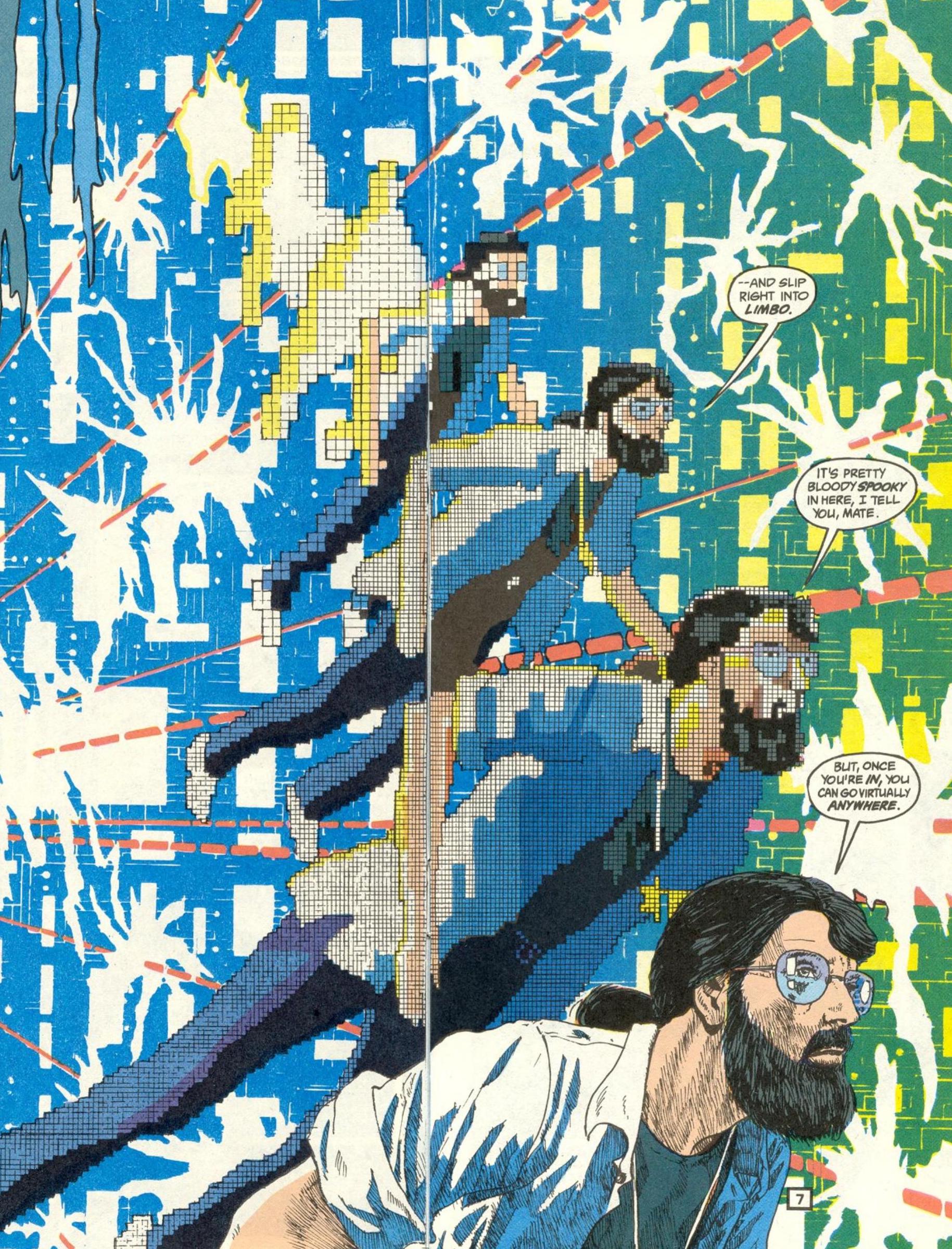
Meanwhile, in Hellblazer, Delano was in the midst of an increasingly muddy plot involving the competing machinations of a Christian fundamentalist sect called the Resurrection Crusade and a bunch of demon worshippers called the Damnation Army and led by the menacing Nergal, a demon who has some as of yet unknown history with Constantine. Delano is almost always at his worst when trying to structure a big multi-issue plot, but as usual individual moments still crackle, most obviously a cyberpunk-inflected sequence in which another one of his old friends from the mysterious Newcastle incident helps him hack the Resurrection Crusade before making a wrong step as he encounters some unexplained, paradise-like universe within the computer system that leads his body to incinerate in fromt of Constantine. This, combined with the death of his friend Ray Monde, who is beaten to death for being gay by the Resurrection Crusade whilst they kidnap Zed, a girl he was protecting on John’s behalf, drives Constantine over the edge into another depressive spiral.
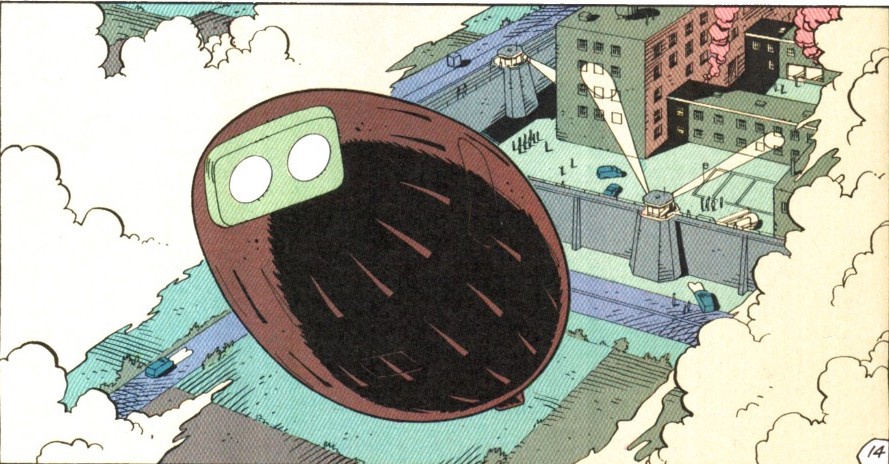

It is here that Swamp Thing’s plan begins to intersect it’s sister title. The plan, as come to in “The Thinker,” is that Swamp Thing and Abby need to have a child themselves into which the sprout can incarnate. This is, apparently, because of the magical properties of the human womb, “where all memories of suffering and triumph are erased, and the slate of each soul wiped clean in preparation for its next voyage back into the realms of earthly illusion.” From this, Swamp Thing concludes that the sprout could be purified if it gestated inside a human womb, imagining that the future elementals will be “dressed not in foliage, but in flesh.” This is hazily explained at best, but the fact that it comes at the climax of a psychedelic vision sequence helps paper over the gaps.
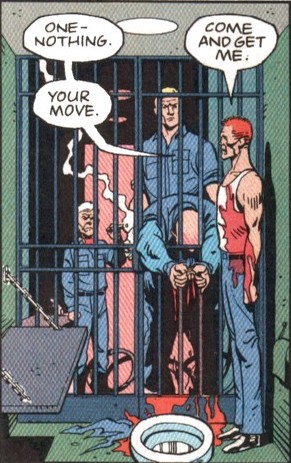 “The Thinker” ends with a note that it will be continued in Hellblazer #9, an issue that sees Constantine at rock bottom, imagining the ghosts of all the people he’s let down and caused the death of, drinking himself into a stupor, and fleeing a figure that animates itself out of various objects—rags, newspapers, and eventually money. To a remotely savvy reader (especially one who knows this is continuing off of “The Thinker”) this is obviously Swamp Thing, but it is not until Constantine pulls himself together and decides to get back to the manipulative game-playing that he’s good at that this thread is allowed to resolve. After a quick bit of sabotage of the Resurrection Crusade’s plans to create a new messiah by nipping off and having a covert tryst with the aforementioned girl, thus contaminating her with the demon blood that had been infused into him by Nergal, he returns to his apartment with one last item on his agenda: a prophecy relayed by Nergal of a child conceived on the winter solstice of “a conjunction between nature and super-nature.” And so as Swamp Thing manifests himself out of Constantine’s cigarettes, Constantine explains his plan.
“The Thinker” ends with a note that it will be continued in Hellblazer #9, an issue that sees Constantine at rock bottom, imagining the ghosts of all the people he’s let down and caused the death of, drinking himself into a stupor, and fleeing a figure that animates itself out of various objects—rags, newspapers, and eventually money. To a remotely savvy reader (especially one who knows this is continuing off of “The Thinker”) this is obviously Swamp Thing, but it is not until Constantine pulls himself together and decides to get back to the manipulative game-playing that he’s good at that this thread is allowed to resolve. After a quick bit of sabotage of the Resurrection Crusade’s plans to create a new messiah by nipping off and having a covert tryst with the aforementioned girl, thus contaminating her with the demon blood that had been infused into him by Nergal, he returns to his apartment with one last item on his agenda: a prophecy relayed by Nergal of a child conceived on the winter solstice of “a conjunction between nature and super-nature.” And so as Swamp Thing manifests himself out of Constantine’s cigarettes, Constantine explains his plan.
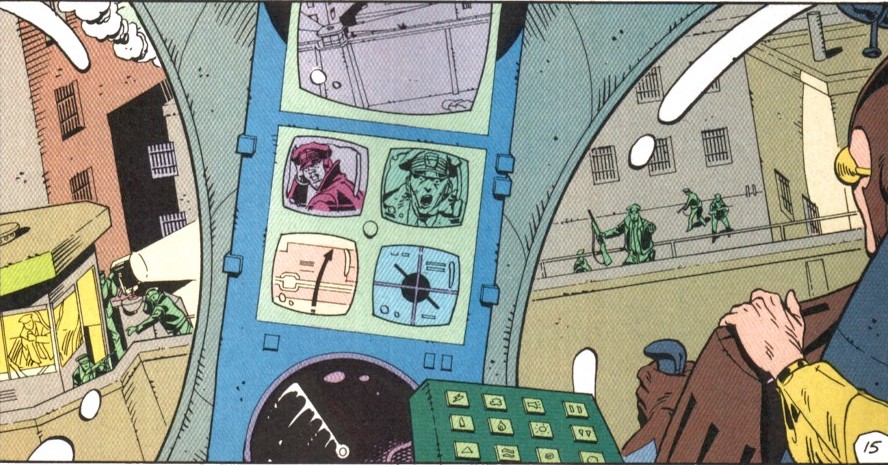 This plan, as it happens, is the same as Swamp Thing’s. And so in Swamp Thing #76, Swamp Thing possesses John Constantine’s body and heads back to Louisiana. The resulting issue is an oddly structured thing the parts of which largely exceed the whole, if only because there are so many of them. In one strand, Abby mills about, processing her emotions at the idea of having Swamp Thing’s child. This involves both touching scenes, such as her visiting her comatose husband Matt in the hospital and taking it as a sign when his wedding ring falls off his finger, to deeply humorous ones, such as when she stops by to visit Chester only to discover that he’s naked save for a pair of socks and sheepishly explaining that he and Liz Tremayne have “reached a critical point in our relationship!” Elsewhere, Veitch checks in on Anton Arcane in hell and chronicles the encounters Swamp Thing-in-Constantine has on his trip, including an astonishing throwaway scene in which he encounters Jack Kirby’s bitter Stan Lee parody Funky Flashman at the airport and is subjected to a lengthy pitch about how they should plot out a Swamp Thing/Darkseid fight for the profit of both Flashman and Constantine. But perhaps the issue’s most delightfully random beat sees Swamp Thing take John Constantine’s body by a tattoo parlor to get him an unwanted tattoo as revenge for all the trouble Constantine has gotten him into.
This plan, as it happens, is the same as Swamp Thing’s. And so in Swamp Thing #76, Swamp Thing possesses John Constantine’s body and heads back to Louisiana. The resulting issue is an oddly structured thing the parts of which largely exceed the whole, if only because there are so many of them. In one strand, Abby mills about, processing her emotions at the idea of having Swamp Thing’s child. This involves both touching scenes, such as her visiting her comatose husband Matt in the hospital and taking it as a sign when his wedding ring falls off his finger, to deeply humorous ones, such as when she stops by to visit Chester only to discover that he’s naked save for a pair of socks and sheepishly explaining that he and Liz Tremayne have “reached a critical point in our relationship!” Elsewhere, Veitch checks in on Anton Arcane in hell and chronicles the encounters Swamp Thing-in-Constantine has on his trip, including an astonishing throwaway scene in which he encounters Jack Kirby’s bitter Stan Lee parody Funky Flashman at the airport and is subjected to a lengthy pitch about how they should plot out a Swamp Thing/Darkseid fight for the profit of both Flashman and Constantine. But perhaps the issue’s most delightfully random beat sees Swamp Thing take John Constantine’s body by a tattoo parlor to get him an unwanted tattoo as revenge for all the trouble Constantine has gotten him into.
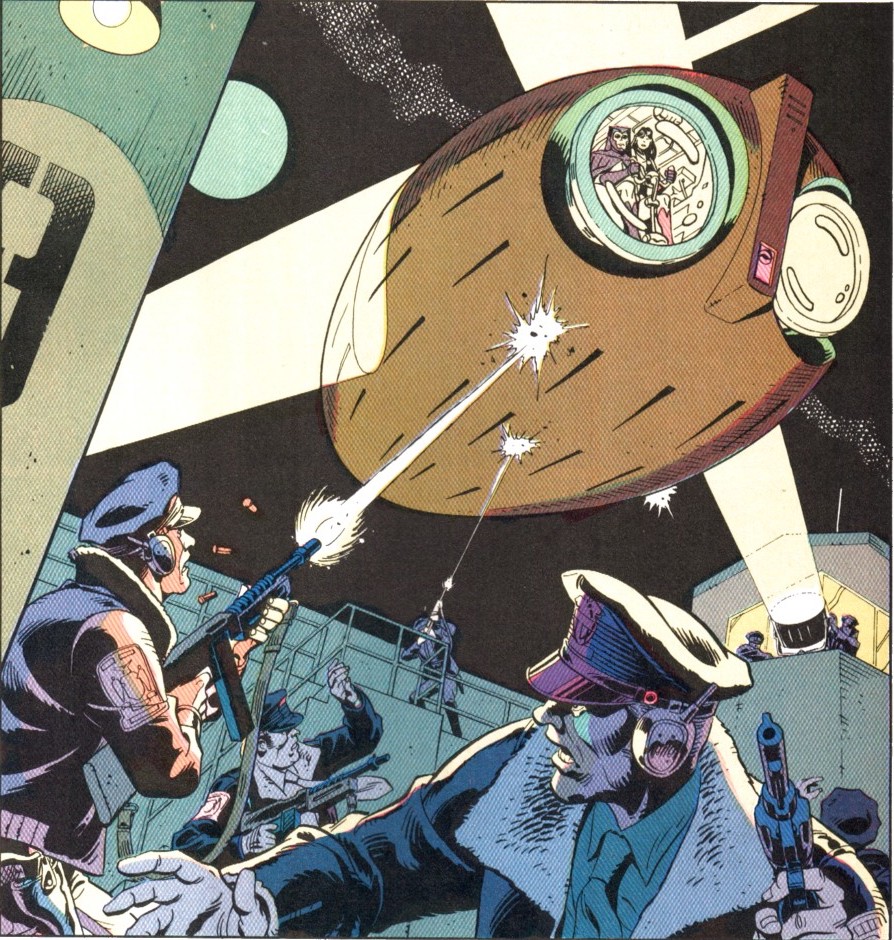 Eventually, however, the issue gets down to the actual plan, in which Swamp Thing has sex with Abby while in Constantine’s body, thus allowing for the creation of a new elemental. (This will eventually be Tefé Holland, who will go on to a lengthy tenure as a minor supporting character that nobody quite knows what to do with, the highlight of her existence being a short-lived Swamp Thing series in the 2000s written by an emerging Brian K. Vaughan.) It is a deeply strange and bewildering plot point that can easily be argued as ill-chosen, though Veitch and Delano do manage to avoid the worst possibilities by making sure everyone involved is aware of and consenting to the plan. Still, it’s an unsettling plot point, and it’s not a surprise that the two issues of Swamp Thing following are dedicated to sorting it out. The first, a guest issue by Delano, is largely successful—Abby decides she needs some time alone following waking up next to Constantine back in his own body and storms off to be alone, only to encounter Constantine again and reconcile with him over a night of drinking before he chivalrously avoids sleeping with her again, instead getting up before her, buying her breakfast, and getting her back to Houma to reconcile with Swamp Thing. The second, penned by Steve Bissette, sees Swamp Thing accidentally take on female form and then give birth to another body which rapidly grows back to his normal form; the less said about this the better.
Eventually, however, the issue gets down to the actual plan, in which Swamp Thing has sex with Abby while in Constantine’s body, thus allowing for the creation of a new elemental. (This will eventually be Tefé Holland, who will go on to a lengthy tenure as a minor supporting character that nobody quite knows what to do with, the highlight of her existence being a short-lived Swamp Thing series in the 2000s written by an emerging Brian K. Vaughan.) It is a deeply strange and bewildering plot point that can easily be argued as ill-chosen, though Veitch and Delano do manage to avoid the worst possibilities by making sure everyone involved is aware of and consenting to the plan. Still, it’s an unsettling plot point, and it’s not a surprise that the two issues of Swamp Thing following are dedicated to sorting it out. The first, a guest issue by Delano, is largely successful—Abby decides she needs some time alone following waking up next to Constantine back in his own body and storms off to be alone, only to encounter Constantine again and reconcile with him over a night of drinking before he chivalrously avoids sleeping with her again, instead getting up before her, buying her breakfast, and getting her back to Houma to reconcile with Swamp Thing. The second, penned by Steve Bissette, sees Swamp Thing accidentally take on female form and then give birth to another body which rapidly grows back to his normal form; the less said about this the better.
Delano’s Hellblazer run continued for nearly three years after its crossover with Veitch’s run. In the immediate term, this involved picking up on the Nergal thread by having Constantine finally realize that his past connection with Nergal relates to the mysterious Newcastle incident. This leads into Hellblazer #11, which finally flashes back to tell that story. The result is a mixed bag—the issue is an effective piece of horror that makes good use of the idea of a young John Constantine who is in way over his head. And yet the actual plot—Constantine botches a demonic summoning, resulting in the death of a young girl—cannot help but be a disappointing answer to the long-seeded mystery of what awful thing happened in Newcastle that had been woven into Constantine’s backstory from the start. In much the same way that the demonic soul brokers story in Hellblazer #3 shows the ways in which Delano’s approach can work in spite of its limitations, the Newcastle revelation shows the level it can never quite surpass—the way in which it cannot ever quite nail a big moment.
With the dark history of Newcastle revealed, Delano wraps up the Nergal storyline with another cyberpunk issue before doing a one-off with a nuclear paranoia dream sequence. This transitions into Delano’s second major arc, The Fear Machine, which at nine issues is the longest single story of his run. (The first trade paperback is also nine issues long, but collects the two issue Mnemoth story, the demon investment one-off, and, bafflingly, the first six issues of the Resurrection Crusade/Nergal story, which can be argued to also be nine issues long, but is better understood as two stories that dovetail each other in the manner that comics syndication often does.)
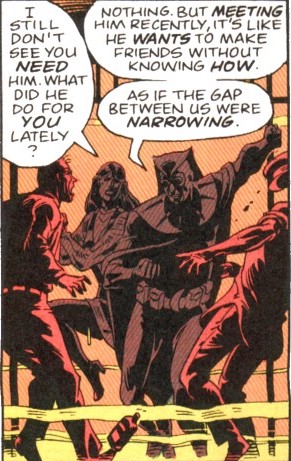
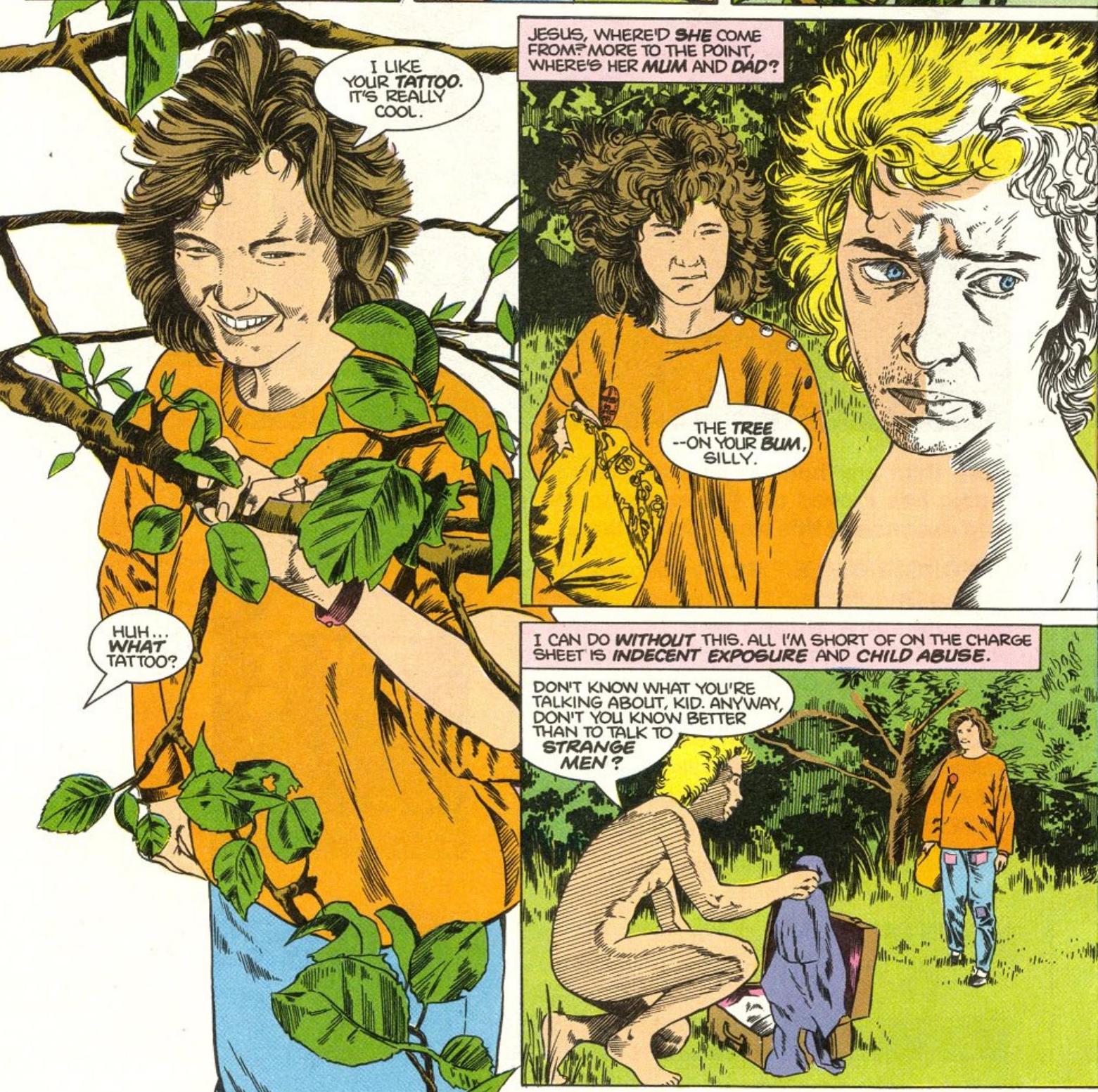
The Fear Machine is a flawed magnum opus. As with most of Delano’s story arcs, it starts strong and loses steam. The first three issues, which see Constantine falling in with a group of travellers after a mildly psychic girl named Mercury comes up on him as he’s washing his clothes after falling into a ravine while fleeing the cops and compliments him on the tattoo of an evergreen on his butt that he didn’t know he had. Constantine spends the better part of three issues trying to settle into the community instead of being is usual self-destructive self. These are oddly engrossing slice of life issues in which Constantine navigates social dynamics, struggles with getting a tent set up, and is covertly dosed with fly agaric mushrooms after he’s a twat and low-grade hypnotizes someone after they threaten to expose him as wanted for murder.
It is not until the plot of the arc begins in earnest in the third issue as Mercury is kidnapped by a secretive group and Constantine vows to go rescue her that things go off the rails. A fourth issue in which the eponymous fear machine is aimed at a train Constantine is on, is a muddied thing hindered by sub-par guest art by Mike Hoffman and by the degree to which it feels like a complete digression from what has gone before. And the next few issues, which introduce a bevy of new supporting characters as Constantine investigates a hazily explained masonic conspiracy, plays to all of Delano’s weaknesses and steadily lets all the steam out of the arc.
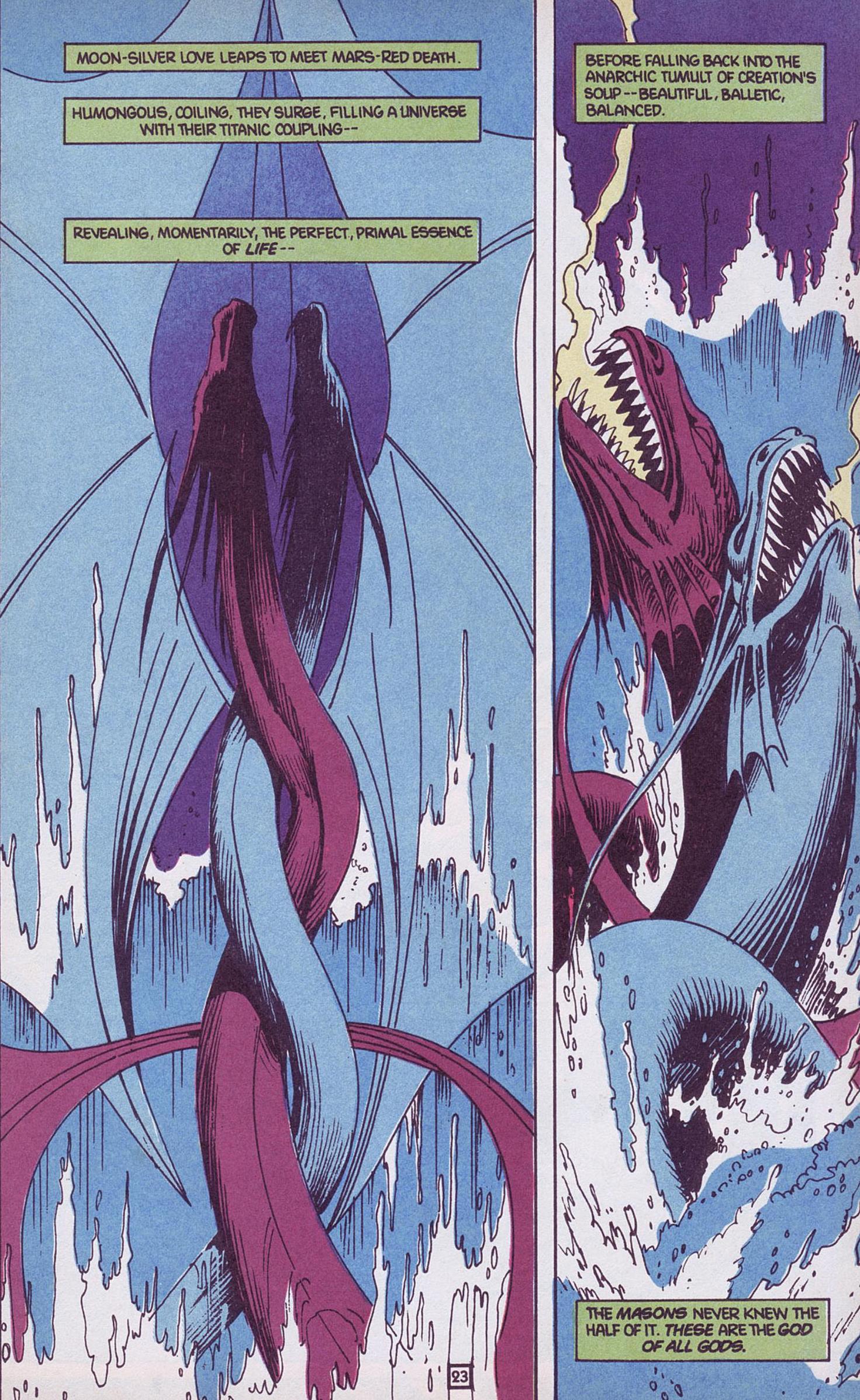
And yet in the final issue things more or less work out to a draw. Constantine finally meets back up with the travellers (after anticlimactically finding a self-rescuing Mercury at a roadside diner on his way north), who have themselves hooked up with a group called the Pagan Nation that turns out to be led by Zed. Zed explains that the ley lines that power the fear machine are in reality “just an early attempt by a male priesthood to dominate the female principle and unbalance the nature of God,” which Constantine realizes is obvious because there’s no straight lines in nature. Accordingly, Zed, Constantine, and Mercury’s mother Marj engage in a ritual to unleash the feminine dragon energy of the world. The actual resolution sees Constantine kicked out of the ritual in its final moments because “now it’s time for femaleness,” watching the ritual from a distance until a massive wave crashes into him, “and as the bloody tide of change breaks over me, all I can think of is the crippled kid in the Pied Piper who can’t make it to the door in the magic mountain quickly enough.” A final page epilogue sees him picked up out of the water by a boat, amnesiac about what’s just happened. It’s an odd ending, with all the lack of satisfaction and payoff you’d expect from sidelining your book’s main character for the denouement of a nine issue epic, but it’s such a madly ambitious ending that its narrative deficiencies seem forgivable, especially given how sympathetic its politics are.
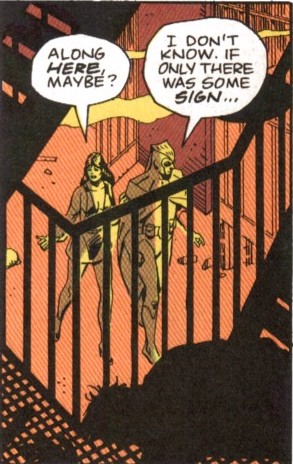
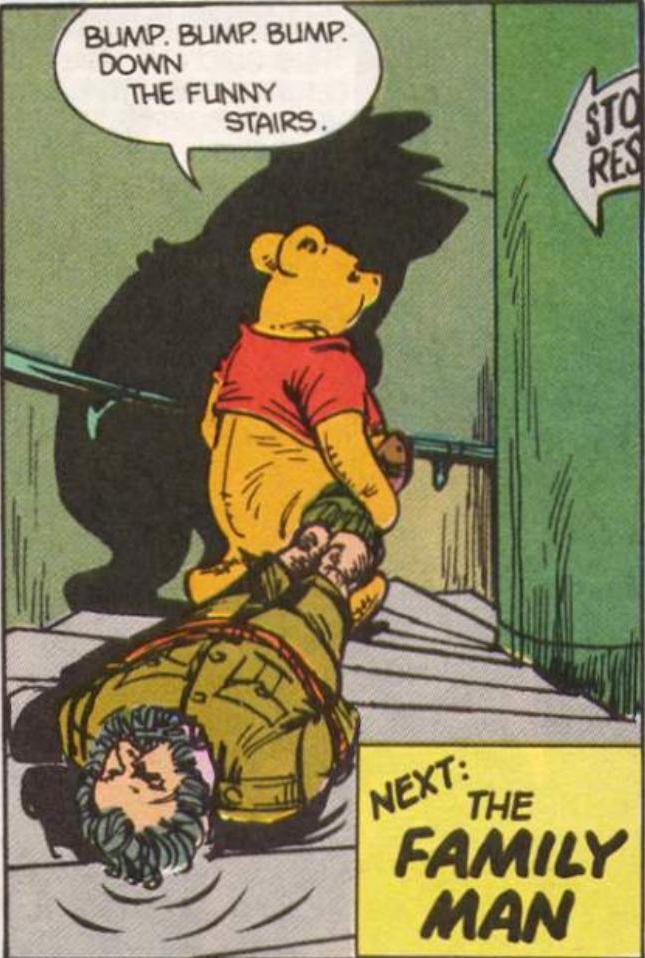
Following The Fear Machine, Delano penned a quick one-off entitled “Larger Than Life” in which Constantine goes to Northampton (practically the only time in the War that setting will not be an Alan Moore reference, given that Delano’s from there too) to visit Jerry O’Flynn, a famously over the top character whose tall tales have become so exaggerated that the world of fiction has laid claim to him, eventually sending a mob of fictional characters to capture him, put him on trial, and finally take him away, with Constantine’s last sight of him being as he’s bound and dragged down the stairs by Winnie the Pooh, who laconically remarks “Bump. Bump. Bump. Down the funny stairs” as he goes.
Improbably, this bit of daft metafiction comedy leads into his next major arc, The Family Man, when Constantine discovers that Jerry has, among his other interests, been providing a serial killer, the eponymous Family Man, who seeks out happy families to kill, with victims in exchange for serial killer memorabilia he can fence to a film producer. Constantine, unfortunately, realizes this only after he’s handed the killer the envelope with Jerry’s last suggested victims, and is immediately wracked with guilt and a determination to stop him. This, however, had to wait for four issues whilst Delano took a brief sabbatical from the book, creating room for a two-issue fill-in run by Grant Morrison and a one-shot by Neil Gaiman.
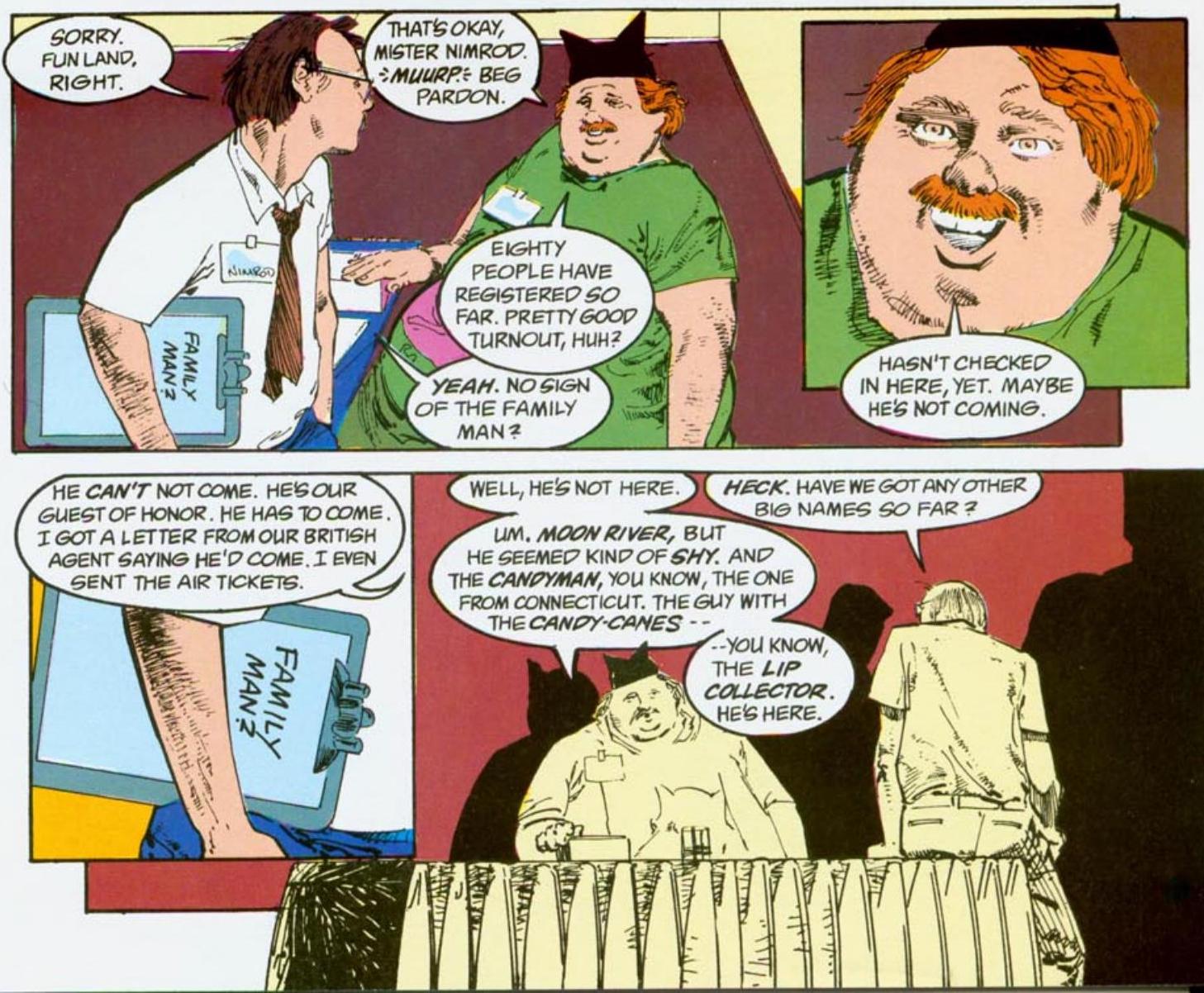
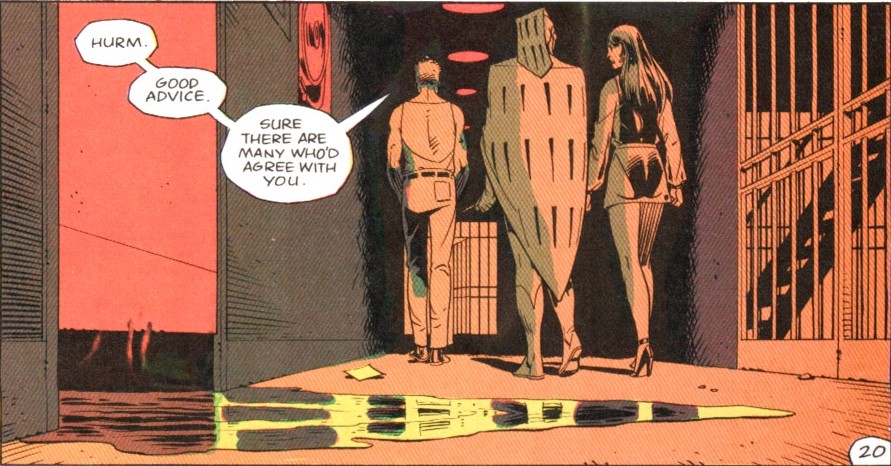 When Delano’s arc resumed in Hellblazer 28, what unfolded was a dark game of cat and mouse between Constantine and the Family Man, who quickly turned the tables on Constantine, including hunting down and murdering his father. While the tense back and forth of a mutual chase is the sort of detail-oriented plotting that eludes Delano, and the resolution strains credulity by suggesting that Constantine, the ruthless bastard seen sacrificing his old friend in the first story arc, would be morally scared of killing a serial killer, once again the basic setup—having Constantine face an entirely mundane threat with no supernatural dimension whatsoever—is such a solid hook that Delano largely gets away with it.
When Delano’s arc resumed in Hellblazer 28, what unfolded was a dark game of cat and mouse between Constantine and the Family Man, who quickly turned the tables on Constantine, including hunting down and murdering his father. While the tense back and forth of a mutual chase is the sort of detail-oriented plotting that eludes Delano, and the resolution strains credulity by suggesting that Constantine, the ruthless bastard seen sacrificing his old friend in the first story arc, would be morally scared of killing a serial killer, once again the basic setup—having Constantine face an entirely mundane threat with no supernatural dimension whatsoever—is such a solid hook that Delano largely gets away with it.
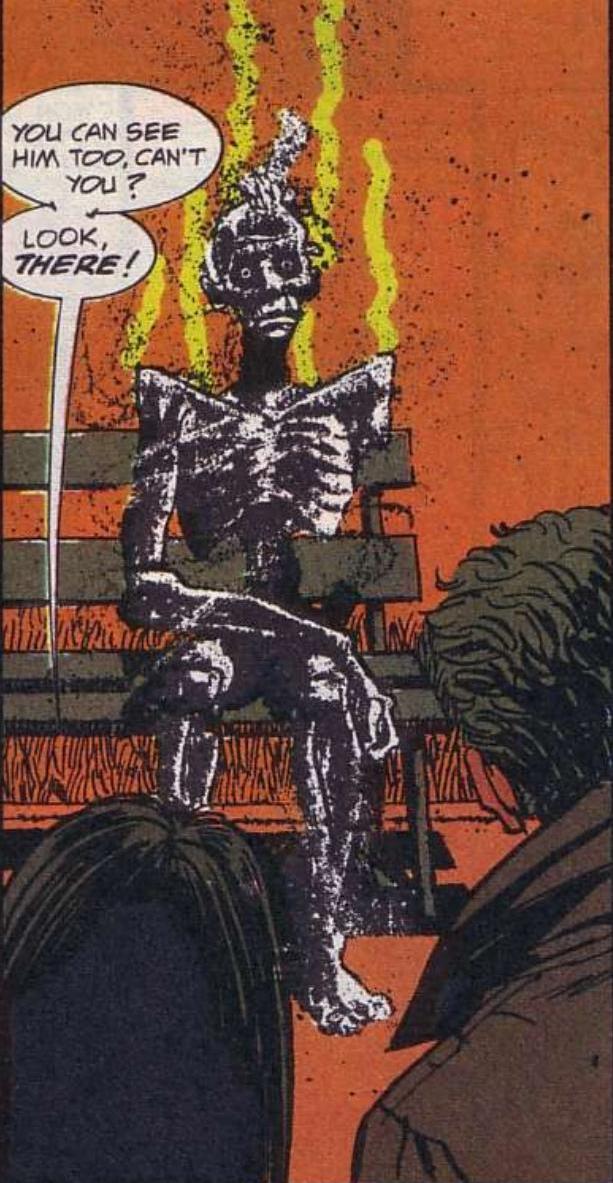
The Family Man is followed by a one-off cheekily titled “Mourning of the Magician” dealing with the inevitable fallout of Constantine’s father’s murder. Told largely from the perspective of John Constantine’s niece, Gemma, the issue is a straightforward ghost story in which she is continually haunted by the restless spirit of her grandfather. Artist Sean Phillips and colorist Tom Ziuko collaborate effectively to make the ghost a visually striking figure—a monochrome scar across otherwise saturated panels. The issue is one of the high points of Delano’s run, a moody, emotional, and tightly plotted piece that showcases the best of what he can do.
The remaining nine issues of Delano’s Hellblazer run are an odd mix of one-offs and arc plotting. First is a one-off by guest writer Dick Foreman, a fellow Northampton resident and friend of Delano’s and Moore’s who would go on to pen the short-lived Black Orchid ongoing series before switching to other pursuits under his full name of Richard Foreman, including penning a few pieces for Alan Moore’s Dodgem Logic. This was followed by a surreal meditation on cities and change called “Sundays are Different,” at which point Delano began his final arc, such as it was.
These final seven issues have never been collected in trade paperback save for one, “Dead-Boys Heart,” which was collected in a grab bag collection entitled Rare Cuts alongside the as-of-2005 otherwise uncollected Newcastle issue, the two-issue Grant Morrison arc, a stray Garth Ennis issue, and a fill-in issue Delano did at the end of Ennis’s tenure on the book that finally revealed why Constantine’s long-sufferingly faithful friend Chas famously “owes him.” (The answer involves Chas’s mother and a feces-flinging monkey familiar that Constantine had to seduce.) They form a loose arc in which Constantine reconnects with Mercury from The Fear Machine, her mother Marj, and eventually Zed, and that delves into Constantine’s childhood (this being the content of “Dead-Boys Heart,” which is a strange tale set entirely in Constantine’s childhood where it is wholly unclear whether anything supernatural happens).
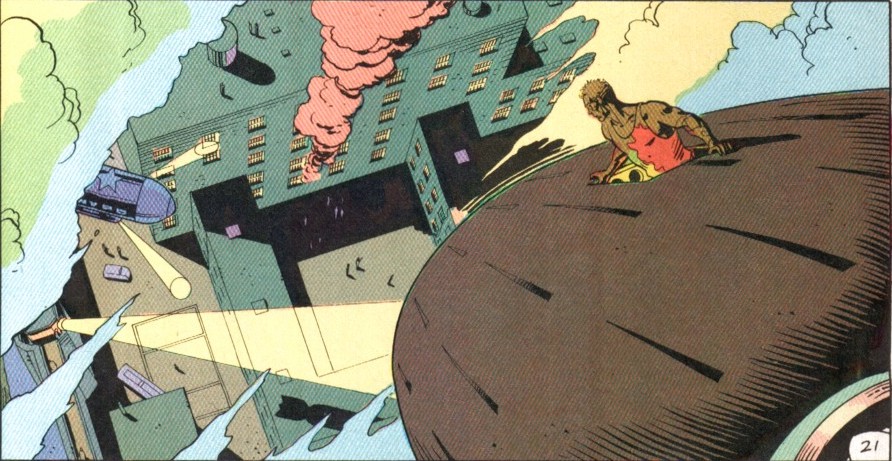 It would be satisfying to offer a narrative in which Delano closed his tenure with newfound strength having learned over his nearly four years on the title. In reality, however, these issues more accurately serve as a microcosm of all his strengths and flaws. When they operate on the small scale, such as “Dead-Boys Heart,” or the two-part “Man’s Work”/“Boy’s Game” arc , a Mercury-centric story about a timid young boy and his abusive slaughterhouse-working father, Delano sparkles with the dark fury that characterizes his run. When he tackles larger plots, such as his revelation that Constantine murdered his twin brother in the womb, and that this Golden Boy was the better self he can never be, the run sags back into an unsatisfying mess.
It would be satisfying to offer a narrative in which Delano closed his tenure with newfound strength having learned over his nearly four years on the title. In reality, however, these issues more accurately serve as a microcosm of all his strengths and flaws. When they operate on the small scale, such as “Dead-Boys Heart,” or the two-part “Man’s Work”/“Boy’s Game” arc , a Mercury-centric story about a timid young boy and his abusive slaughterhouse-working father, Delano sparkles with the dark fury that characterizes his run. When he tackles larger plots, such as his revelation that Constantine murdered his twin brother in the womb, and that this Golden Boy was the better self he can never be, the run sags back into an unsatisfying mess.
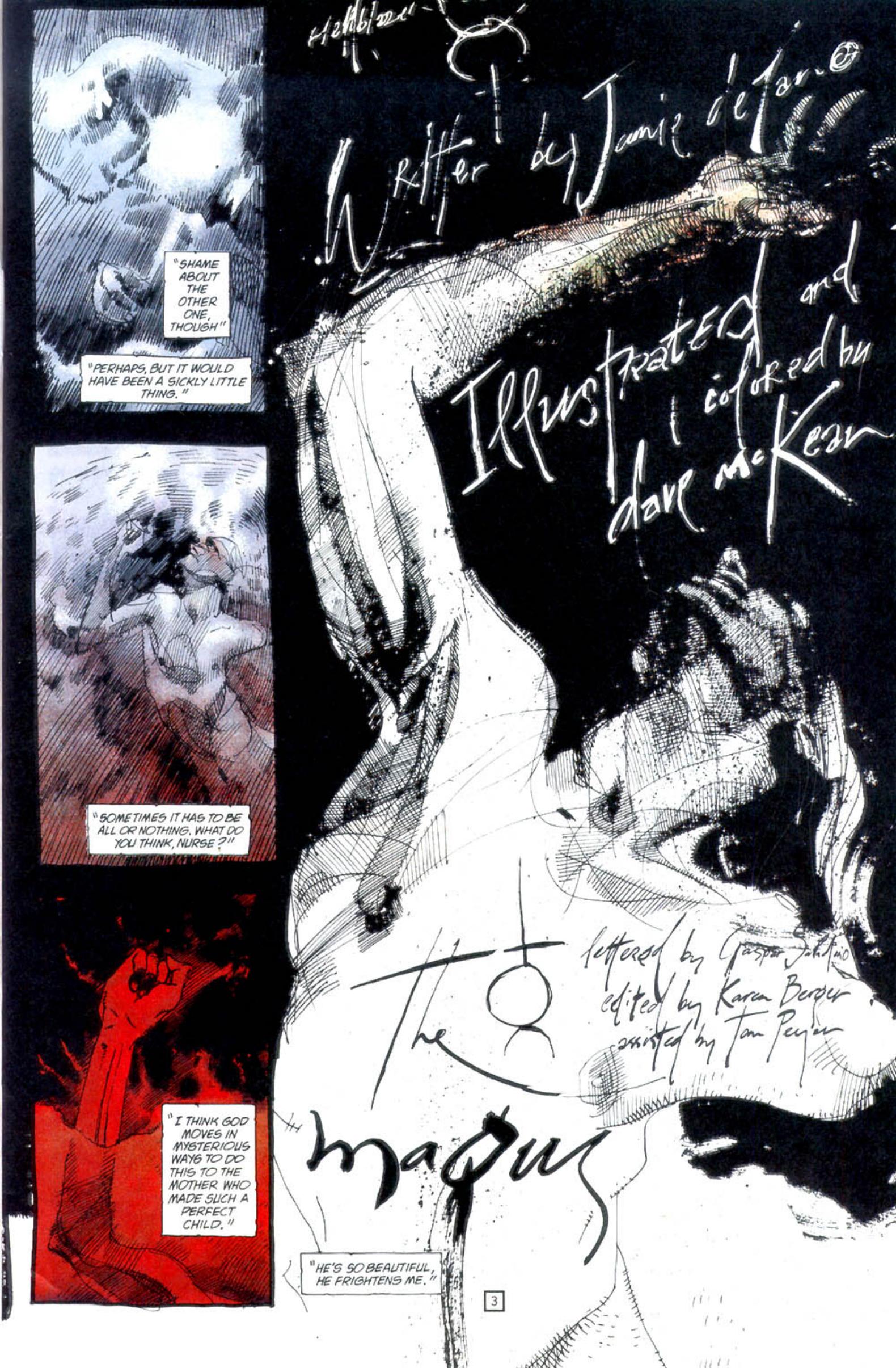
Delano’s final issue, Hellblazer #40, is unfortunately in the latter category. A mystical encounter that begins in an alternate universe in which the Golden Boy lived and Constantine died, and where this version, the Magus, succeeded where Constantine failed, saving the young girl Astra in Newcastle, and helping sooth the ire of the Earth itself with the help of the Pagan Nation. Eventually this version encounters the real John Constantine, and they realize that they must unite themselves, while back in the real world Constantine mysteriously disappears after a psychedelic trip, vanishing from within a cave in a series of obviously Christlike images. The issue features lush and surreal artwork from Dave McKean, but was a cryptic and largely unsatisfying end to a run that was, in the end, iconic without ever quite being classic—an era that is better remembered than reread.
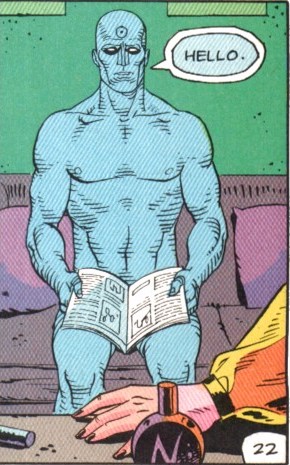 By this point, it was February of 1991. Watchmen had ended almost three and a half years earlier, and Moore had long since moved on to projects like A Small Killing, Lost Girls, and From Hell. The efforts to repeat the lightning strike that was his Swamp Thing were far beyond the tentative guesses with which Delano and Veitch had been put on their respective books. Grant Morrison’s Animal Man had been wrapped up for six months, although he had nearly two years left to go on Doom Patrol, while Peter Milligan was ten issues into Shade, the Chainging Man, and Neil Gaiman was a third of the way through Sandman and wrapping up Books of Magic. The business of replacing Alan Moore, in other words, was largely complete, and DC had a finely tuned machine that was two years out from being yolked together under Karen Berger’s Vertigo imprint. Delano’s counterpart in their early experiments at this effort, Rick Veitch, had departed Swamp Thing nearly two years prior, and unlike Delano did not get the luxury of doing so on his own terms.
By this point, it was February of 1991. Watchmen had ended almost three and a half years earlier, and Moore had long since moved on to projects like A Small Killing, Lost Girls, and From Hell. The efforts to repeat the lightning strike that was his Swamp Thing were far beyond the tentative guesses with which Delano and Veitch had been put on their respective books. Grant Morrison’s Animal Man had been wrapped up for six months, although he had nearly two years left to go on Doom Patrol, while Peter Milligan was ten issues into Shade, the Chainging Man, and Neil Gaiman was a third of the way through Sandman and wrapping up Books of Magic. The business of replacing Alan Moore, in other words, was largely complete, and DC had a finely tuned machine that was two years out from being yolked together under Karen Berger’s Vertigo imprint. Delano’s counterpart in their early experiments at this effort, Rick Veitch, had departed Swamp Thing nearly two years prior, and unlike Delano did not get the luxury of doing so on his own terms.
Veitch’s run would ultimately only continue for nine more issues following the resolution of the Hellblazer crossover. The first of these, Swamp Thing #79, came in August of 1988, barely a year after the end of Watchmen and alongside Animal Man #4, the final issue of Morrison’s overtly Moore-mimicking first arc, and marked a strange detour. With no particular setup in any of Veitch’s previous issues, Swamp Thing decides that he has to go to Metropolis and kill Lex Luthor for his role in trying to kill Swamp Thing all the way back in Swamp Thing #53. There he encounters Superman, who takes the sort of absurd moral parody of a moral stance that superhero comics take when they need to contrive a reason for superheroes not to do more than just punch supervillains, arguing that “I’m not even sure it’s against the law to try to kill a plant” as he frustrates all of Swamp Thing’s efforts at vengeance in quick breaks from attending a press conference as Clark Kent.

This is followed by a pair of tie-ins to DC’s 1988 crossover event, Invasion! Written by Keith Giffen and Bill Mantlo, the three-issue miniseries (and accompanying thirty-nine tie-in issues) dealt with a massive invasion of Earth by a broad alliance of DC’s stable of alien species. Veitch largely made deft use of the crossover—in his first issue, he has Swamp Thing extend his consciousness over the whole planet only to be suddenly attacked by an alien weapon that blocks his ability to transmit his consciousness off the planet, seemingly destroying him completely. In his second, meanwhile, he has a distraught Abby and Chester encountering the widow of the alien that Swamp Thing encountered fifteen years earlier in issue nine of the Wein/Wrightson Swamp Thing series—an inventive use of both the premise of Invasion! and of Swamp Thing’s history, using the fate of the alien’s husband and the apparent fate of Swamp Thing for a moment of emotional connection.
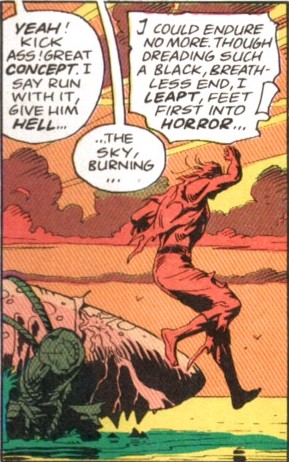 From there, Veitch launched into what was always intended to be his last arc. Just as Moore closed his run by killing Swamp Thing and embarking on an arc in which Swamp Thing travelled through outer space to meet a variety of DC’s sci-fi concepts, Veitch, having also killed Swamp Thing, instead sent him on a journey drifting progressively backwards through time. This arc ends up having a slightly formulaic structure. In each issue, Swamp Thing arrives in a time period and quickly meets whatever established characters DC has in that period—Sergeant Rock in World War II, Enemy Ace in World War I, Jonah Hex and Bat Lash in the wild west, Tomahawk in the last days of the 18th century, and the Shining Knight in medieval Camelot. In each instance they have an adventure that culminates in encountering a mysterious artifact called the Claw of Aelkhünd—a withered arm clutching a piece of amber, the appearance of which inevitably sends Swamp Thing tumbling back into the time stream. As Swamp Thing moves further and further back, he learns more and more about the origins of the claw.
From there, Veitch launched into what was always intended to be his last arc. Just as Moore closed his run by killing Swamp Thing and embarking on an arc in which Swamp Thing travelled through outer space to meet a variety of DC’s sci-fi concepts, Veitch, having also killed Swamp Thing, instead sent him on a journey drifting progressively backwards through time. This arc ends up having a slightly formulaic structure. In each issue, Swamp Thing arrives in a time period and quickly meets whatever established characters DC has in that period—Sergeant Rock in World War II, Enemy Ace in World War I, Jonah Hex and Bat Lash in the wild west, Tomahawk in the last days of the 18th century, and the Shining Knight in medieval Camelot. In each instance they have an adventure that culminates in encountering a mysterious artifact called the Claw of Aelkhünd—a withered arm clutching a piece of amber, the appearance of which inevitably sends Swamp Thing tumbling back into the time stream. As Swamp Thing moves further and further back, he learns more and more about the origins of the claw.

This story is interspersed with trips to the present in which Abby slowly pieces together what’s happened to Swamp Thing out of fleeting mentions in history books. The one issue to actually spend all of its time in the present, Swamp Thing #84, deals with the loose thread of Abby’s husband Matt Cable, who had died in a car crash, been possessed by Anton Arcane, and finally left in a coma all the way back in Swamp Thing #31 at the end of Alan Moore’s first year on the title. In this issue, Abby discovers that his comatose body has been seized for a compulsory organ donation program, setting up an issue of extended medical horror that is resolved when the dreaming Matt meets Dream from Neil Gaiman’s freshly debuted Sandman series, who helps him wake up and briefly take control of his body, dramatically sparing Abby from having to unplug his life support systems herself before collapsing and dying, although he would quietly be transformed into a supporting character in Sandman.
Vetich’s final issue of Swamp Thing was issue #87, which saw Swamp Thing arrive in medieval Camelot, where he gets involved in an adventure with the Shining Knight in which he helps defend Camelot from an attack by Morgaine le Fey. Afterwards, however, the Shining Knight presents King Arthur with the Holy Grail, which he opens to find a familiar chunk of amber, casting Swamp Thing back in time and leading to the collapse of Camelot, which was being supported by Swamp Thing’s roots. It is a lush and gorgeous issue, with frequent Swamp Thing penciller Tom Yeates drawing rotated double page spreads that make expansive use of space, exercising the skills he would eventually bring to the Prince Valiant newspaper strip. The reveal that the Claw of Aelkhünd (or at least the stone within, the origin of the claw portion having been revealed in the previous issue) resided inside the Holy Grail set up obvious questions, which Veitch intended to answer in the next issue. This, however, never happened.
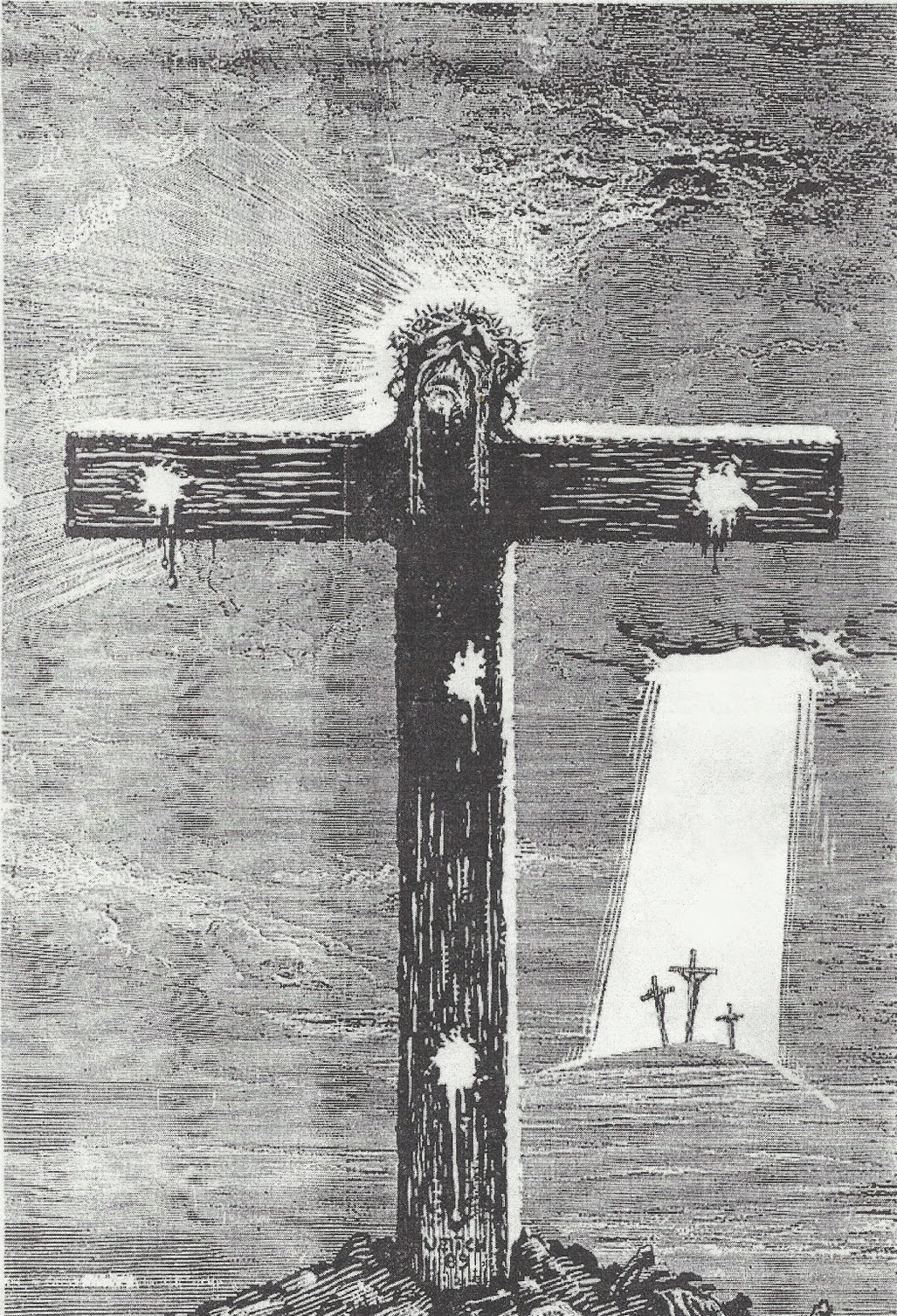
Veitch’s plan was a story entitled “Morning of the Magician,” (the title is a reference to the 1960 French book The Morning of the Magicians, a popular compendium of occultism and conspiracy theories) in which Swamp Thing would encounter Jesus. As Veitch explains in the intro to the script, he imagines Christ as “the first of the white magicians,” with his death being a sacrifice to banish a group of black magicians headed up by Belial, the father of Etrigan (for whom the issue would have provided an origin story). Swamp Thing would have attempted to interfere in this, not realizing Christ’s plan, and would have been banished by Jesus via the amber stone, which would then be slipped into the grail to set up Swamp Thing #87.
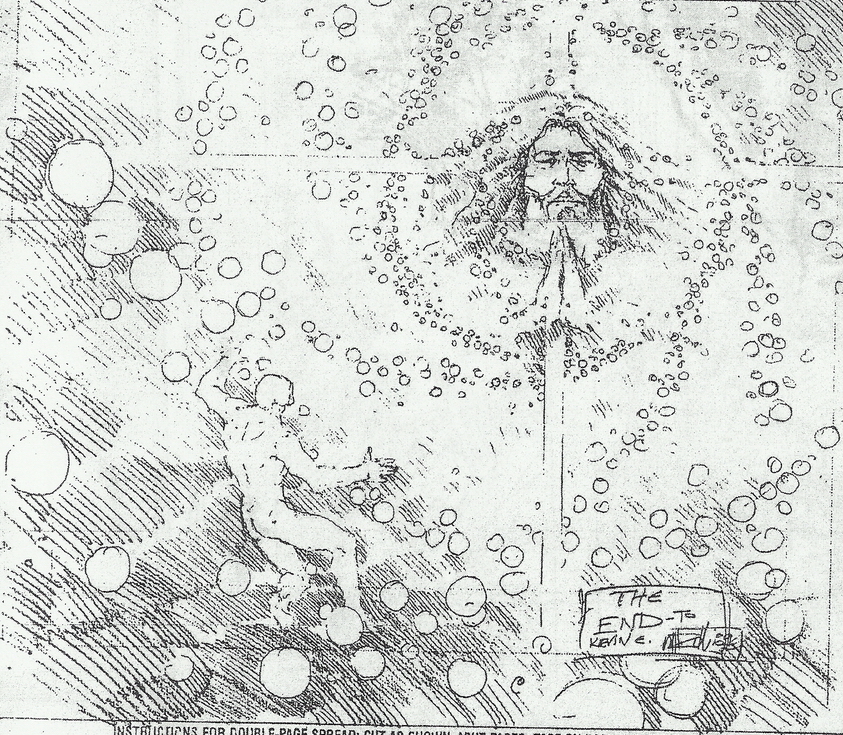
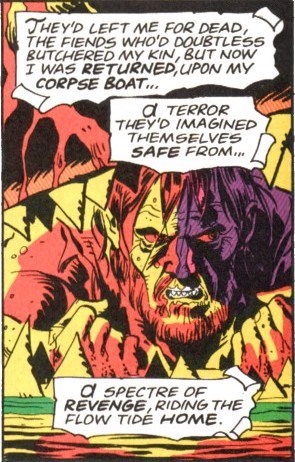 Given the content of the issue, DC was careful in approving it, with both Karen Berger and her direct supervisor Dick Giordano approving both an outline and the script before approval was given for guest artist Michael Zulli, doing what would have been his first work in mainstream comics, to start work on the issue. With pencils completed and inks having been begun, however, DC President Jenette Kahn got wind of the story and ordered it killed. On March 6th, 1989 Berger reluctantly informed Veitch that he would have to supply a new script. Veitch attempted to appeal the decision, talking to Khan about it to try to see if any changes could be made to make the book acceptable, but in his description “she was just completely unsupportive. Her attitude was that I was responsible for this big mistake.” Feeling he had been left with no other choice, on March 9th, just over a week after Swamp Thing #85 was released, Veitch quit the book, and his intended successors Jamie Delano and Neil Gaiman backed out of taking over in solidarity, creating a more than three month gap between issues 87 and 88.
Given the content of the issue, DC was careful in approving it, with both Karen Berger and her direct supervisor Dick Giordano approving both an outline and the script before approval was given for guest artist Michael Zulli, doing what would have been his first work in mainstream comics, to start work on the issue. With pencils completed and inks having been begun, however, DC President Jenette Kahn got wind of the story and ordered it killed. On March 6th, 1989 Berger reluctantly informed Veitch that he would have to supply a new script. Veitch attempted to appeal the decision, talking to Khan about it to try to see if any changes could be made to make the book acceptable, but in his description “she was just completely unsupportive. Her attitude was that I was responsible for this big mistake.” Feeling he had been left with no other choice, on March 9th, just over a week after Swamp Thing #85 was released, Veitch quit the book, and his intended successors Jamie Delano and Neil Gaiman backed out of taking over in solidarity, creating a more than three month gap between issues 87 and 88.
Although Veitch professes to have only “slightly” anticipated the fuss over the issue, reading the script it is clear that Veitch was to an extent looking for a fight, cracking jokes about how Zulli will “join me on the stake when Jerry Falwell, Stege Geppi and Buddy Saunders get a hold of this comic.” The reference to Geppi and Saunders, the two people responsible for the moral panic that sparked the DC ratings system controversy and by extension Moore’s departure from the company, makes it clear that Veitch was looking to be provocative. But equally, Veitch really did go to considerable lengths to ensure that the issue was tastefully done, or at least as tasteful as a “superhero meets Jesus” comic can be. As Gaiman put it, defending Veitch in The Comics Journal, “Rick actually did it sweetly—this obviously was the traditional Jesus, the kind of Jesus you wouldn’t mind meeting at Sunday school.” And if Veitch was being a provocateur, he was only doing the job he’d been hired for. Swamp Thing, after all, had been the book where Moore had convinced DC to reject the Comics Code Authority and let him run an issue with demonic incest, and where he’d done an entire issue of psychedelic vegetable sex. And that’s to say nothing of the various bits of extreme content Moore not only got away with but was feted for in Watchmen. Swamp Thing’s obvious sister book was running stories about how infernal stockbrokers preferred Margaret Thatcher. Veitch was doing what he very reasonably thought DC expected him to do.
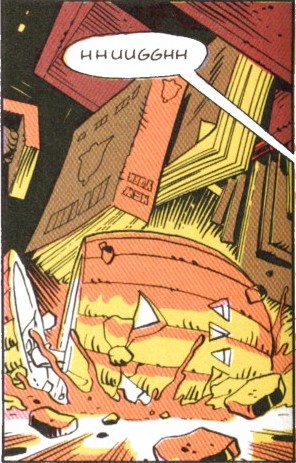 But the DC Comics of March, 1989 was a very different thing from the one in 1984 when Moore got away with “Love and Death.” Sure, the stable of post-Moore comics had by now swollen to include Animal Man, Sandman, and Doom Patrol alongside Swamp Thing and Hellblazer, which meant that a certain type of edgy comic was firmly a part of DC’s brand. But DC was a minor subsidiary of Warner Communications, who were on one front engaged in an extensive legal battle with Paramount to try to acquire Time, Inc., and on another in the leadup to the release of their tentpole Batman film with Jack Nicholson. They were, in other words, in no mood to be the subject of a vocal moral panic that might generate bad press and endanger either one of these projects. And so Kahn vetoed the issue, and Veitch proved himself too much the apt successor to Alan Moore by doing exactly what his mentor would have and angrily quitting.
But the DC Comics of March, 1989 was a very different thing from the one in 1984 when Moore got away with “Love and Death.” Sure, the stable of post-Moore comics had by now swollen to include Animal Man, Sandman, and Doom Patrol alongside Swamp Thing and Hellblazer, which meant that a certain type of edgy comic was firmly a part of DC’s brand. But DC was a minor subsidiary of Warner Communications, who were on one front engaged in an extensive legal battle with Paramount to try to acquire Time, Inc., and on another in the leadup to the release of their tentpole Batman film with Jack Nicholson. They were, in other words, in no mood to be the subject of a vocal moral panic that might generate bad press and endanger either one of these projects. And so Kahn vetoed the issue, and Veitch proved himself too much the apt successor to Alan Moore by doing exactly what his mentor would have and angrily quitting.
 But if DC had been willing to accept the departure of Moore in part because he was viewed as too much of an agitator, putting up with the departure of Veitch was ultimately nothing to them. After all, they had numerous successors in place, and while some like Gaiman might have been at least somewhat inclined to ostentatious moral stances, these were contained—Gaiman, for instance, made it clear to The Comics Journal that while he had quit Swamp Thing in solidarity with Veitch, this was manifestly not a Moorean refusal to work with the company in general. The controversy over “Morning of the Magician” may have led to some bad press for DC in the trades, but in a pre-Internet era it was never going to spread much further than that. Veitch could quietly disappear with little more than a three month delay to the book and a diplomatic note from Berger in the letters column, and DC could get on with its happily profitable life.
But if DC had been willing to accept the departure of Moore in part because he was viewed as too much of an agitator, putting up with the departure of Veitch was ultimately nothing to them. After all, they had numerous successors in place, and while some like Gaiman might have been at least somewhat inclined to ostentatious moral stances, these were contained—Gaiman, for instance, made it clear to The Comics Journal that while he had quit Swamp Thing in solidarity with Veitch, this was manifestly not a Moorean refusal to work with the company in general. The controversy over “Morning of the Magician” may have led to some bad press for DC in the trades, but in a pre-Internet era it was never going to spread much further than that. Veitch could quietly disappear with little more than a three month delay to the book and a diplomatic note from Berger in the letters column, and DC could get on with its happily profitable life.
“Go out onto a streetcorner in London and you’ll see the same thing. Same in Prague. Same in Sāo Paulo. Same in Osaka, and Grozny, and Tehran, and Jo’burg, and Hobart. That’s what a monoculture is. It’s everywhere, and it’s all the same. And it takes up alien cultures and digests them and shits them out in a homogenous building-block shape that fits seamlessly into the vast blank wall of the monoculture. This is the future. This is what we built. This is what we wanted.”-Warren Ellis, Transmetropolitan: I Hate It Here
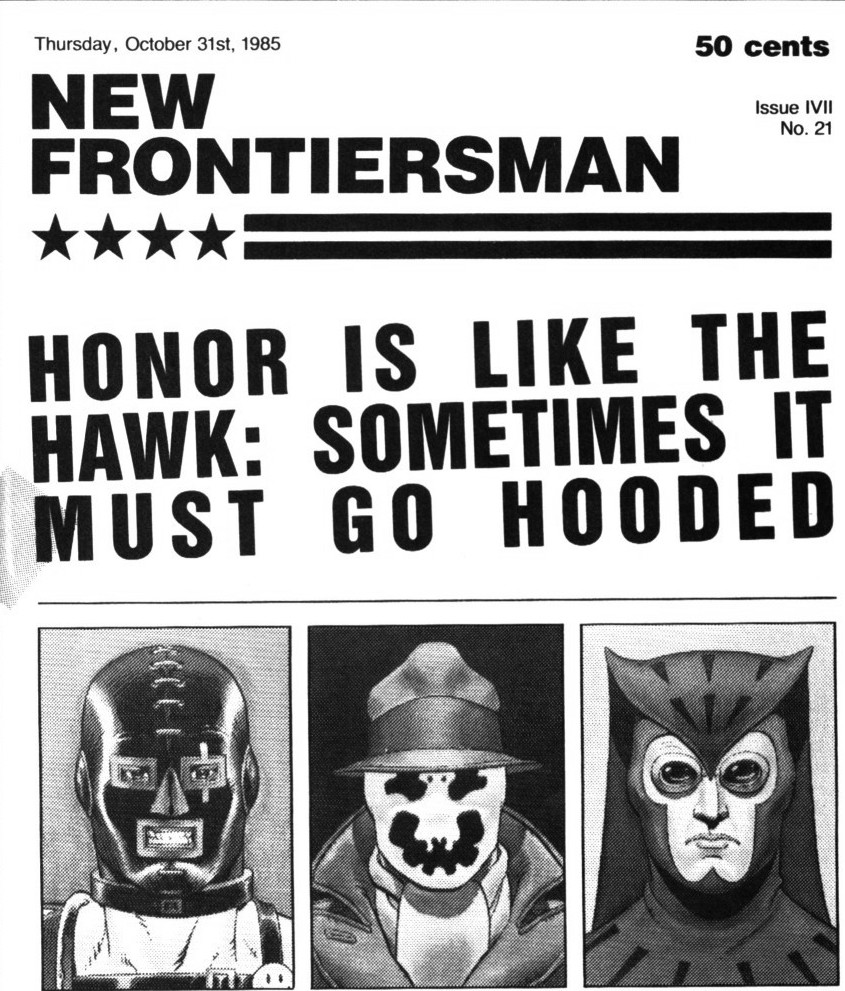
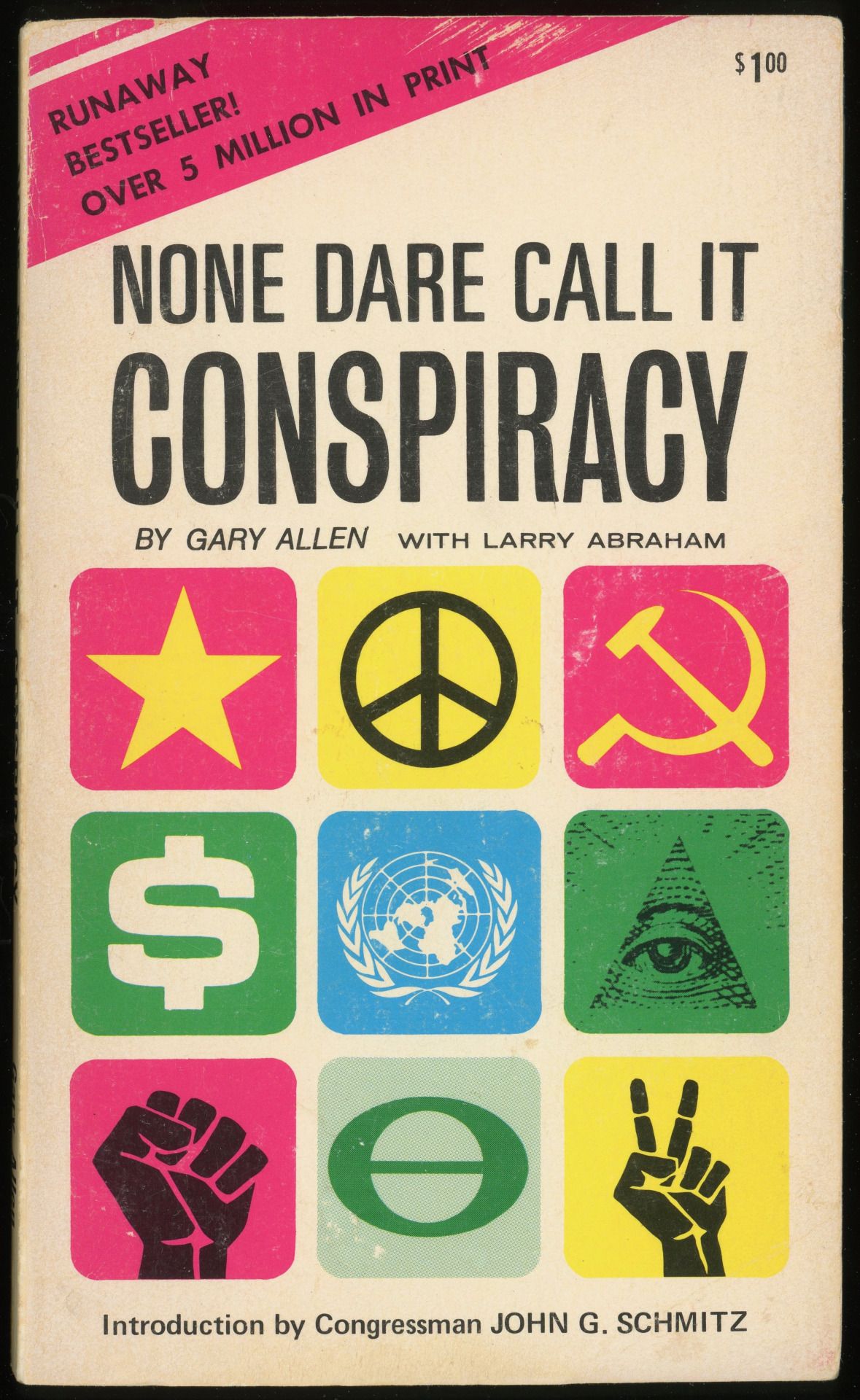
{On March 9th, 2009, twenty years to the day after Rick Veitch quit Swamp Thing, right-wing conspiracy nut radio host Alex Jones, a man who imagines himself to be the Comedian while in reality being a sub-par Rorschach, found himself in a genuinely unfamiliar circumstance: an opportunity to be right about something. Jones was a product of the fever swamps of the 1990s Patriot movements in the US—the same flavor of right-wing extremist that brought the 1995 Oklahoma City bombings. Like most of this group, Jones was intensely conspiracy-minded, taking up the “New World Order” theories concocted by the John Birch Society. These theories are essentially a light reworking of the stuff that Robert Shea and Robert Anton Wilson lampoon in The Illuminatus! Trilogy to focus primarily on the United Nations and global communism—think a far-right David Icke without the lizards. Initially a local talk radio host out of Austin, Jones gained profitable infamy by being first to the microphone to declare that 9/11 was an inside job, using the media attention from this to create an independent production company called Infowars from which he could spin conspiracies in between ads for quack dietary supplements.
With the release of the Watchmen movie, however, Jones had something alarmingly like a reasonable target. Watchmen, after all, really was a major motion picture based on a work by a radically left-wing self-admitted occultist openly seeking to deform the world and bring about a radically new future through works of art that doubled as acts of ritual magic. Indeed, the original comic already was an act of powerful magic that had dramatically reshaped the world in ways not entirely dissimilar to history as imagined by NWO conspiracy types. Jones, in other words, was tackling a topic in which his default approach could generate something that resembled an accurate and even highly perceptive account of reality. Unsurprisingly, he blew it completely.
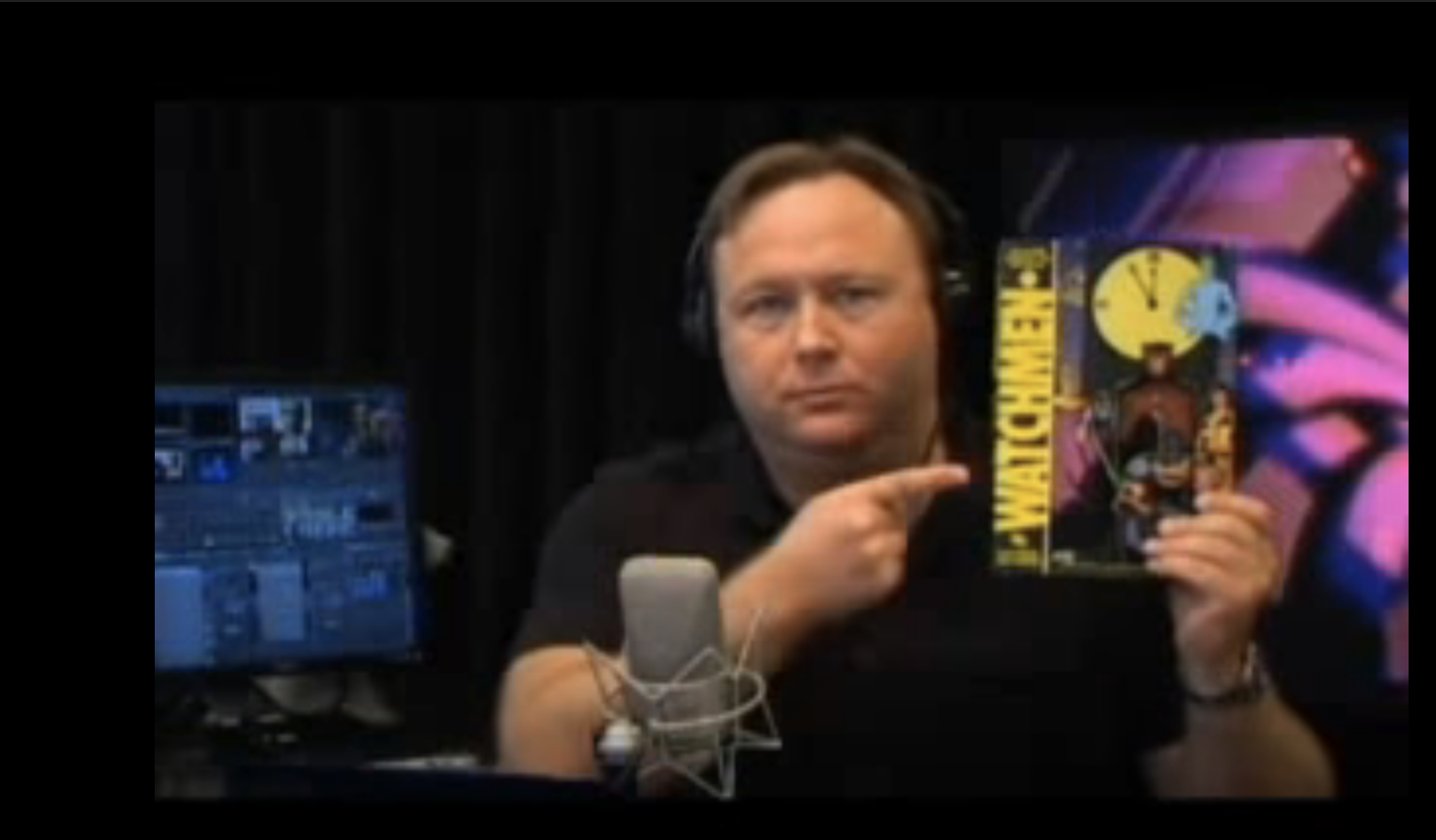
Stumbling out of the gate by misidentifying Moore as a freemason and the writer of Sandman, Jones misidentifies Watchmen as a straightforward piece of Illuminati propaganda that fits into their overall pattern of, for reasons that are not articulated, announcing their plans in the manner of some sort of Republic serial villain prior to executing them. In Jones’s world, these plans largely consist of false flag terrorist attacks that can be used as the pretext for dramatic government actions to establish the New World Order. And so it is perhaps understandable that Jones, upon seeing Ozymandias (or, as Jones persistently calls him, Ozymandaymus) do just this, assumes that Watchmen is a harbinger of some future transformative act as opposed to the world-altering act of occult practice itself.
In order to arrive at this conclusion, however, Jones has to do a badly slapdash job of reading both film and comic. Most significantly, he has to majorly misrepresent the ending of the movie, asserting that Doctor Manhattan entirely endorses Ozmandias’s plan. Jones works this into a confusing interpretation rooted in half-explained mysticism that jumps freely from reading the characters in terms of Egyptian mythology and a reading where Ozymandias is Lucifer and Doctor Manhattan is Jesus in which he seems to oscillate rapidly between asserting that Doctor Manhattan has been “fighting” Ozymandias his whole life and asserting that they were “brothers” and “comrades,:” which in turn relates to the supposedly dualistic nature of the Illuminati religion. In practice, however, it’s just a complete lie about what’s actually in the film. Doctor Manhattan pointedly refuses to agree or disagree with Ozymandias as he decides to leave Earth, while Dan and Laurie (inasmuch as Snyder gives her any agency) rage against the wrongness of what he’s done while acknowledging that undoing it would cause more harm. In a scene utterly absent from the comic, Dan violently attacks Ozymandias after Doctor Manhattan’s departure, and he and Laurie are seen storming out of Karnak, looking back contemptuously at Ozymandias.
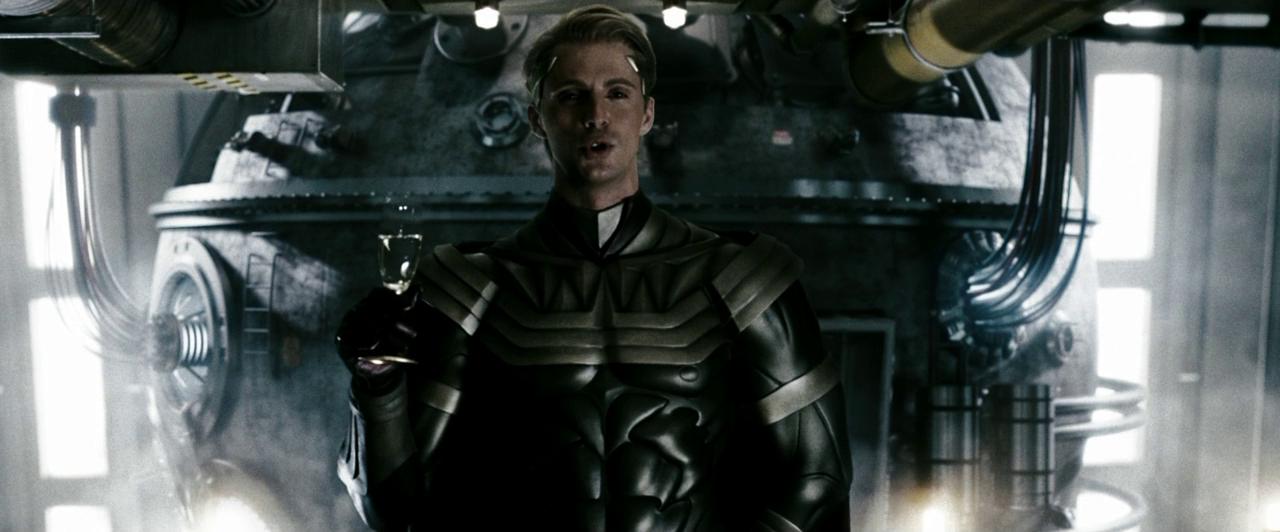
Ironically, Jones comes much closer to describing the comic (which he professes to have only “scanned through” the day before) , where there really is a big scene of all of the characters save Rorschach giving their justifications for siding with Ozymandias, which in Laurie’s case involves actively saying, “he was right. All we did was fail to stop him from saving Earth,” and where Dan’s acquiescence is not tempered by him beating the crap out of Ozymandias. While Moore is adamant that “the whole point of the book is to say that none of these characters are right or wrong,” the movie goes to considerable length to portray Ozymandias as the straightforward villain from the start, with Zack Snyder heavily queer-coding him (complete with giving his costume visible nipples in a backhanded homage to Joel Schumacher’s much-reviled Batman & Robin a decade earlier), and actor Matthew Goode making the decision to play him as speaking in a German accent in private and an American one in public, giving him the air of a disingenuous foreigner, both classically lazy ways of depicting a villain through appeals to xenophobia. His climactic declaration, changed in the movie to the nauseatingly arch “I’m not a comic book villain” (with its punchline even more ineptly changed to “I triggered it thirty-five minutes ago”), is made utterly ludicrous by the film, in which he blatantly is exactly that, his every utterance delivered as an over the top supervillain monologue.
But the place where Jones’s interpretation of the film becomes most outrageously strained is when he attempts to claim that “Rorschach is the runt of the group” and consistently portrayed as a bad guy and a psychopath despite, in Jones’s view, self-evidently being the good guy because he opposes pedophiles and the New World Order. That Jones would be among the many conservative assholes to admire Rorschach is unsurprising. But his failure to realize that Zack Snyder—a vocal admirer of Ayn Rand who has suggested an adaptation of The Fountainhead to be a dream project of his—feels the same way (and that the occult mastermind behind all of this is fond of the guy too) is surprising even for a man of his general lack of erudition. Snyder’s Rorschach is idolized in ways that Moore goes nowhere near. He’s not quite a quip machine in the style of Iron Man, which had established the Marvel Cinematic Universe the summer previous, but he gets plenty of snarky lines, including a wholly original to the movie scene during the prison break sequence originally in issue #8 where he runs into his psychologist, cowering from the riots, and then puts his mask back on and glares at him, “now what do you see?”
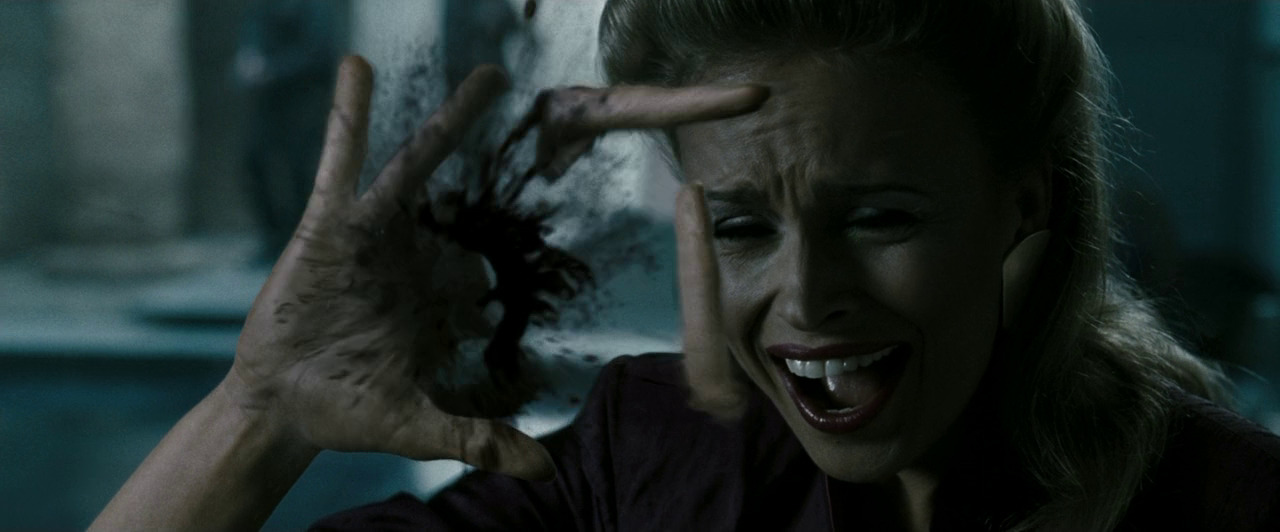
More to the point, however, one of the biggest changes Snyder makes to the tone of Moore and Gibbons’s comic is that he revels in the elaborate depiction of violence in a way Moore and Gibbons not only don’t, but that they actively avoid. This is most obvious in the sequence where Ozymandias is attacked by the fake assassin from issue #5, which under Snyder’s direction becomes a gore comedy in which Ozymandias’s secretary’s body is progressive dismantled in close-up in between businessmen’s heads exploding into bursts of red. But throughout the film Snyder both invents new sequences of violence out whole-cloth (Hollis Mason’s death scene outrageously gets blown up into a heroic last stand [albeit only in the extended editions of the film for home video], Mason rolling back the years and grinning as he decks knotheads until they finally get the better of him, while the Doctor Manhattan flashback at the Comedian’s funeral gets an added mini war movie complete with “Ride of the Valkyries” scoring) or wildly inflates existing ones (Night Owl and Silk Spectre get a lengthy corridor fight—a staple of Snyder’s direction—as they work their way through the prison, while Rorschach’s finger-breaking interrogation, a masterstroke of minimalism in Gibbons’s depiction, is staged as a fast cut of dramatic motion with sickening crunching noises). And Rorschach, as the most openly and routinely violent of the major characters, is the biggest beneficiary of this, routinely finding himself in lasciviously constructed shots of graphic carnage. (Jones, for his part, decries how the globalists are “training us to love seeing our fellow humans torn limb to limb,” which is ironic given that a decade later he’d be fantasizing on the air about eating his neighbors and how “I’m going to haul him up by a chain and chop his ass up. I’ll do it! My children aren’t going hungry! I’ll eat your ass! And that’s what I want the globalists to know: I will eat your ass first.”)
And yet for all that Jones catastrophically misreads the movie, there is a strange kernel of comprehension deep within the almost fractal latticework of his vast idiocy. After all, the fact remains that Jones’s default understanding of what Watchmen is was more or less correct, led astray only by Jones’s complete failure to meaningfully engage with reality. At one point in the course of his ramblings, after explaining how the globalists “believe they must reveal their plans to the public before they do it,” he fixates briefly on the numerological significance of the dates of various terrorist incidents, saying the globalists “are obsessed with numerology, just like low-level psychopaths are obsessed with numerology and the occult,” noting (bizarrely and falsely) that “most of these big national serial killer operations are done by cults” before asserting that “as the low level people engage in this, so do the high level; as above so below. And you have the occultists, the mason Alan Moore, in his novel The Watchmen [sic], the most celebrated graphic novel out there, admitting all of this.”

Improbably, out of a set of premises that can charitably be described as “not even wrong,” Alex Jones has arrived at a conclusion that contains a startling insight about Watchmen. Because, of course, this really is how Watchmen works. Moore and Gibbons’s constant use of repeated images—the blood splatter on the Comedian’s badge that repeats itself throughout the comic, as the smear in the snow of Ozymandias’s dome, the vaporizing shadow of the news vendor and the kid reading the Black Freighter comic, and finally the ketchup stain on Seymour’s shirt in the final panel—is straightforwardly an example of this logic of applying symbolism on multiple levels throughout a work. Moore also talks about something very much like this in a the use of the Black Freighter comic, talking about how “there’s even a bit where I think Adrian Veidt says at the end that he’s been ‘Troubled by dreams lately, of swimming towards—‘ and then he says, ‘No, it doesn’t matter, it’s not important’ and I mean it’s pretty obvious that he’s dreaming of swimming towards a great Black Freighter. Yeah, there’s a parallel there.” This really is how Watchmen works, and it is both logical and highly perceptive to infer that the logic might extend upwards still.
The reason that Jones is improbably capable of arriving at this vaguely accurate conclusion hinges on the peculiar nature of his approach to the world. Jones’s obsession with the idea that the New World Order is constantly releasing symbolic accounts of what they intend to do leads him to view the world as something that is in a fundamental sense controlled by media. To be clear, this is not the same as believing that the world is controlled by “the media,” although in practice Jones believes that too, but rather that media itself—the actual transmitted information—is a mechanism of control and power. In this regard, he is a surprisingly close cousin of William S. Burroughs, whose account of the cut-up method as a form of magic suggests that the manipulation of audio and its subsequent playback can achieve material effects. In fact, the name of Jones’s production company, InfoWars, is a neologism that could easily have come from Burroughs, while his frequent slogan “there’s a war on for your mind” has almost certainly been uttered word for word by a dorm room stoner attempting to explain Burroughs to a deeply unimpressed woman who is not going to date him.
Indeed, there exist passages of Burroughs that could plausibly pass as transcripts of an only slightly more unhinged than usual Alex Jones. Consider the climax of “The Invisible Generation,” where Burroughs, applying his cut-up methodology to an explanation of cut-ups, writes, “look around you look at a control machine programmed to select the ugliest stupidest most vulgar and degraded sounds for recording and playback which provokes uglier stupider more vulgar and degraded sounds to be recorded and play back inexorable degradation look forward to dead end look forward to ugly vulgar playback tomorrow and tomorrow and tomorrow what are newspapers doing but selecting the ugliest sounds for playback by and large if it’s ugly it’s news and if that isn’t enough i quote from the editorial page of the new york daily news we can take care of china and if russia interenes we can take care of that nation too the only good communist is a dead communist let’s take care of slave driver castro next what are we waiting for let’s bomb china now and let’s stay armed to the teeth for centuries this ugly vulgar bray put out for mass playback you want to spread hysteria record and play back the most stupid and hysterical reactions
marijuana marijuana why that’s deadlier than cocaine
it will turn a man into a homicidal maniac he said steadily his eyes cold as he thought of the vampires who suck riches from the vile traffic in pot quite literally swollen with human blood.” The crucial difference between them is that Jones, upon having Burroughs’s central revelation that the world is controlled by the manipulation of symbols that we call language, went on to ask the single stupidest question it is possible to ask about this: “well who’s in charge of all this then?” And in doing so, spun off not into visionary magical theory that would inspire generations of artists but into bland and racist conspiracy theories about the CIA pumping out warnings of its own plan to exterminate humanity via popular movies.
Of course, this faintly sympathetic reading of Jones’s comments would work a lot better if it were not framed as a review of Zack Snyder’s movie, which does exactly none of this. The theatrical cut that Jones saw omitted the Black Freighter comic entirely, but even the nearly four hour long cut that reinserts it does not use it to do anything like the elaborate parallelism of the comic. (Veidt’s line about his dreams is excised entirely.) Also gone is Veidt’s discussion of multiscreen viewing in terms of Burroughs, the cross-cutting complexity of Doctor Manhattan’s disastrous TV interview with Dan and Laurie’s alley fight (the two scenes cut back and forth, but with no real point or larger commentary). None of the complex storytelling techniques used in Watchmen are present in the movie, and as a result its thematic density is wildly reduced. The material from issue #4, for instance, is brutally cut down to where it provides an origin story for Doctor Manhattan and nothing more, with little larger sense of how he perceives time or what that might mean. Likewise, Laurie’s revelation about her parentage from issue #9 becomes a couple minute flashback that Doctor Manhattan puts into her head, with the reveal being given to Doctor Manhattan in dialogue to ensure there’s not a trace of agency for her involved in it.
For Snyder, Watchmen is interesting primarily as a well of opportunities for over the top violence or sex scenes. As he put it in an interview performed while the movie was in post-production, “I had a buddy who tried getting me into ‘normal’ comic books, but I was all like, ‘No one is having sex or killing each other. This isn’t really doing it for me.’ I was a little broken, that way. So when Watchmen came along, I was, ‘This is more my scene.’” Similarly, his account of how the movie’s sense of darkness works is jaw-dropping in its puerileness: “Everyone says that about [Christopher Nolan’s] Batman Begins. ‘Batman’s dark.’ I’m like, okay, ‘No, Batman’s cool.’ He gets to go to a Tibetan monastery and be trained by ninjas. Okay? I want to do that. But he doesn’t, like, get raped in prison. That could happen in my movie. If you want to talk about dark, that’s how that would go. I believe that pop culture is just, like, so ready for Watchmen. (Given all of this, it is no surprise that the film excises virtually all of the discussions of superheroes and sexuality, including Dan’s “so impotent” line, in favor of a lengthy out of costume sex scene between Dan and Laurie that is horrifyingly scored to Leonard Cohen’s “Hallelujah.”)
And so Jones is in practice faced with a film that has nothing to say beyond “look, tits and violence!” but that retains the basic plot and ending of a comic that is built as an intricate network of interrelated symbols configured so as to bring about a major and epochal change in the larger world. Given this situation, he did what Alex Jones can be safely counted on to do, which is to blather at a microphone for a prolonged period of time engaged in a free associative stream of conspiracy nonsense in which virtually every underlying fact is provably wrong. There is perhaps no greater testament to the sheer potency of the magic that Moore and Gibbons worked within Watchmen that the result of this cavalcade of cataclysmic non-understanding and catastrophic fuckups nevertheless expressed, at its core, a key understanding about exactly what Watchmen was.}

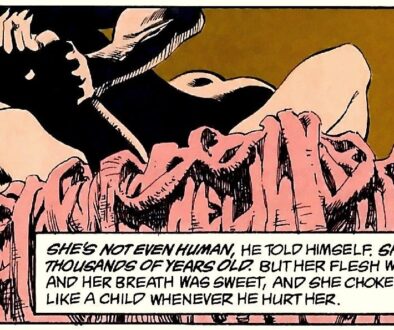
June 8, 2020 @ 11:14 am
“…But DC was a minor subsidiary of Warner Communications, who were on one front engaged in an extensive legal battle with Paramount to try to acquire Time, Inc., and on another in the leadup to the release of their tentpole Batman film with Jack Nicholson…”
…and is also the same corporate entity that has been actively suppressing the complete version of Ken Russell’s The Devils since 1973 on the grounds of the film’s “distasteful tonality.” The institutional desire to keep Russell’s cut of the film buried for nearly five decades might point to fear of offending conservative Christians.
(I imagine DC and/or Warners would also have been uneasy about putting Jesus in a comic book in 1989, in light of the backlash Universal Studios faced the previous year after releasing Martin Scorsese’s The Last Temptation of Christ.)
June 18, 2020 @ 5:09 am
Speaking of Universal, I also seem to recall at the time that one of the reasons given for the cancellation of Veitch’s story was that they were in negotiations with Universal at the time for the “Swamp Thing” TV show that debuted in 1990 on the USA Network and were worried the Jesus story would derail it.
Joseph Stefano (“Psycho,” “The Outer Limits”) developed the show and I recall him posting his frustrations with USA on the old CompuServe GO COMICS forum sometime in the early 90s. He wanted to do a hardboiled horror series with social commentary that was inspired by Moore’s run, and was well down that path with the first few scripts written, when the USA execs read them and basically said, “What is this? We thought you were making a COMIC BOOK show!” and forced huge changes.
June 9, 2020 @ 4:45 am
Meanwhile over at Marvel during the same time period: “Bah, who gives a shit about being literary? We don’t need any British guys to win us acclaim or money. We got Jim Lee. We got Todd Mcfarlane. We got ROB LIEFELD, BABY! And we can do gritty and extreme better than they can. We just need to make Spider-Man and X-Men books. The kids and our True Believer fans will eat it right up.”
June 11, 2020 @ 2:59 pm
For all the crap that Jim Shooter gets (much of it deserved), the comics Marvel produced under his tenure in the 1980s generally hold up a hell of a lot better than the ones Marvel churned out in the 1990s after Shooter was gone. Didn’t Shooter save Marvel (and lose friends) after industry tumult in the 1970s by cutting down on bloat? Cancelling poor-selling titles and scaling things back to ensure quality control? Then after he got pitched out, Marvel got seduced by the comics speculation boom and started swamping the market with new titles? Mutant books all over the place, 5-6 Spidey titles a month, Venom everywhere? Flashy “superstar” artists like McFarlane and Liefeld getting their own books and being allowed to draw and write despite not being able to write for toffee? Innumerable variant “#1” issues with die-cut holografix covers and collector’s card inserts? I’d be curious to know if Marvel made any genuine overtures to the Brit Pack during this time, but I suspect that wasn’t where the company’s priorities were.
June 12, 2020 @ 12:33 pm
Shooter’s a jerk it seems, but a jerk with some sense. The guys that replaced Shooter (and many of the guys before) were stupid jerks.
That’s pretty much my take on the matter.
June 13, 2020 @ 7:20 am
I’d be hard-pressed to disagree. Shooter was an asshole, but a necessary asshole.
I think Marvel’s belated attempts to go grim ‘n’ gritty had a great deal to do with why I turned away from the books circa the mid-1990s. Even when he was frequently a hard-luck superhero, Spider-Man was a good-natured guy – heck, for a time his books were marketed with the tagline “the non-gritty superhero!” But at some point in the 1990s, when Marvel was cynically exploiting cynical and violent anti-heroes, demons, terminator-like cyborgs etc, the decision was made to turn Peter Parker’s life to shit, send the poor guy off the deep end, and subject him to lousy “psychological” stories where he’d go on vengeance sprees while inner-monologuing guff like “PARKER IS DEAD. I AM THE SPIDER.” That kind of crap didn’t even qualify as second-rate Alan Moore copyism.
July 20, 2020 @ 7:42 pm
I think the interesting thing is that the guy who replaced Shooter – Tom DeFalco – seems to have generally been a nice guy (certainly compared to Shooter), and also his own inclinations in comic writing seem pretty classicist. Like, his most famous run is Spider-Girl, which is straight up Silver Age nostalgia.
The key was that, so far as I can tell, DeFalco didn’t really matter. He was chief catherder, not a tyrant the way Shooter was, and it was the editors below him who were making story decisions, the suits above him making business ones.
July 20, 2020 @ 7:52 pm
Like, Shooter had a vision of what his job was. He saw himself as the guardian of the intellectual property. And sometimes that meant he had to come down in a very heavy-handed way on the creatives who were messing with the characters too much.
He also had a very clear (and limited) vision of how stories are to be told. His vision mostly worked, with some obvious failures like Secret Wars II and the New Universe, but it was also a very conservative vision.
Like, a lot of the classic runs of the Shooter era (Simonson on Thor, Byrne on FF, Stern on Avengers) are extremely well-crafted comics, but they aren’t quite doing anything new with the medium – they’re “we can do Stan and Jack, but better!” And then below the top tier, you end up with a lot of comics that are sort of samey.
It makes sense that Marvel, as the industry leader, was aesthetically conservative, while DC was more willing to take risks and do interesting things.
But what you see after Shooter leaves is that the conservatism gets replaced by – no clear creative vision at all?
June 9, 2020 @ 8:48 am
I love all the Hellblazer mentioned here for different reasons, but Gaiman’s story is number one in my elaborate Canon of Loneliness. It’s the best evocation of the brutal loneliness I feel and how that longing for connection destroys people.
Constantine is a Craig Finn character in a John Darnielle world, using punk values and a bit of clairvoyance to beat dark forces.
The Batman & Robin movie picks up the Woodrue/Poison Ivy connection and makes him responsible for her and Bane.
Gerard Way was a mole in the War, contributing his (surprisingly decent) Desolation Row cover to the Watchmen movie, knowing that it would infuriate Moore & thus please his master Morrison, who symbolically kills him in the Killjoys videos.
Desolation Row, of course, tapping the same Burroughs well.
June 11, 2020 @ 2:29 am
I don’t have much to add to the discussion, but I’m happy to see that posts on The Last War are back!
I was recently re-reading Sandman and some of Gaiman’s other related DC work like Books of Magic. The first time I read Sandman was before I’d ever read most of Moore’s work. It amazes me how much of Swamp Thing I can see in Gaiman’s Sandman and Books of Magic now that I’m more familiar with Moore.
It’s been so long since I read Veitch’s Swamp Thing or Delano’s Hellblazer that I had to struggle to remember precisely what was going on in those books where they intersected with Sandman too. I wish I’d read this post a few weeks ago before I started re-reading Sandman!
Anyway, that’s not that relevant to what’s going on here. Again, I just wanted to say it’s great to have posts on The Last War back!
June 14, 2020 @ 6:03 pm
I remember reading a piece at the time that part of Jenette Kahn’s reason for stopping the Jesus story was that she was afraid of anti-Semitism. Karen Berger, Paul Levitz and Kahn are all Jewish and apparently there was a fear that publishing the story would be interpreted as Jews (DC) trashing Jesus. To be honest, I can see why this could have been a worry. The Christian right was pretty nasty at the time (in the UK they were a big part of section 28 which feeds into the war through the establishment of Madlove) and I could understand a media executive being reticent to publish anything that could antagonise them. Of course self censorship is often more restrictive than outside censorship which brings us back to Alan Moore’s reason for leaving DC.
July 8, 2020 @ 5:47 pm
“Delano’s Hellblazer would be diminished if it were as ostentatious and insistent on having its genius recognized as Moore’s best work. It works because it is present, immediate, and furious, not because it is seized with mad ambition. And more to the point, it works because this suits John Constantine, who, in Delano’s conception at least, is not a figure of grandiose and well-worked plans.”
““Hold Me” is a comic that one can present to someone and have them immediately see its virtues.”
I really love the structure of this chapter, the intercutting between Hellblazer and Swamp Thing, between Delano and Veitch. This period of these comics hit the sweet spot of my memories, studying illustration and basking in the angry scratchiness (in terms of plot and drawing style) of Hellblazer, (and later the beauty of art by Piers Rayner and Mark Buckingham); and the bright and sensual art of Veitch and Alcala. Even though Delano’s run doesn’t narratively hold up, I have a lot of affection for it.
I hadn’t known about the proposed story idea by Veitch for Swamp Thing #88 – sounds truly fascinating and I feel genuinely sad to have missed it.
“Hold Me” I think is a real masterpiece, and underrated piece of work by Gaiman, and great to see another side of McKean’s work – I love the weaving of empathy into a horror tale too. Great stuff, thanks El.
August 12, 2020 @ 11:52 am
I am amazed by the way you have explained things in this article. This article is quite interesting and I am looking forward to reading more of your posts. Thanks for sharing this article with us.
September 14, 2021 @ 1:14 am
Correction: DC has collected the last issues of the Delano run in trade. It’s in the Dangerous Habits volume (though not in its original printing). I’m fairly sure every issue of Hellblazer has been collected at this point.
March 20, 2025 @ 3:49 pm
Seeing Alex Jones AND ZackSnyder! mentioned in the same segment is a kind of dark magic I’m not sure anybody wants to be summoning.
Not even Alan Moore or Grant Morrison….